

THE APPRECIATION OF MUSIC
VOL. I.
THE APPRECIATION OF MUSIC CLOTH $1.50
By Thomas Whitney Surette and Daniel Gregory Mason
SUPPLEMENTARY VOLUME OF MUSICAL ILLUSTRATIONS $1.00
VOL. II.
GREAT MODERN COMPOSERS CLOTH $1.50
By Daniel Gregory Mason
VOL. III.
SHORT STUDIES IN GREAT MASTERPIECES
By Daniel Gregory Mason
OTHER WORKS
BY
DANIEL GREGORY MASON
A GUIDE TO MUSIC. A BOOK FOR BEGINNERS CLOTH $1.25
ORCHESTRAL INSTRUMENTS AND WHAT THEY DO,
WITH TWENTY-SEVEN ILLUSTRATIONS AND
ORCHESTRAL CHART CLOTH $1.25
VOLUME I
BY
THOMAS WHITNEY SURETTE
AND
DANIEL GREGORY MASON
NINTH EDITION
Supplementary Volume of Musical Illustrations
Price $1.00
NEW YORK
THE H. W. GRAY CO.
SOLE AGENTS FOR
NOVELLO & CO., LTD.
COPYRIGHT, 1907, BY
THE H. W. GRAY COMPANY
The Knickerbocker Press, New York
PREFATORY NOTE.
This book has been prepared in order to provide readers who wish to listen to music intelligently, yet without going into technicalities, with a simple and practical guide to musical appreciation written from the listener's rather than from the professional musician's standpoint.
The authors believe that there is at the present moment a genuine need for such a book. Teachers in schools, colleges, and universities, educators in all parts of the country, and the music-loving public generally, are every day realizing more vividly the importance of applying to music the kind of study which has long been fruitfully pursued in the other arts; and with the adoption, in 1906, by the College Entrance Examination Board, of musical appreciation as a subject which may be offered for entrance to college, this mode of studying music has established itself firmly in our educational system. Yet its progress is still hampered by the lack of suitable text-books. The existing books are for the most part either too technical to be easily followed by the general reader, or so rhapsodical and impressionistic as to be of no use to him.
In the following pages an effort has been made, first, to present to the reader in clear and untechnical language [iv] an account of the evolution of musical art from the primitive folk-song up to the symphony of Beethoven; second, to illustrate all the steps of this evolution by carefully chosen musical examples, in the form of short quotations in the text and of complete pieces printed in a supplement; third, to facilitate the study of these examples by means of detailed analysis, measure by measure, in many cases put into the shape of tabular views; and fourth, to mark out the lines of further study by suggesting collateral reading.
Too much stress cannot be laid on the fact that the music itself is the central point of the scheme of study, to which the reader must return over and over again. Carefully attentive, concentrated listening to the typical pieces presented in the supplement is the essence of the work, to which the reading of the text is to be considered merely as an aid. These pieces are for the most part not beyond the reach of a pianist of moderate ability.
At the same time, the authors have realized that some readers who might profit much by such study will not be able to play, or have played for them, even these pieces. For them, however, the music will still be accessible through mechanical instruments.
In view of the fact that one of the chief difficulties in the study of musical appreciation is the unfamiliarity of classical music to the ordinary student, the use of an instrument by the students themselves should form an important part of the work in classes where this book is used as a [v] text-book. It is hoped that with such practical laboratory work by all members of the class, and with the help of collateral reading done outside the class under the direction of the teacher, and tested by written papers on assigned topics, the course of study outlined here will be found well-suited to the needs of schools and colleges, as well as of general readers.
CONTENTS.
| CHAPTER I. | ||
| PAGE | ||
| ELEMENTS OF MUSICAL FORM. | 1 | |
| I. | INTRODUCTORY | 1 |
| II. | WHAT TO NOTICE FIRST | 3 |
| III. | MUSICAL MOTIVES | 4 |
| IV. | WHAT THE COMPOSER DOES WITH HIS MOTIVES | 6 |
| V. | THE FIRST STEPS AS REVEALED BY HISTORY | 10 |
| VI. | A SPANISH FOLK-SONG | 12 |
| VII. | BALANCE OF PHRASES | 13 |
| VIII. | SUMMARY | 14 |
| CHAPTER II. | ||
| FOLK-SONGS. | 16 | |
| I. | FOLK-SONGS AND ART SONGS | 17 |
| II. | AN ENGLISH FOLK-SONG | 20 |
| III. | KEY AND MODULATION | 21 |
| IV. | BARBARA ALLEN | 22 |
| V. | NATIONAL CHARACTERISTICS IN FOLK-SONGS | 25 |
| VI. | AN IRISH FOLK-SONG | 26 |
| VII. | A GERMAN FOLK-SONG | 28 |
| VIII. | SUMMARY | 30 |
| CHAPTER III. | ||
| THE POLYPHONIC MUSIC OF BACH. | 31 | |
| I. | WHAT IS POLYPHONY | 32 |
| II. | AN INVENTION BY BACH | 33 |
| EXAMPLE FOR ANALYSIS, No. 1. | ||
| Bach: Two-voice, Invention. No, VIII, in F-major | 34 | |
| III. | A FUGUE BY BACH | 37 |
| EXAMPLE FOR ANALYSIS, No. 2. | ||
| |
Bach: Fugue No. 2, in C-minor, in three voices. "Well-tempered Clavichord," Book I |
38 |
| IV. | GENERAL QUALITIES OF BACH'S WORK | 43 |
| CHAPTER IV. | ||
| THE DANCE AND ITS DEVELOPMENT. | 48 | |
| I. | MUSICAL CHARACTER OF DANCES | 48 |
| II. | PRIMITIVE DANCES | 52 |
| EXAMPLE FOR ANALYSIS, No. 3. | ||
| Corelli: Gavotte in F-major | 56 | |
| III. | A BACH GAVOTTE | 57 |
| EXAMPLE FOR ANALYSIS, No. 4. | ||
| Bach: Gavotte in D-minor, from the Sixth English Suite | 57 | |
| CHAPTER V. | ||
| THE SUITE. | 62 | |
| I. | DERIVATION OF THE SUITE | 62 |
| II. | THE SUITES OF BACH | 65 |
| EXAMPLE FOR ANALYSIS, No. 5. | ||
| Bach: Prelude to English Suite, No. 3, in G-minor | 65 | |
| EXAMPLE FOR ANALYSIS, No. 6. | ||
| Bach: Sarabande in A-minor, from English Suite, No. 2 | 68 | |
| EXAMPLE FOR ANALYSIS, No. 7. | ||
| Bach: Gigue, from French Suite, No. 4, in E-flat | 71 | |
| III. | THE HISTORIC IMPORTANCE OF THE SUITE | 72 |
| CHAPTER VI. | ||
| THE RONDO. | 74 | |
| I. | DERIVATION OF THE RONDO | 75 |
| II. | A RONDO BY COUPERIN | 79 |
| EXAMPLE FOR ANALYSIS, No. 8. | ||
| Couperin: "Les Moissonneurs" ("The Harvesters") | 80 | |
| III. | FROM COUPERIN TO MOZART | 83 |
| IV. | A RONDO BY MOZART | 86 |
| EXAMPLE FOR ANALYSIS, No. 9. | ||
| Mozart: Rondo from Piano Sonata in B-flat major | 87 | |
| CHAPTER VII. | ||
| THE VARIATION FORM—THE MINUET. | 93 | |
| I. | VARIATIONS BY JOHN BULL | 94 |
| II. | A GAVOTTE AND VARIATIONS BY RAMEAU | 97 |
| III. | HANDEL'S "HARMONIOUS BLACKSMITH" | 100 |
| EXAMPLE FOR ANALYSIS, No. 10. | ||
| Handel: "The Harmonious Blacksmith," from the Fifth Suite for Clavichord | 101 | |
| IV. | HAYDN'S ANDANTE WITH VARIATIONS, IN F-MINOR | 103 |
| EXAMPLE FOR ANALYSIS, No. 11. | ||
| Haydn: Andante with Variations, in F-minor | 104 | |
| V. | THE MINUET | 108 |
| CHAPTER VIII. | ||
| SONATA-FORM, I. | 110 | |
| I. | COMPOSITE NATURE OF THE SONATA | 110 |
| II. | ESSENTIALS OF SONATA-FORM | 111 |
| III. | A SONATA BY PHILIP EMANUEL BACH | 114 |
| EXAMPLE FOR ANALYSIS, No. 12. | ||
| Philip Emanuel Bach: Piano Sonata in F-minor, first movement | 115 | |
| IV. | HARMONY AS A PART OF DESIGN | 125 |
| V. | SUMMARY | 126 |
| CHAPTER IX. | ||
| SONATA-FORM, II. | 128 | |
| I. | HAYDN AND THE SONATA-FORM | 128 |
| EXAMPLE FOR ANALYSIS, No. 13. | ||
| Haydn: "Surprise Symphony," first movement | 131 | |
| II. | MOZART AND THE SONATA-FORM | 134 |
| EXAMPLE FOR ANALYSIS, No. 14. | ||
| Mozart: Symphony in G-minor, first movement | 136 | |
| III. | MOZART'S ARTISTIC SKILL | 138 |
| CHAPTER X. | ||
| THE SLOW MOVEMENT. | 143 | |
| I. | VARIETIES OF FORM | 143 |
| II. | SLOW MOVEMENTS OF PIANO SONATAS | 145 |
| III. | THE STRING QUARTET | 148 |
| EXAMPLE FOR ANALYSIS, No. 15. | ||
| |
Haydn: Adagio in E-flat major, from the String Quartet in G-major, op. 77, No. 1 |
149 |
| IV. | GENERAL CHARACTERISTICS | 151 |
| V. | FORM OF HAYDN'S ADAGIO | 152 |
| VI. | MOZART AND THE CLASSIC STYLE | 153 |
| EXAMPLE FOR ANALYSIS, No. 16. | ||
| Mozart: Andante from String Quartet in C-major | 156 | |
| VII. | FORM OF MOZART'S ANDANTE | 159 |
| CHAPTER XI. | ||
| BEETHOVEN—I. | 161 | |
| I. | GENERAL CHARACTER OF BEETHOVEN'S WORK | 161 |
| II. | ANALYSIS OF A BEETHOVEN SONATA | 166 |
| EXAMPLE FOR ANALYSIS, No. 17. | ||
| Beethoven: Path?ique Sonata, first movement | 166 | |
| EXAMPLE FOR ANALYSIS, No. 18. | ||
| Beethoven: Path?ique Sonata, second movement | 170 | |
| EXAMPLE FOR ANALYSIS, No. 19. | ||
| Beethoven: Path?ique Sonata, third movement | 171 | |
| III. | SUMMARY | 174 |
| CHAPTER XII. | ||
| BEETHOVEN—II. | 176 | |
| I. | FORM AND CONTENT | 176 |
| II. | BEETHOVEN'S STYLE | 178 |
| EXAMPLE FOR ANALYSIS, No. 20. | ||
| Beethoven: The Fifth Symphony, first movement | 181 | |
| III. | THE DRAMATIC ELEMENT IN BEETHOVEN'S MUSIC | 185 |
| IV. | THE SIGNIFICANCE OF THE FIRST MOVEMENT OF THE FIFTH SYMPHONY | 187 |
| CHAPTER XIII. | ||
| BEETHOVEN—III. | 191 | |
| I. THE SLOW MOVEMENT BEFORE BEETHOVEN | 191 | |
| II. | THE SLOW MOVEMENTS OF BEETHOVEN'S EARLY SYMPHONIES | 192 |
| EXAMPLE FOR ANALYSIS, No. 21. | ||
| Beethoven: The Fifth Symphony. Slow movement | 195 | |
| III. | INDIVIDUALITY OF THE ANDANTE OF THE FIFTH SYMPHONY | 198 |
| IV. | THE HARMONIC PLAN | 201 |
| V. | THE UNIVERSALITY OF BEETHOVEN'S GENIUS | 203 |
| CHAPTER XIV. | ||
| BEETHOVEN—IV. | 205 | |
| I. | BEETHOVEN'S HUMOR | 205 |
| II. | SCHERZOS FROM BEETHOVEN'S SONATAS | 209 |
| EXAMPLE FOR ANALYSIS, No. 22. | ||
| Beethoven: Scherzo from the Twelfth Sonata | 209 | |
| EXAMPLE FOR ANALYSIS, No. 23. | ||
| Beethoven: Scherzo from the Fifteenth Sonata | 210 | |
| III. | THE SCHERZOS OF BEETHOVEN'S SYMPHONIES | 211 |
| EXAMPLE FOR ANALYSIS, No. 24. | ||
| Beethoven: Scherzo from the Fifth Symphony | 218 | |
| IV. | GENERAL SUMMARY | 221 |
THE APPRECIATION OF MUSIC
Of the thousands of people who consider themselves lovers of music, it is surprising how few have any real appreciation of it. It is safe to say that out of any score of persons gathered to hear music, whether it be hymn, song, oratorio, opera, or symphony, ten are not listening at all, but are looking at the others, or at the performers, or at the scenery or programme, or are lost in their own thoughts. Five more are basking in the sound as a dog basks in the sun—enjoying it in a sleepy, languid way, but not actively following it at all. For them music is, as a noted critic has said, "a drowsy reverie, relieved by nervous thrills." Then there are one or two to whom the music is bringing pictures or stories: visions of trees, cascades, mountains, and rivers fill their minds, or they dream of princesses in old castles, set free from magic slumber by brave heroes from afar. Perhaps also there is one who takes a merely scientific interest in the music: he is so busy analysing themes and labelling motives that he forgets to enjoy. Only two out of the twenty are left, then, who are actively following the melodies, living over again the thoughts of the composer, really appreciating, by vigorous and delightful attention, the beauties of the music itself.
Can we not, you and I, join the ranks of these true lovers of music? Can we not learn to free our minds of all side issues as we listen—to forget audience, performers, and scene, to forget princesses and heroes, to forget everything except this unique experience that is unfolding itself before our ears? Can we not, arousing ourselves from our drowsy reverie, follow with active co-operation and vivid pleasure each tone and phrase of the music, for itself alone?
One thing is sure: Unless we can do so, we shall miss the keenest enjoyment that music has to offer. For this enjoyment is not passive, but active. It is not enough to place ourselves in a room where music is going on; we must by concentrated attention; absorb and mentally digest it. Without the help of the alert mind, the ear can no more hear than the eye can see. Sir Isaac Newton, asked how he had made his wonderful discoveries, answered, "By intending my mind." In no other way can the lover of music penetrate its mysteries.
Knowledge of musical technicalities, on the other hand, is not necessary to appreciation, any more than knowledge of the nature of pigments or the laws of perspective is necessary to the appreciation of a picture. Such technical knowledge we may dispense with, if only we are willing to work for our musical pleasure by giving active attention, and if we have some guidance as to what to listen for among so many and such at first confusing impressions. Such guidance to awakened attention, such untechnical direction what to listen for, it is the object of this book to give.
It is no wonder, when one stops to think of it, that music, in spite of its deeply stirring effect upon us, often defeats our best efforts to understand what it is all about, and leaves us after it is over with the uncomfortable sense that we have had only a momentary pleasure, and can take nothing definite away with us. It is as if we had been present at some important event, without having the least idea why it was important, or what was its real meaning. All of us, at one time or another, must have had this experience. And, indeed, how could it be otherwise? Music gives us nothing that we can see with our eyes or touch with our hands. It does not even give our ears definite words that we can follow and understand. It offers us only sounds, soft or loud, long or short, high or low, that flow on inexorably, and that too often come to an end without leaving any tangible impressions behind them. No wonder we are often bewildered by an experience so peculiar and so fleeting.
Yet these sounds, subtle as they are, have a sense, a logic, an order of their own; and if we can only learn how to approach them, we can get at this inner orderliness that makes them into "music." The process of perception which we have to learn here is somewhat akin to certain more familiar processes. For example, what comes to our eyes from the outer world is simply a mass of impressions of differently colored and shaped spots of light; only gradually, as we grow out of infancy, do we learn that one group of these spots of light shows us "a house," another "a tree," [4] and so on. Similarly words, as we easily realize in the case of a foreign language, are to the untrained ear mere isolated sounds of one kind or another; only with practice do we learn to connect groups of them into intelligible sentences. So it is with music. The sounds are at first mere sounds, separate, fragmentary, unrelated. Only after we have learned to group them into definite melodies, as we group spots of lights into houses or trees, and words into sentences, do they become music for us. To approach sounds in such a way as to "make sense" of them—that is the art of listening to music.
The first step in making sense of any unfamiliar thing is to get quite clearly in mind its central subject or subjects, as, for example, the fundamental idea of a poem, the main contention of an essay, the characters of a novel, the text of a sermon. All music worthy of the name has its own kind of subjects; and if we can learn to take note of, remember, and recognize them, we shall be well on the road to understanding what at first seems so intangible and bewildering.
A possible confusion, due to the use of terms, must here be guarded against. The word "subject" is used in a special sense, in music, to mean an entire theme or melody, of many measures' duration—thus we speak of "the first subject of Beethoven's Fifth Symphony," meaning the entire contents of measures 6-21. Now this is obviously a different meaning of the word "subject" from the general one we use when we speak of the subject of a poem or a [5] picture, as the fundamental idea about which it all centers. This long musical "subject" all centers about a little idea of four notes, announced in the first two measures of the symphony:

But as we are already using the word "subject" to mean something else, we must have another name for this brief characteristic bit out of which so much is made, and for this the word "motive" is used. Here again there is a difference of usage which must be noted. When we speak of a "motive" or "leading motive" of Wagner, we mean not a short group of this kind, but an entire melody associated with some special character or idea; e. g., "the Siegfried motive." Let us here, however, keep the word "motive" to mean a short characteristic group of tones or "figure," and the word "subject" to mean a complete melody or theme built up out of one or more motives.
The smallest elements into which we can analyze the subject-matter of music are "motives"—that is, bits of tune, groups of from two to a dozen tones, which have an individuality of their own, so that one of them cannot possibly be confused with another.
"Yankee Doodle," for instance, begins with a motive of seven notes, which is quite individual, and wholly different from the motive of six notes at the beginning of "God Save the King," or the motive of five notes at the beginning of the "Blue Danube" waltz. The three motives are so different that nobody of ordinary musical intelligence would confound [6] them one with another, any more than he would confound the subject of Longfellow's "Psalm of Life" with that of Browning's "Incident of the French Camp," or the characters in "Dombey and Son" with those in "Tom Jones." The whole musical individuality of each of the three tunes grows out of the individuality of its special motive.
Here, evidently, is a matter of primary importance to the would-be intelligent music lover. If he can learn to distinguish with certainty whatever "motives" he hears, half the battle is already gained.
Four points will be noticeable in any motive he may hear. Its notes will vary as to (1) length, (2) accent, (3) meter or grouping into regular measures of two, three, or four notes, and (4) pitch. If he can once form the habit of noticing them, he will have no further difficulty in recognizing the themes of any music, and, what is even more important, following the various evolutions through which they pass as the composer works out his ideas. The importance of such active participation in the composer's thought cannot be exaggerated. Without it there cannot be any true appreciation of music; through it alone does the listener emerge from "drowsy reverie, relieved by nervous thrills" into the clear daylight of genuine artistic enjoyment.
Let us put ourselves now in the place of a composer who has thought of certain motives, and who wishes to make them into a complete piece of music. What shall we [7] do next with these scraps of melody, attractive but fragmentary? Now, one thing we can see at once from our knowledge of arts other than music. We must somehow or other keep repeating our central ideas, or our piece will wander off into mazes and fail to have any unity or intelligibility; yet we must also vary these repetitions, or they will become monotonous, and the finished piece will have no variety or sustained interest. The poet must keep harking back to the main theme of his poem, or it will degenerate into an incoherent rhapsody; but he must present new phases of the root idea, or he will simply repeat himself and bore his readers. The architect, having chosen a certain kind of column, say, for his building, must not place next to it another style of column, from a different country and period, or his building will become a mess, a medley, a nightmare; but neither must he make his entire building one long colonnade of exactly similar columns, for then it would be hopelessly dull. In short, every artist has to solve in his own way the problem of combining unity of general impression with variety of detail. Without either one of these essentials, no art can be beautiful.
Here we are, then, with our motive and with the problem before us of repeating it with modifications sufficient to lend it a new interest, but not radical enough to hide its identity.
If we are making our music for several voices or instruments, or for several parts all played on one instrument like the organ or the piano, we can let these different voices or parts sound the motive in succession. If, while [8] the new voice takes the motive, the voice previously brought in goes on with something new, then we shall have a very agreeable mingling of unity and variety. This is the method used in all canons, fugues, inventions, and so on, and in vocal rounds. For an example, take the round called "Three Blind Mice" (see Figure I).
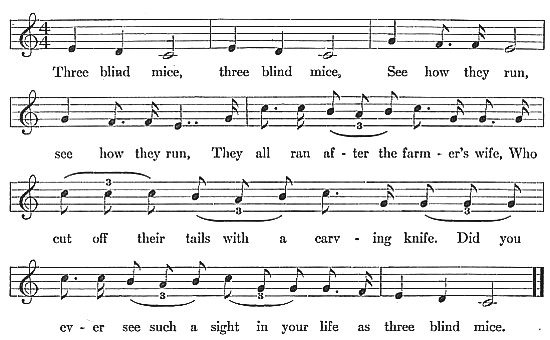
FIGURE I. "THREE BLIND MICE."
Three blind mice, three blind mice, See how they run,
see how they run, They all ran af - ter the farm - er's wife, Who
cut off their tails with a carv - ing knife. Did you
ev - er see such a sight in your life as three blind mice.
One person, A, begins this melody alone, and sings it through. When he has reached the third measure, B strikes in at the beginning. When B in his turn has reached the third measure (A being now at the fifth), C comes in in the same way. In a word, the three people sing the same tune in rotation (whence the name, "round"). And the tune, of course, is so contrived that all its different sections, sounded simultaneously by the various voices, [9] merge in harmony. This kind of literal repetition by one part of what another has just done is called "imitation," and is a fundamental principle of all that great department of music known as the "polyphonic," or many-voiced.
But now, notice another kind of repetition in this little tune. Measures 3 and 4 practically repeat, though at a different place in the scale, the three-note motive of measures 1 and 2. (In order to conform to the words, the second note is now divided into two, but this is an unimportant alteration.) The naturalness of this kind of repetition is obvious. Having begun with our motive in one place, it easily occurs to us to go on by repeating it, in the same voice, but higher or lower in pitch than at first. The mere fact that it is higher or lower gives it the agreeable novelty we desire, yet it remains perfectly recognizable. We may call this sort of repetition, which, like "imitation," is of the greatest utility to the composer, "transposition," to indicate that the motive is shifted to a new place or pitch.
But suppose we do not wish either to imitate or to transpose our motive, is there any other way in which we can effectively repeat it? Yes:—we can follow its first appearance with something else, entirely different, and after this interval of contrast, come back again and restate our motive just as it was at first. Looking at "Three Blind Mice" again, we see that this device, as well as the other two, is used there. After the fifth, sixth, and seventh measures, which contain the contrast, the eighth measure returns literally to the original motive of three notes, thus rounding [10] out and completing the tune. This third kind of repetition, which may be called "restatement after contrast," or simply "restatement," is also widely in use in all kinds of music. A most familiar instance occurs in "Way Down upon the Suwanee River."
Let us keep distinctly in mind, in all our study, these three modes of repetition, which are of radical importance to musical design: 1st, the imitation of a motive in a different "voice" or "part"; 2d, the transposition of a motive, in the same voice, to a higher or lower place in the scale; 3d, the restatement of a motive already once stated, after an intervening contrast. We shall constantly see these kinds of repetition—imitation, transposition, and restatement—used by the great composers to give their music that unity in variety, that variety in unity, without which music can be neither intelligible nor beautiful.
It must not be thought that these ways of varying musical motives without destroying their identity were quickly found out by musicians. On the contrary, it took centuries, literally centuries, to discover these devices that seem to us so simple. All savage races are musically like children; they cannot keep more than one or two short bits of tune in mind at the same time, and these they simply repeat monotonously. The first two examples in Figure II, taken from Sir Hubert Parry's "The Evolution of the Art of Music," give an idea of the first stage of the savage musician.

1.

2.

3.

4.
FIGURE II. TUNES OF PRIMITIVE SAVAGES.
The first is from Australia, the second from Tongataboo. Both are made of a single motive endlessly repeated without relief.
In a slightly higher stage, two motives are used, but with little more skill. Number 3, in Figure II, is an example. Then come tunes in which one or more motives, repeated literally, are still the main feature of the design, but in which a certain amount of variety is introduced between the repetitions (see Number 4, in Figure II, a Russian tune). Here the little characteristic figure of four short notes and a long, marked N.B., is agreeably relieved by other material.
From such primitive music as this to the beautiful "folk-song" of the modern nations is a long step indeed. Even in the simplest real folk-songs, the means of varied repetition of ideas that we have been discussing are used with an ingenuity which places them on an infinitely higher level than these primitive efforts of savages. It is true that in folk-songs, which were sung by a single voice instead of a group of voices, the device of "imitation" was used hardly at all:—that is available only where there are several different voices to imitate one another. But in order to see what good use was made of "transposition" and "restatement" we need take only a single example, from Galicia in Spain (see Figure III). Let us examine this tune in some detail, as a preparation for a further study of folk-songs in a later article.
From Galicia in Spain.

FIGURE III. FOLK-SONG.
The tune, in spite of its impression of considerable variety, is founded entirely on two motives—


In the sixth and seventh measures, (1) is so altered and transposed that it ends on D instead of on C, and in the eighth, ninth, and tenth measures (2) is transposed so as to end on G instead of on C. By these transpositions the important element of contrast is introduced, and when therefore we have, at the end, the two motives given again almost exactly as to first, we get, by this restatement after contrast, a delightful sense of unity and completeness. The means here are wonderfully simple, but the effect is truly artistic.
An important principle of musical design is introduced to our notice by this little melody. It will be observed that it divides itself into three equal parts: the statement, measures 1-5; the contrast, measures 6-10; and the restatement, measures 11-15. (We may represent these by the letters A, B, and A.) Now these three parts, being of equal length and similar material, balance each other just as lines in poetry do. One makes us expect another, which, when it comes, fulfills our expectation. Thus we get the impression of regularity, order, symmetry. This element of symmetry, or the balancing of one phrase of melody by another, like the balancing of one line of poetry by another, as in the verses
"The lowing herd winds slowly o'er the lea,
And leaves the world to darkness and to me."
is a most important one, as we shall soon see, in all modern music.
This balance of one large section of a melody by another is often referred to by the term "rhythm," owing to its analogy with "rhythm" in architecture (in the symmetry, for example, of two halves of a building). But it is simpler to keep the word rhythm, in music, to mean rather a characteristic combination of tones, as regards their relative length and accent, as, "the rhythm of the first motive in Beethoven's Fifth Symphony" (see motive quoted on page 5). In the present articles the word will be used in this latter sense.
In this chapter we have seen how music, in spite of its subtle, intangible nature, has certain definite features called "motives," which we can learn to recognize and follow by noticing the length, accent, metrical arrangement, and movement "up" or "down," of the tones of which they are composed.
We have seen that these primary motives are worked up into complete pieces of music by being repeated with such alterations as serve to vary them pleasantly without disguising them beyond recognition. The chief kinds of modified repetition we have noticed are "imitation," "transposition," and "restatement after contrast." All of these we have seen illustrated in "Three Blind Mice."
We have remarked how very gradually musicians got away from monotonous harping on their ideas by using these [15] devices. In connection with the Spanish folk-song, we have noted that, although imitation was not available, transposition and restatement were most effectively used.
Finally, we have seen that music, like poetry, has its larger balance of phrases, by which whole parts of a melody are set off against one another and made to balance, just as lines do in verse.
In succeeding chapters we shall trace out all these principles in more detail.
SUGGESTIONS FOR COLLATERAL READING.
Parry: "The Evolution of the Art of Music," Chapters I and II; Dickinson: "The Study of the History of Music," Chapter I; Grove: "Dictionary of Music and Musicians," article "Form."
In the first chapter we have traced the evolution of the formal element in music, the element through which it gradually attained coherence. We have seen that this element is an expression of that common sense which rules in all things; that the various expedients adopted in music as means of keeping the central idea before the listener, and, at the same time, providing him with sufficient variety to retain his interest, are dictated by that sense of fitness that operates everywhere in life. And these simple formal principles, so conceived, will be found to underlie the larger musical forms that will engage our attention in succeeding chapters.
Let us always keep in mind that, while the psychological effect of music remains a considerable mystery, and the appreciation of great music must be a personal and individual act involving a certain receptivity and sensitiveness to musical impressions, yet the perception of the logic or sense in a piece of music is a long step towards understanding it, and one of the best means of cultivating that receptivity and sensitiveness.
Folk-songs have been described by an eminent writer[1] as "the first essays made by man in distributing his notes [17] so as to express his feelings in terms of design." We shall shortly examine some typical folk-songs in order to see how this design gradually became larger and more various, and how, through this process, the foundations were laid for the masterpieces of modern instrumental music. We shall see that this advance has accompanied an advance in civilization; that as men's lives have become better ordered, as higher standards of living and thinking have appeared, the sense of beauty has grown until, finally, this steady progress has resulted in the creation of certain permanent types. It must be kept in mind, however, that these primitive types are largely the result of instinctive effort, and not of conscious musical knowledge. The science of music, as we know it, did not exist when these songs were written.
In order to distinguish between Folk-songs and songs like those of Schubert and Schumann, musicians call the latter "Art" songs. The folk-song is a na?e product, springing almost unconsciously from the hearts of simple people, and not intended to convey any such definite expression of the meaning of the words as is conveyed in modern songs. While there are specimens[2] of the art song that closely approach the simplicity and beauty of the folk-song, the art song in general is not only of wider range and of wider application to men's thoughts and feelings, but it also has, as an integral part of it, an accompaniment of which the folk-song, in its pure state, is entirely devoid.
A further distinguishing characteristic of the folk-song is that it is often composed in one of the old ecclesiastical "modes."
These modes were old forms of the scale that existed before our modern harmonic system came into use. The following English folk-song, called "Salisbury Plain," is in the "Aeolian" mode.
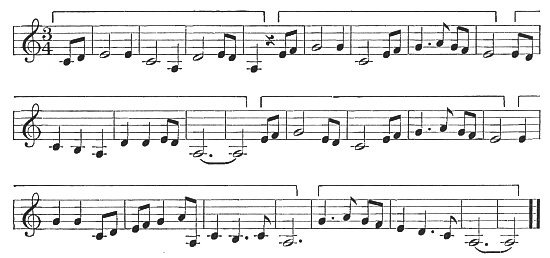
FIGURE IV.
This song is written in the scale represented by the white keys of a pianoforte beginning on A, and the peculiarly quaint effect of it is due to the unusual intervals of that scale as compared with our common scale forms. There are various modes[3] called "Phrygian," "Dorian," etc., each having its own peculiar quality. This quaintness and characteristic quality to be observed in modal folk-songs almost entirely disappears when an accompaniment of modern harmony is added, as is often done.
Folk-songs occupied a much more important place in the lives of the people who used them than is commonly supposed. When we consider that at the time the earliest of them were written few people could read or write, that books were printed in Latin, and that there were no newspapers, railways, or telegraphs, we can understand how large a part these old songs played in the scheme of life. The strolling singer was the newspaper of the time. Furthermore, the general illiteracy of the people made of the folk-song a natural vent for their feelings. With a limited vocabulary at their disposal, it was natural that they should use the song as a medium of expression for their joys and sorrows. Gesture was also part of their language, and in a modified way, as a means of expression, may be said to have performed something of the function of song. Many of the oldest melodies existed as an adjunct to dancing and religious ceremonials, and were, therefore, to some extent utilitarian. But so intimate was their relation to the ideas and feelings of the people who used them that, in spite of the crudeness and simplicity of the medium employed, the songs of the various nations are entirely distinct from each other, and to a remarkable degree express the characteristics of the people who produced them.
The songs used with this chapter are chosen chiefly to illustrate the various methods (already described) of attaining variety and unity in music. If little space is devoted here to other considerations, the reader must bear in mind that our purpose is to lead him finally to as complete an appreciation as possible of the masterpieces of instrumental [20] music, and that this appreciation must begin with a perception of the relationships between the various parts of a primitive piece of music.
In Figure V is shown the old English song "Polly Oliver."[4]
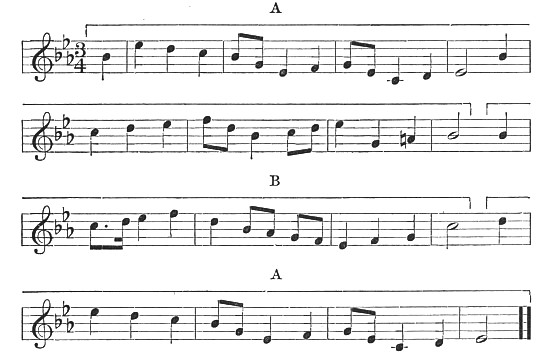
FIGURE V.
This is a traditional song handed down without any record of its origin, from generation to generation. Its unknown composer has managed very deftly to make it hang together. A good deal is made, in particular, of the characteristic little motive of three notes which first occurs at the beginning of the third measure.[5] In the very next measure, the fourth, this is "transposed" to a lower position. Going on, we find it coming in again, most effectively, [21] in measure 7, this time transposed upwards; and it occurs again twice at the end of the melody. Thus a certain unity is given to the entire tune. Again, the device of repetition after contrast is well used. After measures 1-9, which state the main idea of the melody, measures 9-13 come in with a pronounced contrast; but this is immediately followed up, in measures 13-17, by a literal repetition of the first four measures, which serves to round out and satisfactorily complete the whole. We thus see illustrated once more the scheme of form which, in the last chapter, we denoted by the letters A-B-A.
This song presents a further element of form by means of which much variety is imparted to music.
It will be noticed that the first phrase of "Polly Oliver" (measures 1-5) moves about the tone E-flat and ends upon it with the effect of coming to rest, and that the second phrase (measures 5-9) similarly moves about and comes to rest on the tone B-flat. The last phrase (13-17), like the first, moves about E-flat. This moving about a certain tone, which is, so to speak, the center of gravity of the whole phrase, is called by musicians "being in the key of" that tone; and when the center of gravity changes, musicians say that the piece "modulates" from one key to another. Thus, this first phrase is in the key of E-flat, the second modulates to the key of B-flat, and the song later modulates back again to the key of E-flat. Here we have another very important principle in modern music, the principle [22] of "key" or "tonality,"—important because it makes possible a great deal of variety that still does not interfere with unity. By putting the first part of a piece in one key, the second part in another, and finally the last part in the original key, we can get much diversity of effect, and at the same time end with the same impression with which we began. We shall only gradually appreciate the immense value to the musician of this arrangement of keys.
A further element of form is found in "Polly Oliver," namely, the balance of phrases. This balance of phrases one against another is derived ultimately from the timed motions of the body in dancing, or from the meter of the four line verse to which the music was sung. And this balance of phrases, derived from these elemental sources, still dominates in the melodies of the great masters, although it is managed with constantly increasing freedom and elasticity, so that we find in modern music little of that sing-song mechanical regularity which we may note in most folk-songs and dances.
Let us now examine another old English song, "Barbara Allen."

FIGURE VI.
This also is a traditional song. The words celebrate the emotion of unrequited love, a favorite subject with the old ballad writers. In the music, we shall find a further illustration of the use of the devices already referred to.
We note first of all that there is throughout the melody a constant use of one rhythmic motive. This figure appears in the first four notes of the song, and is found at the beginning of every other measure save the fifth and the last. While these transpositions are not so literal as is that at the beginning of "Polly Oliver," they are nevertheless sufficiently close to serve the purpose of preserving unity while still providing variety. The tune is held together by this insistence on the motive; there is considerable variety in the melody [24] of the various phrases, but through it all runs this persistent rhythm.
Although "Barbara Allen" does not, strictly speaking, contain a modulation, since there is in the melody no note foreign to the key in which the song is written, yet the first and last phrases center round D, the key-note, while the second phrase (to the words "There was a fair maid dwellin'") centers round and comes to rest on A, thus producing the effect of a half pause, as if punctuated with a semicolon.
A very important point should be noted in reference to these half pauses or modulations in a melody, namely, that they usually occur on the fifth note of the scale of the original key, called by musicians the "dominant." In the three songs we have considered thus far the second phrase has so ended. This modulation to the dominant is the most common one in music, and we shall often have occasion to refer to it in later chapters.
Finally, a comparison of the third phrase of the music—"there was a fair maid dwellin'"—with the last—"her name was Barbara Allen"—will reveal a considerable similarity in both rhythm and melodic contour or curve. By means of this similarity, and by the return, in the last phrase, to the original key, our sense of proportion is satisfied and a certain logic is imparted to the tune. It should also be noticed that the melody is a perfect example of that balance of phrases already referred to, the two halves (1-5 and 5-9) being of precisely the same length.
"Barbara Allen" is like many other English tunes in being straightforward, positive, and, in a measure, unromantic. It lacks the soft, undulating, and poetic element to be observed in the Spanish folk-song (see Chapter I), but has a vigor and somewhat matter-of-fact quality characteristic of the race that produced it. The story was evidently popular in the olden time, as many versions of it with different music have been found all over England. All the important events of the times were celebrated in song. There were, for example, many songs about Napoleon and the danger of an invasion of England, such as "Boney's Lamentation." Songs were written about political affairs and about religion, and there were many dealing with popular characters such as Robin Hood. Celebrated criminals became the subjects of songs, while poaching and other lawless acts committed by the peasants—which in those days were punished with the greatest severity—were frequently used as the basis for the strolling singers' ballads. Such titles as "Here's adieu to all Judges and Juries," "The Gallant Poachers," and "Botany Bay" are frequently to be found.
From a perusal of a large number of the old songs one gathers a quite comprehensive idea of the ways of life and the thoughts and feelings of the people of "Merrie England." A kind of rude philosophy seems to have evolved itself out of the mass of common sentiment. And the verses, rude as they are, have a characteristic directness and vigor that gives them a value of their own.
Plain, definite narrative characterizes most of the English songs. The name of the hero and heroine are usually given with the greatest accuracy, as are all the other details of the story. One old English song, for example, begins as follows:
while another is entitled:
Still another begins:
This quality is in marked contrast to the more romantic and poetic element to be found in the songs of many European nations. This energetic and straightforward quality in old English melodies does not prevent them from being beautiful; they are true to human nature and unspoiled by sophistry.
Our next illustration is an Irish song called "The Flight of the Earls," one of the most beautiful of melodies. (See Figure VII.)
In this illustration the curved lines represent the phrases and correspond to the lines of the poem, while the brackets show the larger formal structure of the melody, A being the statement, or clause of assertion, B the clause of contrast, and A the restatement. A mere glance at this music will show how certain phrases are used [27] throughout to hold the melody together. The first and second measures,[6] for example, contain a phrase of which one part or the other will be found in almost every measure of the song. The first half of the song ends at 9 with a modulation to the fifth above, or dominant, while the "restatement after contrast" (beginning on the last note of measure 13) is quite clear.
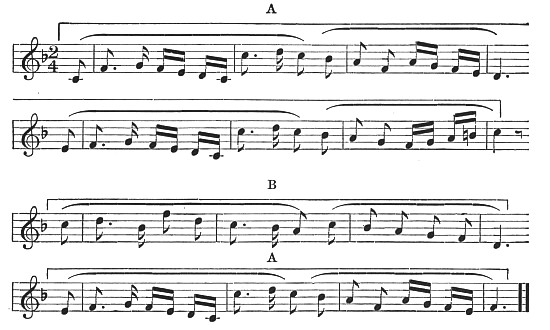
FIGURE VII.
Certain details may be pointed out for the benefit of the student. The first phrase, ending on the note D (5), gives a sense of being poised for a moment before proceeding to the next note, D not being a point of rest such as is supplied by the C with which the second phrase ends—at 9. The same device is used at the end of the third phrase (13). The clause of contrast (9-13), while based on the rhythm [28] of the motive of three notes at the beginning of the song, is distinguished from either of the other two parts by the absence of the characteristic sixteenth-note figure of measure two.
This song justifies all that we have said about the poetic beauty of folk-songs. Within its short compass are contained elements of perfection that may well astonish those who look on folk-songs as immaterial to the development of the art of music. For this melody is as complete and perfect an expression of that natural idealism that seems to have animated human beings from the earliest times as is the present day music of our own ideals.
The next illustration is a well known German folk-song called "Sister Fair."
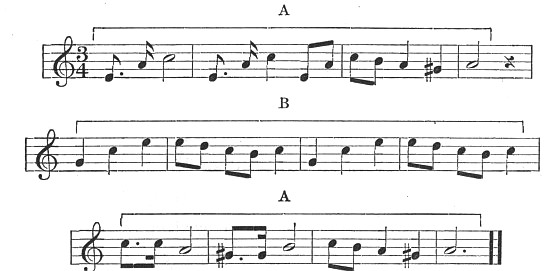
FIGURE VIII.
This melody is one of great beauty and tenderness. Like many other German folk-songs, it is full of quiet sentiment, not over-strained, but sweet and wholesome. [29] It contains certain formal elements with which we are already familiar: (1) "Repetition," between the first motive in measures 1 and 2, between measures 5-6 and 7-8, and between measures 3-4 and 11-12; (2) "transposition," where the motive in measure 9 is inverted in measure 10 (this is an imitation of rhythm but not of melody); (3) "restatement after contrast," the last four measures being, in effect, a repetition of the first four with the first motive from measure 9 inverted; (4) "modulation," the first phrase being in A-minor, the second in C-major, and the last in A-minor again. This is a particularly clear example of a modulation, as the three phrases distinctly centre round their respective key-notes, or tonal centres. It should be noted that the modulation is not to the fifth above the key-note, as in most of the other examples, but to the third above. This is common in songs in the minor key.
Quite a distinct charm is imparted to the first phrase of this melody by the use at the end of measure 2 of the little rhythmic figure that has already appeared at the beginning of the first and second measures. There is an unexpected charm in this shifting of a motive from one part of a measure to another. We shall see this device of musical construction in many of the larger works that are dealt with in later chapters.
There are a great many beautiful German folk-songs which would be well worth study here did space permit. The student is referred to such collections as Reimann's "Das Deutsche Lied," where the best of them will be found.
In this brief study of folk-songs we have noted that the stream of pure native melody was independent of the art-song and followed its own natural channel, but that, in spite of its limitation, presents to us some well developed formal types.
We have seen how important a part modulation plays in the plan of a piece of music, and how, by means of a change of key, a new kind of variety may be imparted to a melody.
We have observed how closely the old songs reflect the characteristics of the people who produced them, and how intimate was the connection between the songs—with the verses to which they were set—and the thoughts and feelings of those who used them.
In studying the German folk-song we have observed a subtle element of form, namely, the shifting of a motive from one part of a measure to another.
In the next chapter we shall take up the study of simple polyphonic pieces, such as have already been referred to in dealing with the round, "Three Blind Mice."
SUGGESTIONS FOR COLLATERAL READING.
Parry: "The Evolution of the Art of Music," Chapter III; Grove's "Dictionary of Music and Musicians," articles "Song" and "Form."
FOOTNOTES:
[1] Sir Hubert Parry in "The Evolution of the Art of Music."
[2] Such as Schubert's "Haiden-R?slein."
[3] The reader will find an account of these modes in Grove's Dictionary of Music under "Modes, Ecclesiastical."
[4] In Hadow's "Songs of the British Islands" (Curwen & Co., London).
[5] The first partial measure is counted as one.
[6] The partial measure at the beginning is counted as one.
We have seen in the last chapter some typical examples of folk-songs, which have served to give us an impression of folk-music in general, since it always conforms, in all essentials, to the type they illustrate. Folk-music is generally simple and unsophisticated in expression; it is generally cast in short and obvious forms; and it generally consists of a single melody, either sung alone or accompanied, on some primitive instrument, by a few of the commonest chords.
The prominence given to a single melody by music of this type, however, makes it unsuitable for groups of different voices, such as a vocal quartet or a chorus; and therefore when musicians began to pay attention to music intended for church use they had to work out a different style, in which several parts, sung by the various voices, could be strongly individualized. This led to what is called the "polyphonic," or "many-voiced" style. Another reason why the ecclesiastical style always remained unlike the secular was that the learned church musicians disdained any use of those methods which grew up in connection with folk-songs and dances, considering them profane or vulgar. Had they been willing to study them, they might have added much vitality to church music; but they maintained an attitude of aloofness and of contempt for the popular music.
The peculiarity of the polyphonic style is that that portion of the music which accompanies the chief melody is no longer a series of chords as in folk-music, but a tissue of secondary melodies, like the chief one, and hardly less important. (This arises, as we have just suggested, from the necessity of giving each of the four voices or groups of voices,—soprano, alto, tenor, and bass,—something individual and interesting to do.) The difference between the two styles is apparent even to the eye, on the printed page. A folk-song, or any other piece in "homophonic" or "one-voiced" style, has the characteristic appearance of a line of notes on top (the melody), with groups of other notes hanging down from it here and there, like clothes from a clothes line (the accompaniment). A Bach fugue, in print, presents the appearance of four (or more) interlacing lines of notes. (See Figure IX.)
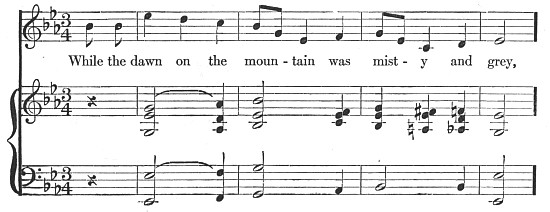
(a) Beginning of "Polly Oliver."
While the dawn on the mountain was mist-y and grey,
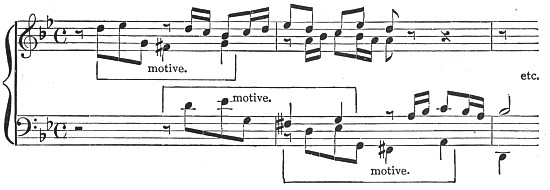
(b) Passage from Bach Fugue in G-minor
"Well-Tempered Clavichord," Book I.
FIGURE IX. DIFFERENCE BETWEEN "HOMOPHONIC" AND "POLYPHONIC" STYLE.
Historically speaking, the first great culmination of the polyphonic style is found in the ecclesiastical choruses of Palestrina (1528-1594); but it was not until somewhat later that this style was applied to instrumental music. In the inventions, canons, preludes, toccatas, and fugues of Johann Sebastian Bach (1685-1750), we get the first great examples of polyphony as applied, not to merely ecclesiastical music, but to music which by its secular character and its variety of emotional expression is universal in scope.
Such is the ingenuity and the perfection of detail in Bach's works in the polyphonic style that a life-time might be spent in studying them. They have that delicacy of inner adjustment more usually found in the works of nature than in those of man; their melodies grow out of their motive germs as plants put forth leaves and flowers; their separate voices fit into one another like the crystals in a bit of quartz; and the whole fabric of the music stands on its elemental harmonies as solidly as the mountains on their granite bases. [34] We can hope to see as little of this august country of Bach's mind by analyzing a few pieces as a man may see of the hills and moors in a day's excursion—but, nevertheless, a beginning must be made.
The essential features of this music may be seen in even so simple a piece as the Invention in F-major, number 7, in the two-voiced inventions, though it is written for only two voices and is but thirty-four measures long.
Bach: Two-voice Invention No. VIII., in F-Major.
The subject or theme of this invention is a melody of two measures' length, first given out by the soprano, and consists of two motives or characteristic figures, one in eighth-notes, staccato, making a series of leaps, thus:

and one a graceful descending run in sixteenth-notes, thus

Notice how charmingly the staccato and the legato are contrasted in these motives.
The entire invention is made out of this subject by means of those methods of varied repetition discussed in Chapter I., especially "imitation" and "transposition." For example, [35] the lower voice, which we will call the bass, "imitates," almost exactly, through the first eleven measures, what the soprano says a measure before it. On the other hand, in measure 12 the bass starts the ball a-rolling by giving the subject (this time in the key of C), and the soprano takes its turn at imitating. Then, from measure 29 to the end, it is again the soprano which leads and the bass which imitates. The student should trace out these imitations in detail, admiring the skill with which they are made always harmonious.
There are many instances of transposition also, most of them carried out so systematically that they form what musicians call "sequences."
A sequence is a series of transpositions of a motive, shifting it in pitch either upward or downward, and carried out systematically through several repetitions. Examples: measures 4, 5, and 6, transposition of the motive in soprano, three repetitions; measures 21, 22, 23, transposition of motives of both voices, three repetitions; measures 24, 25, transposition of motives of both voices, two repetitions. The second of these sequences is shown in Figure X.
It will be noted what a strong sense of regular, orderly progress these sequences impart to the melodies.
It is interesting to see that the same general scheme of keys is embodied in this invention that we have observed in folk-songs: i. e., the modulation to the "dominant" in the middle (measure 12), and the return at the end to the original key. This divides the piece into two unequal halves, the first making an excursion away from the home [36] key, the second returning home—much as the King of France, with twenty thousand men, marched up the hill and then marched down again. Such a two-part structure is observable in thousands of short pieces, and is called by musicians "binary form."
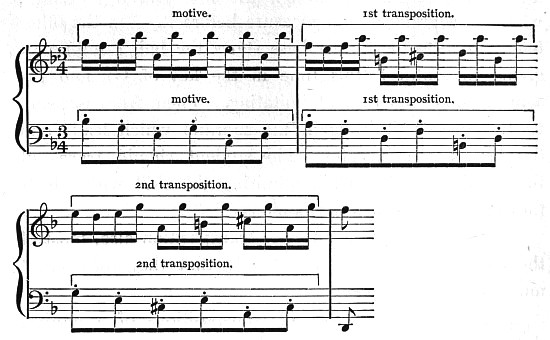
FIGURE X. "Sequence" from Bach's Invention in F-Major.
The difference in texture between this piece and any folk-song or dance will best be appreciated by playing over the bass part alone, when it will be seen that, far from being mere "filling" or accompaniment, it is a delightful melody in itself, almost as interesting as its more prominent companion. Indeed, in the whole invention there are only two tones (the C and the A in the final chord) which are not melodically necessary. Such is the splendid economy and clearness of Bach's musical thinking.
Before going further, the reader should examine for himself [37] several typical inventions, as, for example, No. I, in C-major; No. II, in C-minor; No. X, in G-major, and No. XIII, in A-minor, in this set by Bach, noting in each case: (1) the individuality of the motives used, (2) the imitations from voice to voice, (3) the sequences, (4) the modulations, (5) the polyphonic character, as evidenced by the self-sufficiency and melodic interest of the bass, and (6) the structural division of the entire invention into more or less distinct sections.
The same general method of composing that is exemplified in the inventions we see applied on a larger scale in the fugues of Bach.
The definition of a fugue given by some wag—"a piece of music in which one voice after another comes in, and one listener after another goes out"—is true only when the listeners are uneducated. For a trained ear there is no keener pleasure than following the windings of a well written fugue. It is, at the same time, true that a fugue presents especial difficulties to the ear, because of its intricately interwoven melodies. In a folk-song there is not only but one melody, with nothing to distract the attention from it, but it is composed in definite phrases of equal length, like the lines in poetry, with a pause at the end of each, in which the mind of the listener can take breath, so to speak, and rest a moment before renewing attention. Not so in the fugue, where the bits of tune occur all through the whole range of the music, are of varying lengths and character, and overlap [38] in such a way that there are few if any moments of complete rest for the attention. Perhaps this is the chief reason why fugues have the reputation of being "dry."
As is suggested by the derivation of the word "fugue," from the Latin "fuga," a flight, the characteristic peculiarity of the form is the entrance, one after another, of the several voices, which thus seem to pursue or chase one another, to go through a sort of musical game of "tag," in which first one and then another is "It." First one voice begins with the "subject" of the fugue, in the "tonic" key (key in which the piece is written). Next enters a second voice, "imitating" the first, but presenting the subject not in the "tonic," but in the "dominant" key. Then a third, once more in the tonic, and finally the fourth, again in the dominant. After these entrances all four voices proceed to play with the subject, transposing it in all sorts of ingenious ways, and straying off at times into episodes, generally in "sequence" form, but finally coming back, towards the end of the fugue, with renewed energy to the subject itself. All this may be seen in such an example as the Fugue in C-minor in Bach's "Well-Tempered Clavichord."
Bach: Fugue No. 2, C-minor, in three voices. "Well-Tempered Clavichord." Book 1. [7]
Like all the fugues in Bach's "Well-Tempered Clavichord," this fugue is preceded by a prelude, in free style, like a series of embroideries on chords, intended to prepare [39] the nearer for the more active musical enjoyment of the fugue to come. Parry, in the "Oxford History of Music," says of the Prelude of Bach and Handel: "It might be a simple series of harmonies such as a player might extemporize before beginning the Suite or the Fugue, [such is the case in the present prelude]; or, its theme might be treated in a continuous consistently homogeneous movement unrestricted as to length, but never losing sight of the subject" ... etc.
A fugal subject is usually longer and more pretentious than an invention subject, and more nearly approaches what we should call a complete melody. It may contain several motives. Moreover, while the second voice is "answering" the subject, the first voice continues with further melody, and if this is of definite, individual character it may easily assume almost as great importance as the subject itself, in which case we may give it the name of "counter-subject." In Figure XI the subject and counter-subject of this fugue are shown. The long brackets show subject and counter-subject; the short brackets show the three chief motives, marked a, b, and c. The simplicity of the melodic material is noticeable. Motive a, which, with its three repetitions, forms most of the subject, consists of five tones, in a charming and unforgettable rhythm of two shorts and three longs. Motive b is simply a descending scale, in equal short notes. Motive c is four equal long notes. Play the subject and counter-subject through separately, several times, and get them well "by heart" before going farther.
This fugue is a wonderful example of what a master-composer can make out of simple materials; the whole piece is built from these three motives. Our analysis may conveniently be made in tabular form, the student being expected to trace out the development for himself, measure by measure.


FIGURE XI. SUBJECT AND COUNTER-SUBJECT OF BACH'S FUGUE IN C-MINOR
(WELL-TEMPERED CLAVICHORD)
TABLE OF THEMATIC TREATMENT OF FUGUE IN C-MINOR
| Measures. | |
| 1-2 | Subject in Alto. |
| 3-4 | Subject "answered" in Soprano ("imitation"), counter-subject in Alto. |
| 5-6 | Episode 1: Motive a prominent in Soprano. |
| 7-8 | Subject in Bass, counter-subject in Soprano, fragments of motive c in Alto. |
| 9-10 | Episode 2: Motive a tossed between Soprano and Alto, motive b in Bass. |
| 11-12 | Subject, in key of E-flat major, in Soprano, counter-subject in Bass. |
| 13-14 | Episode 3: Motive b in Soprano, motive c in other two voices. |
| 15-16 | Subject in Alto, counter-subject in Soprano, motive c in Bass. |
| 17-19 | Episode 4: Motives a and b variously distributed between all three voices. |
| 20-21 | Subject in Soprano, in tonic key again, counter-subject in Alto, motive c in Bass, |
| 22-25 | Episode 5: Motives a and b in all voices. |
| 26-28 | Climax: Subject in Bass, motives b and c in other voices. |
| 29-31 | Coda: Subject in Soprano. |
Note that all the episodes take the form of sequences, as, for example, in the following instance (measures 9-10):
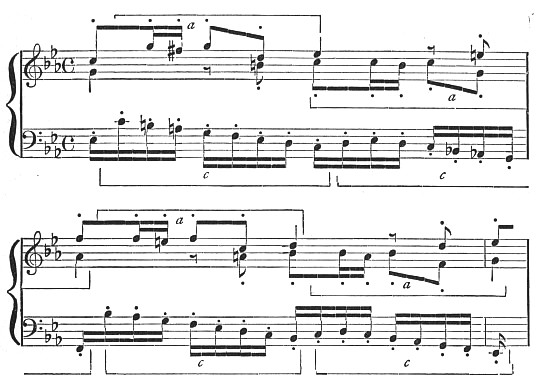
FIGURE XIa. A SEQUENCE FROM BACH'S FUGUE IN C-MINOR.
The general form of this fugue illustrates the same principles of modulation, and of restatement of subject after contrast, that we noticed in the folk-songs and in the invention. This may be tabulated thus:
TABLE SHOWING STRUCTURE OF FUGUE IN C-MINOR.
| A. | B. | A. |
| STATEMENT. | CONTRAST. | RESTATEMENT. |
| Measures 1-10 in key of | Measures 11-19 in various keys, | Measures 20-31 in |
| C-minor. | beginning with E-flat. | C-minor. |
The modulation in this case, however, is not to the "dominant" key, but to what is called the "relative major" key, as is usual in pieces written in minor keys, [42] (see the folk-song, "Sister Fair," in Chapter II), the reason being that the relative major affords the most natural contrast to a minor key, just as the dominant affords the most natural contrast to a major key.
The conclusion is emphasized by the finely rugged statement of the subject in Bass at measure 26.
The treatment of this fugue, for all its consummate skill, is comparatively simple. It does not employ the more subtle devices often employed in fugues, of which may be mentioned the following:
1. "Inversion:" The subject turned upside down, while retaining its identity by means of its rhythm.

Original Subject.

Inversion.
FIGURE XII. THE DEVICE OF "INVERSION."

Original Subject.

Augmentation.

Original Subject.

Diminution.
FIGURE XIII. THE DEVICES OF "AUGMENTATION" AND "DIMINUTION."
2. "Augmentation and Diminution:" The length of the notes doubled or halved, while their relative length, or rhythm, is carefully maintained. (Figure XIII.)
3. "Shifted rhythm:"[8] The subject shifted as regards its position in the measure, so that all the accents fall differently.

Original Subject.

Shifted.
FIGURE XIV. DEVICE OF "SHIFTED RHYTHM."
4. "Stretto:" The imitation of the subject by a second voice occurring prematurely, before the first voice has completed the subject, frequently with highly dramatic effect. (b) in Figure IX is an example of stretto.
These devices are mentioned here not only because they occur in many fugues, but because they are used in the symphonic music of Mozart and Beethoven, as we shall later have occasion to see.
Perhaps the most exacting of all tests applicable to music is the test of economy. Are there superfluous tones that do not enrich the harmony? Are there unnecessary subjects not needed to fill the scheme of design? If so, no matter how beautiful the music, it is defective as art. Bach bears this test victoriously. There is not a note of his writing which one would willingly sacrifice. There is not [44] a melody that is not needed. Each subject is not merely introduced and dismissed, but is developed to the utmost, so that all that was implicit in its germ becomes explicit in its final form. There is no confusion of the outline, no overcrowding of the canvas, no blotchiness in the color. As Giotto proved his supremacy among draughtsmen by the apparently simple but really enormously difficult feat of drawing a complete, perfect circle with one stroke of the pencil, so Bach constantly proves his supremacy among musicians by making two voices satisfy the ear like an orchestra. And this purity of texture is quite compatible with the utmost richness. Indeed, Bach's polyphonic scores are inimitably rich, since each voice sings its own melody, and the melodies all interplay harmoniously like the lines of a well-composed picture. Those who call Bach's fugues dry make an astonishing confession of their own insensibility or crudity of taste. Bach's melodies are not, to be sure, like "Annie Laurie" or "Home, Sweet Home." But neither is daylight like candle light; yet we do not call it darkness because it is diffused through all the atmosphere instead of concentrated in a single visible ray.
Bach's daring has been the subject of the endless admiration of students. Especially in the matter of harmony he did things in the eighteenth century, and entirely on his own responsibility, that whole schools of composers band together with a sense of revolutionary courage to do in the twentieth. He is truly one of the most modern of composers, and will always remain so. Composers who [45] might have been his grandsons are now antiquated, while he is always contemporary with the best musical thought. Brahms, irritated at Rubinstein's persistent patronizing of "Papa Haydn" in his book, "A Conversation on Music," remarked in his dry way: "Rubinstein will soon be Great-grandfather Rubinstein, but Haydn will then be still Papa Haydn." The same might be said even more truly of Bach, who will always be the father of musicians.
Another way in which Bach is modern is in the variety of his musical expression. It is not only that his range of different species of works is so great, reaching from the ecstatically tender and exalted religious choral compositions, such as cantatas, motets, oratorios, and passions, through the grand and monumental organ toccatas and fugues, to the intimate, colloquial suites and sonatas for orchestra and for clavichord; it is even more wonderful that in a single work, such as the "Well-Tempered Clavichord," he knows how to sound the whole gamut of human feeling, from the deep and sombre passions of the soul to the homely gaiety or bantering humor of an idle moment.[9] Bach might have boasted, had it been in his nature to boast, that in this work he had not only written in every key known to musicians, but in every mood known to men. It is the musical "Com?ie Humaine."
Bach lived quietly and in almost complete obscurity; for the last quarter-century of his life he held a post as teacher of music and church-music director in Leipsic.
He travelled little, sought no worldly fame, took no pains to secure performances of his works, and, above all, made no compromise with the popular taste of his day. He produced his great compositions, one after another, in the regular day's work, for performance in his church or by local orchestras and players. He never pined for a recognition that in the nature of things he could not have; he wrote the music that seemed good to him, and thought that his responsibility ended there, and that his reward lay there. The cynic who said "Every man has his price" was evidently not acquainted with the life of Bach. Steadily ignoring those temptations to prostitute his genius for the public's pleasure, which so materially affected the life course of his great contemporary Handel, he followed his own ideals with an undivided mind. As always happens in such cases, since it takes decades for the world to comprehend a sincere individual, or even centuries if his individuality is deep and unique, he was not appreciated in his life-time, nor for many years after his death.
Indeed, he is not appreciated now, for a man can be appreciated only by his equals. But we have at last got an inkling of the treasure that still lies hidden away in Bach; and while Handel and the other idols of the age sound daily more thin and archaic, Bach grows ever richer as the understanding we bring to him increases, and still holds out his promise of novel and perennial artistic delights.
SUGGESTIONS FOR COLLATERAL READING.
W. R. Spalding: "Tonal Counterpoint." Edward Dickinson: "Study of the History of Music," Chapter XX. C. H. H. Parry: "Evolution of the Art of Music," Chapter VIII.
FOOTNOTES:
[7] Number the measures, and call the voices soprano, alto, and bass.
[8] The reader should examine the example of shifted rhythm given in the second chapter in dealing with the German song, "Sister Fair."
[9] In Book I, for example, Fugue II is as light and delicate as XII is serious and earnest; XVI is pathetic, XVII vigorous and rugged, XVIII thoughtful and mystical, etc.
In the last chapter we studied the most important applications of the "polyphonic" style, which originated in music for voices, to the music of instruments. We saw how in such music the attention of the composer was divided among several equally important voices or parts, and how much he made of the principle of imitation; and in connection with the fugue we remarked that the very complex interweaving of the different voices in such music, one beginning before another leaves off, and all together making an intricate web, presented certain difficulties to the listener accustomed to the more modern style, in which a single voice has the melody, and stops short at regular intervals, giving the hearer a chance to draw breath, as it were, and renew attention for what is coming next. Listening to modern music is like reading a series of short sentences, each clearly and definitely ended by its own full stop. Listening to the old polyphony is more like reading one of those long and involved sentences of De Quincey or Walter Pater, in which the clauses are intricately interwoven and mutually dependent, so that we can get the sense only by a long-sustained effort of attention.
This more involved style, suitable to voices, but less [49] natural to instruments, had historically a very long life. Much of the instrumental music of the sixteenth, seventeenth, and eighteenth centuries was in fact nothing but a transference to instruments of music really conceived for voices. Thus, for example, in the sixteenth century, when madrigals and canzonas, which were compositions for voices in the polyphonic style but of a more secular character than church music, were exceedingly popular, the composers for stringed instruments and for the then very fashionable lutes, "when they wanted something of a superior order, ... simply played madrigals, or wrote music in imitation of any of the varieties of choral music, not realizing that without the human tones ... which gave expression to the rising and falling of the melodic material, the effect was pointless and flat."[10] Even Bach and Handel, in the eighteenth century, were, by their deeply-rooted habit of thinking vocally, in some degree hampered in the search for a purely instrumental style. Instrumental music, having to get along without words, must find some principle of coherence, some kind of definite design, which will make it intelligible without the help of words, and enable it to stand on its own feet.
And here comes in the importance of folk-song, and of the folk-dance which grew up beside it, to our modern instrumental music. For both song and dance pointed the way to such a principle of independent intelligibility, through definite balance of phrases (see Chapter I), and through contrasts and resemblances of key in the various phrases and [50] sections of a composition. Music intended to accompany songs or dances had to consist of balanced phrases of equal length—in the case of songs, because it had to reproduce the verse structure of the words, which of course were composed in regular stanzas of equal lines, and in the case of dances, because it had to afford a basis for symmetrical movements of the body. And when once it was thus divided up into equal phrases, it took musicians but a short time to find that these phrases could be effectively contrasted, and made the parts of larger musical organisms, by being put into different keys (as we have seen in the instances of modulation cited in Chapters II and III). How vital these principles of structure in balanced phrases and sections, and of contrast of keys, are to the entire modern development of music, we shall realize fully only as we proceed.
Again, both song and dance have proved supremely important to the development of the homophonic style (one melody, with accompaniment not itself melodic). In the case of song the reason is obvious. A song rendered by a solo voice, with instrumental accompaniment, naturally takes the homophonic style, since it would be highly artificial to make the subordinate element in the combination as prominent as the chief one. Dance is less inevitably homophonic than song; indeed many dances, as we shall see, are to a greater or less degree polyphonic; but nevertheless the tendency toward homophony is always apparent. In the first place, the interweaving of many melodies would tend to obscure the division into definite phrases, since an inner melody might sometimes fill up the pause in the main one, [51] as we saw it constantly doing in the fugue. Secondly, the mode of performing dances tends to give prominence to a single melody. The old dances were generally played by one melodic instrument, such as a violin or hautboy, accompanied by chords on an instrument of the lute or guitar [52] family, and frequently by a drum to strengthen the accents. Such a combination affords but one prominent "voice," and does not lend itself naturally to polyphonic writing.
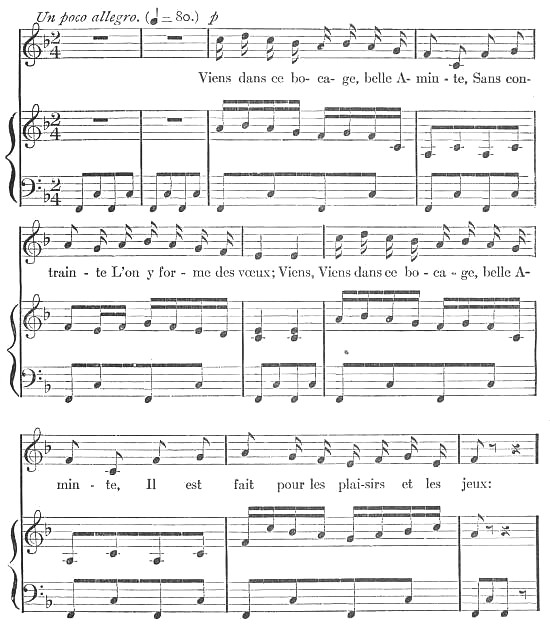
FIGURE XV.
Viens dans ce bo- ca- ge, belle A- min - te,
Sans contrain - te L'on y for - me des vœux; Viens,
Viens dans ce bo - ca - ge, belle A- min - te,
Il est fait pour les plai-sirs et les jeux:
The "Tambourin," for instance, an old French dance of Provence, was played by one performer, the melody with one hand on the "galoubet," a kind of pipe or flageolet, and the accompanying rhythm with the other on a small drum. The quotation in Figure XV, taken from Wekerlin's collection, "Echos du Temps Pass?" (Vol. III), is a good example of this ancient dance. In this arrangement for piano, the left hand imitates the drum, and the right hand the "galoubet" or pipe. This quotation illustrates the common use of dance melodies in songs. Many primitive airs were so used in the olden times.
The rude dances which spring up spontaneously in all communities, savage as well as civilized, and of which we in America have examples in the war-dances of Indians and the cake-walks of negroes, are thus seen to be pregnant of influence on developed musical art, no less than the folk-songs which we discussed in the second chapter, and the more academic music in the polyphonic style which we treated in the third. Both songs and dances, indeed, sometimes enter into artistic music even in their crude form, but in most cases composers treat them with a certain freedom, and in various ways enhance their effectiveness, as Haydn, for instance, treats the Croatian folk-tune "Jur Postaje," in [53] the Andante of his "Paukenwirbel" Symphony. In Figure XVI the reader will see both the crude form of the tune and the shape into which Haydn moulds it for his purposes.

"Jur Postaje."
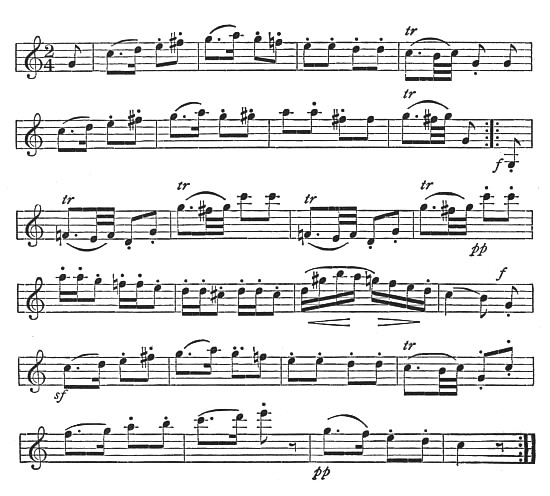
HAYDN'S Version.
FIGURE XVI.
In the long process of development which songs and dances thus undergo at the hands of composers, they of course lose to some extent their contrasting characters, until in modern music the dance and the song elements are as inextricably interwoven as the warp and the woof of a well-made fabric.
As imitation is only slightly available in homophonic music, the unity so vital to all art is attained in dances chiefly by transpositions of motives, often in systematic "sequences," by more or less exact balance of phrases, and by restatement after contrast. In crude examples these means are crudely used; in the work of masters they are treated with more subtlety and elasticity; but always a careful analysis will discover them. It will now prove enlightening to compare, from this point of view, three dance tunes of very different degrees of merit.
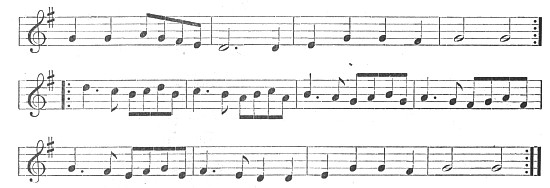
FIGURE XVII.
A "Branle" or "Brawl" from Arbeau's Orchesographie, (1545).
Figure XVII shows an ancient "Branle" or "Brawl" of the sixteenth century, taken from Arbeau's "Orchesographie," published in 1545.
The strong meter, causing a distinct accent on the first note of each measure, will at once be noted, especially if it be contrasted with the more moderate accentuation of the folk-songs of Chapter II. Such strong meter is naturally characteristic of all dance tunes, intended as they are to guide and stimulate the regular steps of the dancer.
The phrase balance, though marked, is not absolutely regular, but the two two-measure phrases at the beginning and the single one at the end suffice to give an impression of pronounced symmetry. The six-measure phrase after the double-bar is generated by the sequential treatment of the little motive of measure 5.
This sequence (measures 5, 6, 7, 8, 9) is worthy of note because of the excessive length to which it is carried. Five repetitions are too many, and grow monotonous. A more skilful composer would have secured his unity without so great a sacrifice of variety—in a word, he would have treated a device good in itself with less crudity.
The exact repetition of measures 3-4 at the end is an effective use of restatement after contrast. Although the whole of the original theme is not given, there is enough of it to give the sense of orderliness in design.
A Gavotte in F-major by Arcangelo Corelli (1653-1713), the famous violin virtuoso of the seventeenth century, printed in Augener's edition of Pieces by Corelli, will illustrate a distinctly higher stage in the treatment of a dance form. This is well worth a brief analysis.
Corelli: Gavotte in F-Major.
Here the phrase balance, though entirely satisfying to the sense of rhythm, is much more elastic than in the brawl. The measure-lengths of the phrases are not all the same; they are as follows: 1, 1, 2, 1, 1, 1, 2, 2. This gives the tune an agreeable variety.
It will be noted, however, that the sequence is still treated rather fumblingly. In the three measures after the double-bar, the same motive is repeated thrice, each time higher than before, and to a fastidious ear the third repetition grows slightly wearisome.
On the whole, nevertheless, the gain in elasticity and freedom over the last example is marked.
The general structure and scheme of modulation in this little Gavotte of Corelli deserves careful attention, because it is in these respects typical of a very great number, indeed of the majority of the short dances of the seventeenth and eighteenth centuries. It is divided into two distinct halves, and while each deals with the same musical material, the two are strongly contrasted in the matter of key. The first begins in the home key and leaves it to end in a contrasted key, in the present case the "dominant." The second, beginning in the dominant, modulates back again to the home key, and ends there. This scheme, called by musicians "binary" or "two-part" form, is a very simple and natural one for short pieces of this kind, and is to be found in thousands of the movements of Corelli, Scarlatti, [57] Couperin, Rameau, Purcell, Handel, Bach, and other masters of their day. It is even more common than the "ternary" form to which we shall come in a moment.
If the reader will now compare with these two dances the Gavotte in the sixth English Suite of J. S. Bach, who had the advantage of living half a century later than Corelli (besides being an immeasurably greater genius), he will be amazed to see the power and originality with which a master can treat a traditional form.[11]
Bach: Gavotte in D-Minor from the Sixth English Suite.
Before looking at matters of detail, we must notice the structure of the piece as a whole, since it is not only highly interesting in itself, but is an example—the first we have had on a large scale—of a type of construction that is perhaps more popular with musicians of all schools than any other.
This structural type is nothing but an application to an entire piece of that three-part form which we have seen in little in the Galician folk-song of Chapter I and in "Polly Oliver" in Chapter II, and to which we may now give the name of "ternary form," to distinguish it from the "binary form" discussed in Chapter III. Bach here [58] writes two distinct gavottes, repeating the first after the second: so that Gavotte I is a statement, Gavotte II a contrast (emphasized by change of key from minor to major), and the repeated Gavotte I a restatement. This practice is very frequent in Bach's suites, where we often find two courantes, two bourr?s, two passepieds, two minuets, etc., combined in this way, the function of the second being to afford contrast to the first. In some instances the second of the pair is called "trio," probably because the earliest examples were written in three-voice harmony, or "musette," from the French word for "bagpipe," in reference to the drone bass imitating that instrument. (This is the case in the present gavotte, where the gavotte II bears the alternative name of musette.)
In the sonatas and symphonies of Haydn, Mozart, and Beethoven, as we shall see later, this three-section structure is found in the minuet with trio, and in the scherzo with trio. Nor is it less common in modern music, occurring notably in the marches of Schubert, many of the short pieces of Schumann, in the polonaises and some of the nocturnes of Chopin, in the rhapsodies and intermezzos of Brahms, and in the lyric pieces of Grieg. Indeed, its naturalness and clearness inevitably commend it to all composers.
Looking more closely we see, again, that the same scheme is used by Bach in each of the two gavottes, considered separately. In the first, we note the structure A = measures 1-10, B = measures 11-27, A = measures 27-35; in the second we find, A = measures 1-10, B = measures [59] 11-19, A = measures 19-28. The student should verify this analysis for himself.
Proceeding now to details, we notice first that Bach, supreme master of polyphony that he is, writes even a gavotte in such a way that each of its voices has its own melodic value. The gavotte itself is in three voices throughout, and the musette in two, and while these voices are not so purely melodic as in an invention or a fugue, and there is little strict imitation, yet the general effect is polyphonic rather than homophonic. In measures 27-31 the alto voice even has the theme.
The phrase balance is freer than even Corelli's, because Bach's mind is quicker to seize upon and work out the latent possibilities of his melodies. All begins regularly enough: the first four phrases are each two measures in length; but after the double-bar the "plot begins to thicken." First we find two more phrases just like the preceding ones (measures 11-13 and 13-15); but in the next phrase, begun in the same way, in measure 15, the yeast of Bach's fancy begins to work, and the melody broadens out in a series of evolutions, first in the soprano and later in the alto, not coming again to a point of rest (end of a phrase) until measure 23. This extension of a phrase through the germination or blossoming of the thought (in this case it all comes from the bit of melody in measure 7) is a matter of supreme importance in composition, and this instance of it, as well as another in measures 23-27, should be carefully studied by any one who desires to understand music. The power thus to develop or draw forth the hidden potentialities [60] of his motives is one of the most important of all the gifts which go to make a composer. Still further instances of it should now be found by the student himself in the musette.
The artistic freedom and felicity of Bach's way of working is further illustrated by the manner in which, while using the general principle of the sequence as a means of giving his music unity of idea, he avoids those overliteral, mechanical transpositions of motive which we found in the more primitive dances. There is just the contrast here that there is between a poor speaker, who keeps repeating the same word or phrase with futile emphasis, and the man of real eloquence, who follows a train of thought no less closely, but manages constantly to cast his ideas in new phraseology and fresh figures of speech, so that the variety of what he says is quite as striking as its fundamental unity.
The element of variety introduced into the contrast-section of the gavotte (11-27), by the free modulation through several keys, should also be remarked. The plan of modulation is different from any we have yet had. Instead of beginning in the relative major (which would be the key of F), the section begins in the dominant minor (A-minor). A good many keys are then touched upon before the tonic or home key is reached at the restatement (27-35), which, by a charming subtlety, begins with the theme in the alto instead of the soprano voice.
In all these matters we detect the workings of an original and inventive mind, which, far from being hampered by working in a traditional form, is stimulated to constantly [61] new solutions of old problems, and so produces a piece of music at once perfectly clear and fascinatingly interesting.
In the next chapter we shall see how composers combined groups of such dances as this, with other pieces of a different character, into those suites which were the most popular forms of instrumental music in the eighteenth century.
SUGGESTIONS FOR COLLATERAL READING.
Grove's Dictionary: article "Rhythm," and articles under names of various dances, as "Gavotte," "Allemande," "Courante," "Minuet," "Gigue," etc.
Other examples of dances may be found in a collection of twenty-five old gavottes, published by Breitkopf and H?tel, and in a volume of miscellaneous old dances in the Litolff Edition.
Once musicians had begun to realize how dances could be developed into finished pieces, like the gavotte of Bach, which we discussed in the last chapter, they were quick to avail themselves of this advantage by combining several such dances into a group, thus making a composition of some length and dignity and yet of popular, easily comprehensible style. Such compositions, known in England as "Lessons," in France as "Ordres," and in Germany as "Suites" and "Partitas," became numerous in the seventeenth and eighteenth centuries.
The first historical step in the development of the suite was taken when the great violin-makers of Cremona and Brescia, in Italy, brought the violin to a wonderful mechanical perfection early in the seventeenth century. Virtuosos on this brilliant instrument were not slow to appear, and they dazzled their audiences with pieces known as sonatas, though having little in common with what we nowadays call a sonata. Their sonata da chiesa, or church sonata, was a group of pieces, all polyphonic in character and derived from the old choral madrigals and canzonas; the sonata da ballo, or dance sonata, was a group of dance tunes; the sonata da camera, or chamber sonata, combined both [63] types. Gradually the first become obsolete, and the second and third took respectively the names suite and partita, although the nomenclature was inexact, as suites often contained movements of strict and severe polyphonic style as well as dances. The greatest of the violin virtuosos was Arcangelo Corelli, whose "sonatas" retain their charm even for our modern ears, as may be seen from the sample of his work studied in the last chapter.
About the end of the seventeenth century the keyed instruments, such as the harpsichord, the clavichord, the spinet, and other precursors of our modern pianoforte, first reached the degree of mechanical perfection which enabled them to rival the violin; and it was accordingly not until then that important pieces for such keyed instruments began to be written. At the end of the seventeenth and the beginning of the eighteenth centuries, however, we find interesting music for these instruments by composers of several nations. In France Couperin (1668-1733) wrote what he called "Ordres," short series of pieces "in dance style, piquant in rhythm, melodiously graceful, profusely embroidered with embellishment;"[12] and he was followed by Rameau (1683-1764) with similar works. A curious whim of these French masters was the appending of picturesque titles to their pieces, such as "The Tambourine," "The Hen," "The Return of the Birds," etc.—a practice which anticipates the program music of to-day.
Italy had one extraordinary genius in this department of music, Domenico Scarlatti (1683-1757). He was a [64] most brilliant performer on the harpsichord, delighted in all feats of agility, and loved to surprise and astonish his audience. In short he was a virtuoso, and his performances must have created the kind of sensation in the seventeenth century that Liszt's did in the nineteenth. "For vivacity, wit, irony, mischief, mockery, and all the category of human traits which Beethoven's scherzo served so brilliantly to express," says Parry, "the world had to wait for a full century to see Scarlatti's equal again." Some of the preludes, sarabandes, minuets, courantes, etc., composed by him, still retain their interest. His beautiful Pastorale in E-minor, and his "Cat fugue," written on a theme played by a pet cat running across the keyboard, are sometimes heard in recitals.
It was in the hands of the German masters, Bach and Handel,[13] however, that the suite reached its highest state. These two great composers, born in the same year, 1685, possessed not only the sense of technical effect which made Scarlatti great, and the high spirits, enthusiasm, and sense of proportion which are needed for the production of idealized dance movements such as Couperin and Rameau have given us, but they had great musical learning, and much experience in the use of the strict choral style of polyphonic writing, which they showed by introducing into their suites certain movements much more serious in style and exalted in sentiment than dances. The English and French Suites, so called, of Bach, and the Twelve Harpsichord Suites, or "Lessons," as they were called in England, of Handel, deserve to rank among the great masterpieces of musical art.
The six English and six French Suites of Bach, which deserve a more detailed study than any others, consist generally of from five to eight separate pieces or movements. The first, derived from the severer type of the sonata da chiesa, and thus, more remotely, from the choral madrigal and canzona (see above), is always more intricate and elaborate than the others. In the English Suite it is a long contrapuntal prelude, with imitations and sequences such as we studied in the invention and the fugue. In the French Suites it is an allemande, less elaborate but still dignified and impressive. We see this to be appropriate when we remember that the hearer is best able to follow intricacies when his mind is fresh and unjaded.
Bach: Prelude to English Suite, No. 3, in G-Minor.
The Motives: The thematic material out of which this prelude is developed is very simple, consisting of just two motives, which we will call (a) and (b).
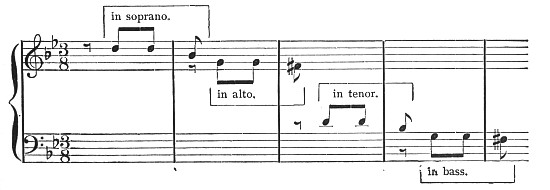
Motive (a) (imitated through four voices.)

Motive (b) (imitated by a second voice) measures 33-36.
FIGURE XVIII. MOTIVES OF BACH PRELUDE IN G-MINOR
Note the effective contrast between the bold, assertive character of motive (a) and the more graceful character of (b).
Structure: The prelude divides itself into seven clearly marked sections, each ended by a well-marked cadence. Let us examine these briefly in turn.
Section I, measures 1-32, key of G-minor: Founded on motive (a), with many sequences which the reader should now be able to trace for himself.
Section II, measures 33-66: Begins in G-minor, modulates to B-flat major, the "relative major." Motive (b) in soprano, measures 33-34; in alto, measures 35-36; in bass, measures 43-44. Motive (a), measures 35, 36, 37 (alto), 38, 39, 43, 44, 53, 54, etc.
Section III, measures 67-98, key of B-flat: An almost exact copy of Section I, in a different key.
Section IV, measures 99-124: Begins in B-flat major, modulates to D-minor, the "dominant" of the original key. Both motives tossed about from voice to voice. (The reader should locate each instance for himself.)
Section V, measures 125-160: Begins in D-minor, modulates to E-flat major, thus giving variety of key in the middle part of the composition, which we begin to see is an important principle of form. (Compare the Gavotte of the last chapter.) Very similar in treatment to Section II.
Section VI, measures 161-179: Modulates back from E-flat major to the home key, thus preparing the way for the final statements and conclusion. In measures 175-178 the insistence of the bass on the tone D, the "dominant" of the original key, will be noticed. Such an insistence on one tone is called a "pedal point," because so frequently found in the pedal part of organ music, and serves admirably here to prepare the mind for the triumphant return to G-minor in the final section. The rest of Section VI is made up of sequences, thus: 162-165, 166-169, 170-173; and then, 173, 174, 175, 176, 177, 178.
Section VII, measures 180-213: Almost entirely in the home-key, thus emphasizing the sense of finality. The bulk of this section is furthermore identical with Section I, thus affording a fine example of the principle of restatement after contrast.
Altogether this is a most interesting movement. In the great effect made with simple means we recognize again, as we did in the case of the invention and the fugue, the splendid power of Bach's mind. The principles of imitation of motives from voice to voice, of transpositions of a single motive in a single voice giving rise to the many sequences, and of restatement after contrast, all discussed in the first chapter, are illustrated more brilliantly than by any other composition we have thus far examined. Finally, in the variety of key of Section V, placed in the middle of the piece, and in the unity of key of the first and last sections, we get a striking anticipation of a principle of construction which we shall later see to be at the root of the most important of modern forms, the sonata-form.
After listening to such a movement as this we naturally wish to relax a little; and we are, therefore, pleased to hear a series of dances of various rhythms and qualities of expression, cast in simple "binary" or "ternary" forms, and either frankly homophonic in style or not too elaborately polyphonic. It is impossible to describe in detail here all the dances found in suites, but the table on page 68 will give an idea of the more important ones.
The gavotte studied in the preceding chapter gives an excellent general impression of the livelier dances used, which may be farther defined by a glance at such typical pieces as the bourr?s of the first and second English Suites, and the gavottes of the third English and fifth French Suites. There is generally also to be found in Bach's suites, introduced for the sake of contrast and in order to [68] represent the more emotional side of musical expression, a sarabande or other such slow, stately, and sometimes truly noble movement. Let us take, as an example of this element, the Sarabande from the second English Suite.
FIGURE XIX. THE CHIEF DANCES USED IN SUITES
| NAME | ORIGIN | METER | FORM | CHARACTER |
| Allemande | German | 4-4 | Usually "binary" | Brisk, fluent. |
| Courante | French | 3-2 or 3-4 | " "binary" | Merry, energetic. |
| Sarabande | Spanish | 3-2, 3-4 | " "binary" | Stately, serious, sometimes noble. |
| Bourr? | French | 4-4, 2-4 | " "ternary" | Lively. |
| Gavotte | French | 4-4 | " "ternary" | Moderately quick, well-marked. |
| Minuet | French | 3-8, 3-4 | " "ternary" | Well-regulated gaiety, courtly. |
| Passepied | French | 3-4 | Animated, brisk. | |
| Loure | Old French | 6-4 | Slow, stately. | |
| Anglaise | French | 2-4 | Lively, energetic. | |
| Polonaise | Polish | 3-4 | Dignified, but animated. | |
| Pavane | French | 2-4 | Stately. | |
| Rigaudon | French | 2-4, 4-4 | Very lively, gay. | |
| Gigue | Doubtful | 6-8, 12-8 | " "binary" | Very rollicking and merry. |
EXAMPLE FOR ANALYSIS, No. 6.
Bach: Sarabande in A-Minor from English Suite II
The melodic germ from which the piece is developed is the following very serious and earnest phrase:
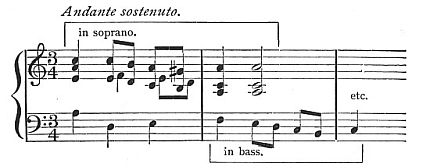
FIGURE XX.—THEME OF BACH SARABANDE
a phrase in which great depth of almost tragic feeling is expressed. Against this is set, for the sake of relief, the [69] lighter and more suave melody of measures 5 and 6, treated in freely sequential fashion. The whole sarabande is built from these two brief melodic figures.
This sarabande serves as an admirable illustration of the type of beauty common in the music of Bach. Its phraseology, if we may use the term, is quite different from that in use in the music of to-day; it is full of quaint and archaic turns of musical speech—formal sequences, little motives that sound to us almost mechanical. It is like an etching of D?rer's, full of detail, each line carefully drawn, and the whole picture instinct with life. Thus its type of beauty differs so materially from that to which we are accustomed that it often fails in its appeal. Only by using our imagination are we able to project ourselves, so to speak, into another milieu, another time, another point of view. And this is the test with which any archaic work of art confronts us. Without imagination in the beholder a picture by Botticelli, for example, is a curiosity rather than a work of art. Its strange allegory, its quaint idea of landscape, its figures with their unusual posing—all these are beautiful or merely curious according as we look at them. "Beauty is in the eye of the beholder."
The repetition at a higher pitch of the main motive in measures 3-4 is highly poignant; and throughout the expression is intensified by the use of rich and often complex harmony, as particularly in the last four measures of all.
Notwithstanding the earnest and impassioned character of this sarabande, its derivation from the dance is clearly revealed in the regularity of the balance of phrases consisting [70] of equal measure groups, which divide up as follows: 2, 2, 4, 4 (double-bar); 2, 2, 4, 2, 2, 4. The symmetry is much more precise than in an invention or a fugue.
The form is binary or two-part. Part one, measures 1-12, begins in A-minor and ends in the "relative major," the key of C. Part two, measures 13-28, begins (with the original motive) in C-major, and returns to A-minor.
The sequence of measures 23-24, with measures 21-22, is very beautiful and deserves special notice.
Following the sarabande the reader will observe a more florid version of it, bearing the caption, "Les agr?ents de la m?e Sarabande"—"Ornaments for the same Sarabande." This is an example of the practice, common in Bach's day, of weaving a net-work of grace-notes, trills, and other decorations about a melody, a practice due in part to the natural fondness of all musicians for "effect," and in part to the fact that the instruments of that day were so small and poor that a tone could only be sustained by being struck many times. This custom of ornamenting melodies with all manner of embroidery gave rise to the "theme and variations," a form which we shall study later.
All the other English Suites of Bach contain very beautiful sarabandes; those in the French Suites are less interesting, though the first contains a fine example.
All of Bach's twelve suites end with gay and vigorous gigues, the most rollicking of all the dances used. This is natural enough, in view of the desirability of closing the suite with an impression of energetic vitality. These gigues are in the headlong 6-8 or 12-8 meter; they are polyphonic [71] in texture, and constructed in the binary form. Often-times a high degree of contrapuntal skill is shown in their composition, but usually this does not interfere with their light and almost careless character. A curious feature of most of them is that in the second half the motive is inverted or turned upside down.
EXAMPLE FOR ANALYSIS, No. 7.
Bach: Gigue, from French Suite IV in E-Flat.

Theme of Gigue, Bach's French Suite IV, and its Inversion.

Inversion of theme, beginning of second half.
FIGURE XXI.
The gay little theme is composed of two motives, as indicated in Figure XXI, in which the long brackets show the theme and its imitation by the second voice to enter, and the short brackets show its component motives, of contrasting character. In measures 5 and 6 the theme is again imitated by the third voice (left hand part). In [72] the course of the development a still more lively figure makes its appearance in measures 19, 23, 24 and 25.
The now familiar sequences are found at every turn. The form is binary (Part I, measures 1-26; Part II, measures 27-60). The inversion of the theme, shown in Figure XXI, makes the subject of the second half. The key-system is perfectly simple. Part I modulates from the tonic, E-flat, to the dominant, B-flat; Part II begins there and returns to the home-key.
In the course of the eighteenth century the suite gradually waned in popularity, and gave place to the more highly organic sonata. Modern suites, notable among which are such delightful works as Bizet's "L'Arlesienne," Grieg's "Peer Gynt," Dvor?'s Suite for small orchestra, opus. 39, Tschaikowsky's "Nut-Cracker Suite," and Brahms's "Serenades" for orchestra, are, after all, exceptional and infrequent, and not the inevitable mould in which the composer casts his ideas.
But the historical importance of the suite was great, and it fell into disuse only after its lessons had been thoroughly learned. Through it musicians developed the dance element which must always be one of the two main strands of all music; through it they learned to substitute for the ancient polyphonic style which is suitable to voices the homophonic style best adapted to the capacities and the limitations of instruments; and through it they became familiar with those simple binary and ternary forms in which [73] such instrumental music is most conveniently and effectively cast.
Thus the suite formed the bridge between, on the one hand, (a) crude folk-songs, (b) primitive dances, and (c) strict polyphonic forms such as the invention and the fugue, and on the other, the sonatas, quartets, concertos, and symphonies of Haydn, Mozart, and Beethoven.
SUGGESTIONS FOR COLLATERAL READING.
Dickinson: "The Study of the History of Music," Chapters XIII and XIV. Parry: "Evolution of the Art of Music," Chapters VIII and IX; Mason: "Beethoven and His Forerunners," Chapter IV.
The study of the suite contained in the last chapter has brought us for the first time into contact with a cyclic form. We have seen that, as instruments developed, as the technique of playing them advanced, and as the themes and their harmonies became more plastic, composers naturally sought some larger plan than that afforded by a single dance form; they thus arrived at the suite. But the suite was inclined to be monotonous. The same key was used for all the separate movements, there was an almost invariable stated length for each, and the rhythms were too insistent to admit of great variety of expression. So composers began to experiment with other forms, chief among which was the sonata.[14]
Through all the rest of this book we shall be dealing directly or indirectly with the musical forms that go to make up the complete sonata. In the present chapter we shall deal with one of its simplest and most primitive types of structure, the rondo.
Sonatas were written as far back as the seventeenth century. Kuhnau's celebrated "Bible Sonatas," crude attempts at program music, are among the notable [75] examples of primitive sonatas. These were indeed "sound-pieces," but their resemblance to a real sonata, as we understand the term, is slight. Bach and Handel each wrote sonatas; and some of Bach's are masterly examples of the then prevailing style. His sonata for violin and piano in F-minor (number V in Peters' edition) may be studied as an example of the form. It contains four movements, the first, second, and fourth of which are purely polyphonic, the third being one of those beautiful meditative pieces of a somewhat rhapsodical style in which Bach seems to have specially delighted. Italian contemporaries of Bach also wrote sonatas, and some of those by D. Scarlatti (1683-1757) and A. Corelli (1653-1713) were of considerable importance in the development of the form. All these early specimens, however, were either vague and indeterminate in form, or were hampered in their expression by the old polyphonic methods. The modern sonata first begins to emerge in the work of Philip Emanuel Bach, son of John Sebastian, and his compositions in this style will be the subject of a later chapter.
Our investigations into the formal element of early dance music have thus far revealed two plans, "binary" and "ternary," i. e., two-part and three-part. For such short pieces as the inventions of Bach, and for many of the separate dances in suites, the two-part form was adequate, but when instrumental music began to develop [76] on broader lines, so that each of the halves was extended to a considerable length, the advantage of the three-part form with its "restatement after contrast" was readily perceived, and it came to be frequently used.
Among the early experiments in form we find a kind of extension of ternary form by the repetition of its separate parts. Such pieces sometimes consist of but one stable phrase (A) with alternating phrases of an indefinite character, while others alternate two set phrases, as: A, B, A, B, A, B, A, etc. The one fixed principle in these pieces seems to be that they should end with the phrase with which they began. In primitive songs this fixed part constituted the chorus, with which the solo melody alternated, having, of course, different words for each verse.
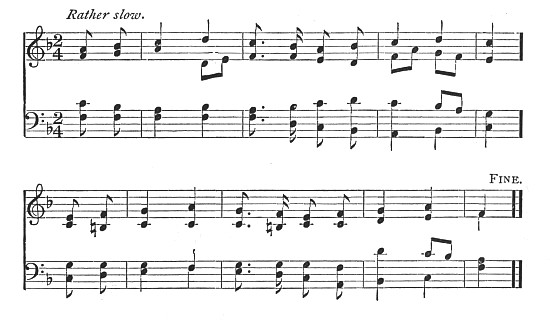
FIGURE XXII. NOUEL DE LAS FLOUS. (CAROL OF THE FLOWERS)
"The question is sometimes raised whether in the primitive carol the chorus began, or whether, as in many of our own popular songs, it waited until the end of the first solo verse. Probably the former is of the greater antiquity; in any case, it is from it that the rondo[15] is derived."—Hadow, "Sonata Form."
An example of this primitive type of carol will be found in Figure XXII.
This is an ancient carol from the old province of Bas-Quercy (now Lot-et-Garonne) in the southwestern part of France.
The obvious weakness of this form, when applied to instrumental music, is its monotony. One would soon weary of a bald repetition over and over again of two phrases or two melodies to which no variety was imparted, such as the change of words supplies in the foregoing carol. In order to avoid this disadvantage the natural step to take would be to impart, by some means or other, variety to the music; and this was soon perceived by composers. The idea of a fixed part remained, i. e., the chief musical idea was retained in its original form, but the secondary melodies were varied. Once this change had taken place the rondo became a frequent medium of musical expression. Specimens of the early rondo may be found in Purcell's song, "I Attempt from Love's Sickness to Fly," and in Bach's, "Passepied en Rondeau," from the fifth English Suite. The formula for these two pieces is A, B, A, C, A.
Another interesting point is the plan of the harmony of the contrasting sections in the rondo. The first of these (B) would naturally follow the prevailing custom for "sections of contrast," and be in the dominant, or, if the piece were in minor, in the relative major (see Chapter II.); but the second (C) offered a further means of variety, and the instinct of composers led them to treat it in a free [79] manner and not confine it to any one key. Each of the examples of rondo form referred to above adopts this method of procedure.
While this early form of the rondo possessed a certain charm, it was somewhat rigid in effect, since the various sections were separated from each other by a full close or complete pause. They were like little blocks that fitted together into a definite, if somewhat stiff pattern.
The primitive rondo was chiefly cultivated by the French harpsichord composers of the early eighteenth century, of whom Couperin (1668-1733) and Rameau (1683-1764) were the most distinguished. Reference has been made in our chapter on "The Suite" to the "Ordres" of these composers, and to the perfecting, at the end of the seventeenth century, of the instrument for which they were written, the harpsichord. The strings of the harpsichord were not struck by hammers, as in the modern pianoforte, but plucked by quills, as the strings of a banjo are plucked by the fingers of the player. It has been said of the harpsichord that it produced "a scratch with a tone at the end of it." The tone produced in this primitive way was weak and of brief duration, so that composers not only had to keep re-enforcing a tone by striking it again, as in the trills and other ornaments so characteristic of their music, but had to avoid altogether any long sustained [80] passages such as are common in modern music. They had also to substitute for the polyphonic style, the entire effectiveness of which depends upon the sustainment of its melodies, a homophonic or one-voiced style which, while distinct from that usual in modern piano music, was historically an important factor in its development.
Couperin: "Les Moissonneurs" ("The Harvesters").
This na?e and delightful piece is a good example of the prevailing style of French domestic music in the eighteenth century. It is notable for its character of elegance; it is salon music, but at the same time it reveals a certain mimetic quality common among the French. The swing of its rhythm seems to catch a little of the idea conveyed by the title. Couperin's pieces have been called "a sort of refined ballet music," and they are, as a whole, based on well defined rhythmic movement. But we may trace in them the gradual progress away from dance forms and towards a freer and more idealized expression.
Couperin was called by his contemporaries "Le Grand," and was an important figure in the musical life of Paris during the reign of Louis XIV. His influence extended beyond France; even John Sebastian Bach adopts some of his methods in writing his French suites.
"Les Moissonneurs" may be formally tabulated as follows:
FIGURE XXIII. STRUCTURAL PLAN OF COUPERIN'S "LES MOISSONEURS."
| Section | Measures | Notes |
| A |
[16]1-9 |
Entirely in tonic key with pause at end. (The key is B-flat major.) |
| B |
10-14 |
Modulating to the dominant and ending thereon. |
| A | 15-23 | An exact repetition of the first A. |
| C |
24-32 |
Entirely in relative minor key with pause at end. |
| A | 33-41 | An exact repetition of the first A. |
| D |
42-56 |
Beginning in tonic; modulating to C minor and back again. |
| A | 57-65 | An exact repetition of the first A. |
An examination of this rondo will reveal that the subsidiary portions—B. C. and D.—are episodes rather than distinct themes. Their melodies, instead of being entirely new as in the more highly developed rondos of Haydn and Mozart, are either literal copies of the chief melody, or close imitations of it, in related keys; so that the chief variety imparted by them is a variety of harmony. The plan of these harmonies should be carefully noted, particularly the use of the home key in the section marked D. This method of unifying a melody or a whole piece, by coming back to the original key at the end, embodying as it does an important ?thetic principle, has been pointed out several times already. We may say, then, that the structure of this piece is "harmonic" rather than "thematic." In all instrumental music of any consequence this harmonic element is of great importance.
The use of the word "Couplet" to describe the episodes seems to indicate the derivation of these rondos from the old song and chorus like the "Carol of the Flowers." In fact, one gets from this piece a decided impression as of a fixed[17] part in somewhat rigid form, and with comparatively full "harmonies," alternating with verses (couplets) in which the right hand plays, as it were, a solo melody against an unobtrusive accompaniment.
This form of the rondo[18] persisted until the time of Haydn and Mozart, and our next example for analysis is from that period. During the century that elapsed between Couperin and Mozart the piano was so perfected as to displace the harpsichord. The invention of the damper pedal entirely changed the style of writing for the piano, and the necessity for filling out the melody with elaborate ornamentation no longer existed. The greater power and better action of the new instruments also afforded composers a much wider scope.
But more important still, during this century Philip Emanuel Bach (1714-1788) had written some pianoforte works that advanced the art into a new realm. In the eighth chapter we shall study one of his pianoforte sonatas, but it may be said here that both Haydn and Mozart freely acknowledged their great debt to him. This study is postponed for the moment because he did not affect the form of the rondo.
Franz Josef Haydn (1732-1809), who spent many years as Kapellmeister to Prince Esterhazy and who, in consequence, lived more or less isolated from the world, made many interesting experiments with musical forms. He may be said to be the father of the symphony and the string quartet, and several of his piano sonatas contain [84] movements that are obviously attempts at creating new forms or combining old ones in new ways.
His ninth[19] piano sonata, for example, has for its finale a curious and interesting combination of the rondo and the variation form, while the finale to the third sonata is marked "Tempo di Minuetto." Such experiments are always to be found when we examine the work of creative minds.
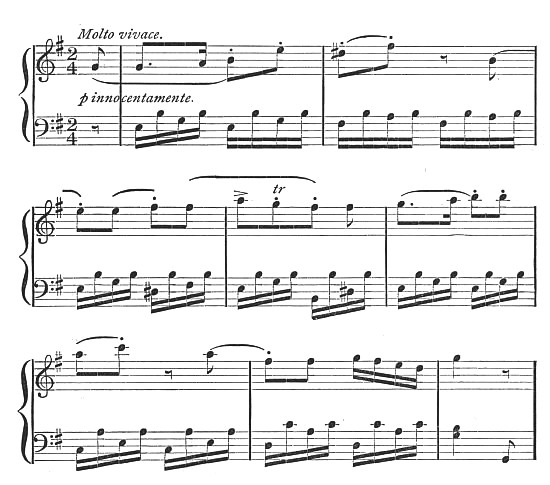
FIGURE XXIV.
Haydn's sonatas thus provide us with a link in the chain that binds Mozart to his predecessors. The foregoing [85] quotation from Haydn's second sonata will illustrate the primitive nature of some of his rondo themes (Figure XXIV). This theme is, in effect, a jolly dance tune without pretensions to dignity, and against it is placed a conventional pattern accompaniment.
Another rondo theme from Haydn may be cited to illustrate his gentle humor.
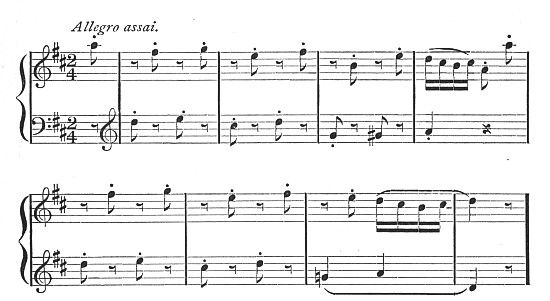
FIGURE XXV.
This has for its first episode, or secondary theme, the following vividly contrasting passage:
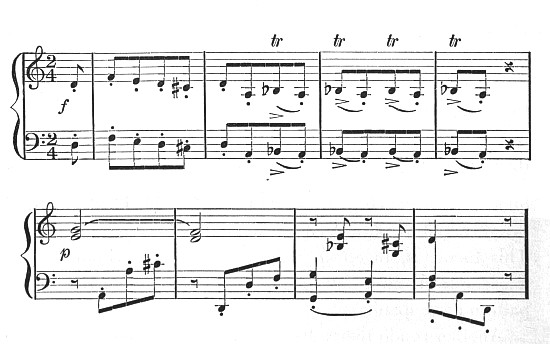
FIGURE XXVI.
These two quotations illustrate the childlike na?et? of Haydn's nature. He is never tragic; his pieces are like delightful pictures of rural life painted by an artist who was himself country born and bred and who feels the natural charm of the simplest, commonest things. Haydn's pictures are flooded with sunlight.
Wolfgang Amadeus Mozart (1756-1791), aside from his supreme greatness as a composer, represents the culmination of what is called the "Classical" period. The tendency away from strict polyphony and towards a free homophonic style has already been noted. It was the peasant-born Haydn who first subordinated polyphony, producing long instrumental pieces based on song melodies. His symphonies and string quartets are bubbling over with melodiousness. Often frankly adopting folk tunes, or inventing themes in the same style, he produced great works that depend hardly at all on the interweaving of themes, but have as their basis rather the exposition of single melodies as the raison d'?re of the music. Not by any means [87] lacking in erudition, Haydn turns to na?e melody as his natural means of expression.
Along with this element, and as a component part of what we call "classic," is that perfection of form and style that particularly distinguishes the music of Mozart.
"His works are often cited as the most perfect illustrations of the classic idea in music,—this term referring in a general way to the absence of individualism in conformity to a general type of style and form, na?et? as opposed to self-consciousness, symmetry of outline, highest finish of detail, purity of sound, loftiness and serenity of mood."—Dickinson, "The Study of the History of Music."
Mozart: Rondo from Piano Sonata in B-flat major.
This rondo is the last of the three movements of this characteristic sonata. Mozart's piano sonatas seldom have more than three movements, and of these the rondo is last, the plan being to present the more highly organized movements first, and to end, as in the suite, with a bright and cheerful piece. The rondos of this period were lively and rhythmically energetic. While not essentially dance-like, they nevertheless were ultimately derived from the dance, and lacked the meditative and sentimental qualities to be found in slow movements. It is from one of these two sources—the dance tune and the folk-song—that all these sonata movements sprang. Contributory streams entered here and there—the polyphonic influence is discernible; Italian opera lends its fluent vocal style and [88] occasionally its love of display in elaborate cadenzas; and, of course, the idiom of the piano—the peculiar manner of writing that the instrument requires—is always present.
The first theme of this movement, for example, suggests motion; one can almost imagine the opening section (measures 1-16) as suited to the first evolution in a dance, and the second (beginning at measure 16) as the strain intended for a new set of dancers, while the chords in measure 17 quite vividly suggest the steps of a dance. The left hand part is largely in the familiar idiom of the piano of Mozart's time, though there is occasionally polyphonic treatment—as in measures 1-8. The various divisions of the piece are strongly marked by cadences, sometimes preceded by formal patterns of scales, or other meaningless passages, as at 144-147, such as Wagner likened to "the clatter of dishes at a royal banquet." Sequences, so familiar in the music of Bach, frequently appear here, and were, indeed, a part of the phraseology of the time. The passage between measures 189 and 193 is, in this respect, especially notable because of the harsh dissonance between E-flat and D at measure 191.
The cadenza is an interesting and unusual factor in this rondo. A cadenza always occurred in certain types of operatic arias, and in the concerto was introduced to display the skill of the performer, but it is unusual to find one in a rondo.
FIGURE XXVII.
STRUCTURAL PLAN OF MOZART'S RONDO IN B-FLAT MAJOR.
| Section | Measures | Notes |
| A |
1-24 |
Chief theme in two sections (1-8 and 9-24), the last slightly extended. |
| B |
24-40 |
First contrasting theme in dominant. Measures 36-40 constitute a codetta to this section. |
| A |
41-64 |
Chief theme as before, but modulating (62) to the relative minor. |
| C |
64-111 |
Second contrasting theme in two parts: 1st in G-minor (64-75), 2nd in E-flat major (76-90). This section is concluded by a passage in C-minor based on motive from chief theme, and by a codetta (105-111) similar to that in B. |
| A | 112-148 | Chief theme as before, but extended. |
| B |
148-172 |
First contrasting theme now in tonic, and with an extended codetta. |
| A |
173-224 |
Free treatment of chief theme, and other material: motive from codetta extensively used (179-196); cadenza (198); epilogue, or coda (213). |
This rondo flows on happily from beginning to end without touching either great heights or depths. It is a good example of a style of piano music intended more for [90] the domestic circle than for the concert room. It shows that "absence of individualism in conformity to a general type of style and form" referred to by Dickinson, i. e., one does not feel in listening to it the obtrusion of a personal point of view; there are no idiosyncrasies such as are continually appearing in more modern music. There is here also that "purity of sound" that characterizes Mozart's music. There are no elisions, no subtleties of musical language, no suggested meanings such as one finds, for example, in Schumann. There is the same placidity, the same clearness of meaning, the same lucidity of diction that we find in the poetry of Mozart's day. Musical language was not then overlaid with secondary significance as it has since become.
An examination of Figure XXVII will reveal a considerable advance in this rondo over that of Couperin. The last section (A) in particular fulfills its office of providing, as it were, a kind of denouement to the whole piece; the interest is skillfully made to center or come to a climax here, and the stiff angularity that characterizes the older rondo is conspicuously absent. And while the scheme of harmonies in this rondo has many elements in common with that of "Les Moissonneurs," there are here excursions, by the way, into other keys giving variety and warmth of color. But, most important of all, the recurrence of the first contrasting theme (at measure 148) in the tonic key after having first appeared in the dominant (measure 24) gives to this piece a real strength, or stoutness of construction. It is as though there were certain strands in the [91] fabric that run entirely through it and make it firm, whereas the Couperin rondo seems to be made by putting together a series of little blocks.
Another important point of contrast between these two rondos is in the matter of themes. Where Couperin has only one, which he presents in a variety of charming forms, but from which little that is new is evolved, Mozart has three distinct contrasting themes, and a little codetta motive; and all these germinate, even if but slightly, into new musical developments. The codetta passage, in particular, sprouts and blossoms (179-196) in a most delightful manner, the little germ having first appeared (36) as an unpromising and monotonous succession of single notes.
We referred at some length, in the chapter on "The Dance and Its Development," to this germination of musical thought as of the greatest importance in composition. The reader will readily understand that the highest form of an art like music, in which the element of time enters as a vital matter—in which the message of the composer comes to us in successive sounds—must depend on something more than the beauty of its several and successive melodies. In the first place, the limit of such a succession would soon be reached; the mind, after having taken in a certain number of melodies, would lose track of the first ones and be left in utter confusion. The obvious device of repeating the first phrase or melody at the point where, otherwise, this confusion would result, has been the determining motive of many of the simple forms we have thus far studied. But this, after all, is a primitive method, and it is obvious [92] that its possibilities are limited. The rondo is, in effect, the furthest point to which this plan can go.
The fundamental quality in anything living—be it the state, the church, the family or the human body—is organism, the relation of all the parts to the whole. So in the greatest music as in the greatest literature, everything germinates from certain fundamental ideas, and nothing is extraneous. This rondo of Mozart represents a certain tendency of his to string beautiful melodies together—for his fund of melodies was well nigh inexhaustible. But he was too great a master not to see the weakness of such a procedure, and in works like his G-minor symphony he has left nearly perfect examples of this higher form of musical development;—perfect, that is, within his own horizon—a wider view was to unfold itself from that height to which Beethoven finally struggled.
SUGGESTIONS FOR COLLATERAL READING.
Parry: "The Evolution of the Art of Music," pp. 52 and 241. Dickinson: "The Study of the History of Music," Chapter XIV. Goetschius: "The Homophonic Forms of Musical Composition," p. 203. Mason: "Beethoven and His Forerunners," Chapter IV. Hadow: "Sonata Form," Chapter IX.
LIST OF SUPPLEMENTARY PIECES FOR STUDY.
Haydn: Finale of Sonata in D-major, No. 7 (Schirmer Ed.). Finale of Sonata in D-major, No. 9 (Schirmer Ed.). Mozart: Finale of Sonata in F-major, No. 17 (Schirmer Ed.).
FOOTNOTES:
[14] Sonata, originally from Italian "Suonare," to sound, as Cantata was from Italian "Cantare," to sing. Later the word Sonata took on a more precise meaning, which we shall study in later chapters.
[15] The name "Rondo" (Fr. "Rondeau") is derived from "round," and its application to pieces of the type we are considering was due to the constant recurrence of one principal melody.
[16] The first partial measure and all the other half measures where the double bars occur are counted separately, making 65 measures in the whole piece.
[17] The fixed part (A) in the Rondo of this period usually entered but three times instead of four as is the case here. Couperin's "La Bandoline" (in "Les Maitres du Clavecin") is another example of the extended form of the Rondo.
[18] Pauer's "Alte Meister" (Breitkopf and H?tel) contains several interesting Rondeaus by Couperin and Rameau. "Les Maitres du Clavecin," edited by Kohler (Litolff), Vols. X and XI, may also be consulted.
[19] The numbers referred to here are those of the Schirmer edition.
The process of musical development we have been considering in previous chapters has tended gradually but surely towards freedom of expression and, at the same time, definiteness of form. As this process has advanced, melodies have become less and less constrained, yet the forms themselves have crystallized into certain accepted types. The ideal of all this progress was unity and variety; in other words, composers felt the desire to expand their powers of expression and saw that this expansion must in the nature of things conform to certain ?thetic principles and obey certain laws. Mere luxuriance of speech without order or system means confusion; but order and system without living feeling means aridity. These two elements must go hand in hand, and in the music of masters like Bach, Beethoven, and Brahms they do.
The so-called variation form admirably illustrates these tendencies. From its very beginning down to the present day there has been a constant re-adjustment of its expressiveness and its formal interest; a constant attempt to strike the right balance between the two qualities. The form is almost as old as music itself. From the earliest times composers have felt the necessity of varying their tunes by one device or another. Even before the other [94] primitive forms had crystallized, crude variations existed, and we find old hymn tunes or popular songs repeated over and over again with elaborate changes of phraseology or with contrapuntal devices. Certain arid processes—such as writing a tune backwards—were sometimes employed, and a study of the whole range of the variation form in its early stages reveals a constant fluctuation.
Among the most interesting of these early attempts to solve the problem are certain pieces by the English composers for the harpsichord who lived in the latter part of the sixteenth century. John Bull (1563-1628), a chorister in the Chapel Royal of Queen Elizabeth, was one of the most famous of these, and he has left us several pieces in variation form, one of which, "Courante Jewel," is well worth our attention.
The courante (Fr. courir, to run) is one of the old dance forms that became imbedded in the suite, where it followed the opening[20] Allemande. This particular example of the courante illustrates the habit, common at that time, of writing pieces based on well known dance rhythms such as we have studied in Chapters IV and V. Composers attempted to provide further interest in their pieces by giving them special titles. We find, for example, one of Byrd's harpsichord pieces called "Galiardo, Mrs. Mary Brownlo," and one of Bull's entitled "Pavana, St. Thomas [95] Wake." This tendency in English music towards definiteness of idea, and away from all that is vague, has been already noted in our chapter on "Folk Songs."
The "Courante Jewel" is an interesting example of a form of variation that has now become practically obsolete. It consists of four separate melodies, each immediately followed by its variation. The plan might be expressed by the following formula: A, a; B, b; C, c; D, d, the large letters representing the themes and the small letters the variations. The first theme begins as follows:
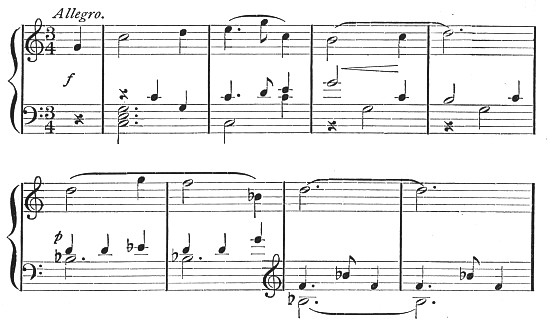
FIGURE XXVIII. From first theme of Bull's "Courante Jewel."
The complete theme is sixteen measures long and is divided off into phrases of regular length. This is immediately followed by the variation, the corresponding portion of which will be found in Figure XXIX.
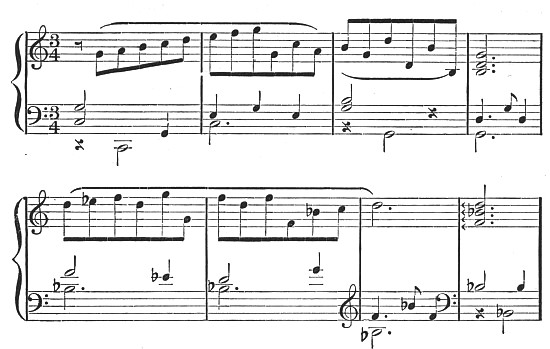
FIGURE XXIX. Part of the variation.
In Figure XXX are shown the first phrases of the second, third and fourth melodies, in order that the reader may see how distinct is each one.



FIGURE XXX.
This little piece illustrates what has been already said about freedom of expression. It does not impress us as [97] strictly dance music; it is manifestly written for its own sake and represents that natural tendency to create something beautiful which underlies art everywhere. But in respect of order and design we find here a decided weakness. Four separate and successive ideas, each followed by an elaboration of itself, would make a poor model for any art. One feels a sense of vagueness after listening to a piece so constructed; no single idea dominates; one longs for some point upon which the attention may be centered.
Pauer's "Alte Meister," Vol. I, contains another interesting experiment in the variation form, a "Gavotte and Variations" by Rameau (1683-1764). The opening phrase of this Gavotte runs as follows:

FIGURE XXXI. First phrase of Gavotte by Rameau.
In the variation of the above, which will be found in Figure XXXII, the theme is presented less definitely than in the original, while the upper part in sixteenth notes makes a kind of free counterpoint.
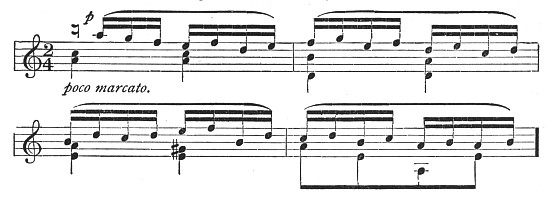
FIGURE XXXII. First phrase of Variation by Rameau.
What has been said in our last chapter of Couperin's harpsichord pieces applies to these variations of Rameau. There is in them a kind of refinement and delicacy that characterizes all the French music of that period. The theme itself is less na?e than that of the "Courante Jewel," and more suggestive of the slow movement themes of the sonatas of later composers. In fact, this has in it little of the real Gavotte, its meditative quality is too strong and its rhythms too weak.
These two compositions admirably illustrate the general striving for some ordered means of expression in secular music that characterizes the seventeenth century. It was a time of groping. Sacred music had largely occupied the attention of composers, and few paths had been opened for those who desired other means of expression, so that the problem of secularization was the all-important one. It must also be kept in mind that this particular advance could not take place until musical instruments and the technique of playing them had been perfected. As late as 1571 Ammerbach's "Orgel oder Instrument Tabulatur" [99] was published, forbidding the use of either the thumb or little finger in organ playing, and writers of the seventeenth century speak of certain uses of the thumb in playing as "daring innovations." Couperin in his "L'Art de Toucher le Clavecin," published in Paris in 1717, advocates a system of fingering that still uses the thumb in a clumsy manner, and it was not until John Sebastian Bach's method of tuning by "equal temperament" and his new system of fingering came into use that music for the harpsichord and clavichord was freed from the old incubus of an awkward mechanical technique. For it is obvious that an art can never reach anything like perfection as long as its working materials are inadequate. In piano playing, for example, one could not use chords spread out far beyond the grasp of the hands until the sustaining pedal had been invented. While these conditions existed, composers naturally turned their attention to sacred music and to the opera, where there were fewer limitations.
Among the many examples of the variation form produced in the time of Couperin and Rameau the most important are those of Bach and Handel. Since we are here dealing with the precursors of the sonata and symphony and with the development of homophonic music, we shall not discuss Bach's celebrated "Goldberg Variations," which are masterly examples of his intricate and vivid polyphony, but shall turn to a set of variations in more modern form by Handel. The reader may, however, consult the second Sarabande accompanying Chapter V for an example of Bach's method of elaborating a given theme.
Our chapter on the suite has given the order in which the various dances usually appeared, and mention was there made of the exceptions occasionally to be found among the works of adventurous composers.
George Frederic Handel (1685-1759) composed a set of "Suites de Pi?es pour le Clavecin" containing several movements not usually found in the suite form. Among these are "Allegros," "Prestos," and "Arias con Variazioni," while in Handel's "Sonatas" are to be found sarabandes, gavottes, and bourre?. In other words, the suite and the sonata, as conceived by Handel, are more or less convertible forms; it is not until the next generation that the modern sonata begins to emerge in the pianoforte works of Philip Emanuel Bach. (See Chapter VIII.) These distinctive pieces represent the groping of composers after some new and more flexible medium of expression than that provided by stiff dance forms. And this same fundamental principle of growth is what, many years later, led Beethoven to enlarge the scope of the sonata, and still later produced the symphonic poem of Liszt and other modern composers.
Each phase of an art has its culmination where a medium becomes perfected—and therefore exhausted; where the flower blooms and dies. This point is reached when some great master unites in his works two essential qualities complementary to each other, namely, the idea and its formal investiture. Such a point was reached in Bach's [101] Fugues, in Mozart's Symphonies, and in Beethoven's String Quartets; in all these the two great elements of perfection were united. In Mozart's G-minor Symphony, for example, the thing said, and the manner of saying it—the design, the orchestral expression, etc.—are identical, but in the instrumental works of Handel the matter was still in process.
"The Harmonious Blacksmith" is in the fifth of the "Suites de Pi?es pour le Clavecin," commonly known as "Lessons," and composed for Princess Anne, Handel's royal pupil, daughter of the Prince of Wales. This suite consisted of the following pieces:—I. Prelude, II. Allemande, III. Courante, IV. Air.
Handel: "The Harmonious Blacksmith," from the Fifth Suite for Clavichord.
The biographies of Handel give several versions of the story supposed to be connected with this little piece. It seems to be quite certain that the composer never used the title, and that it has one at all is probably due to the fact that the public seems to like a piece better if it is supposed to be "about" something. Many similar uses of supposititious titles will occur to the reader, as, for example, the "Moonlight" sonata of Beethoven, and the "Rain-drop" prelude of Chopin, neither of which grotesque names was ever sanctioned by the composer. If this tune of Handel's ever was sung by a burly smith at his forge he was indeed an "harmonious" blacksmith. In any case, it is a matter [102] of record that the identical anvil was finally "discovered" by a Mr. Clark and found a resting place as a curio in an "Egyptian Hall" in London.
The tune itself has qualities familiar enough to students of Handel's instrumental music. Its final cadence, in particular, is thoroughly Handelian, and all through it there is that decisive and assertive manner that characterizes the melodies of this great man. There is nothing of the mystic about Handel; his oratorios and nearly all his smaller pieces have a straightforward and uncompromising style. He never gropes; his music speaks of an unfaltering self-confidence, unclouded by doubts.
The methods of treatment in the variations is a simple one. The harmonies remain the same throughout, while the melody is changed in various ways. In variation I, for example, the first two notes of the original melody have been made into an arpeggio, or broken chord, and this treatment persists throughout. In variation II the melody loses something of its physiognomy, and is only suggested by occasional notes in the upper or lower part for the right hand, while the left hand plays a familiar pattern accompaniment. Variation III plays lightly with the original theme, hovering around it with delicate scale passages.
This variation illustrates an important principle of musical appreciation. Played by itself, without reference to what has preceded it, it would be so lacking in definiteness as to be uninteresting; its connection with the original theme, however, lends to it a certain charm and significance. So in the longer instrumental pieces of the great masters [103] who followed Handel, we find whole sections whose meaning depends on their relation to what has preceded them, and our appreciation of the significance of such passages is in exact proportion to our powers of co-ordinating in our own minds these various sections of a work, often separated from each other by a considerable lapse of time.
The fourth variation is like an inversion of the third, the left hand now taking the rapid scale passages. Variation V is the least definite of them all, being made of scales played against chords that dimly outline the original melody.
"The Harmonious Blacksmith" is not a highly developed piece of music, for it lacks one essential element—in an instrumental piece as long as this there should be some germination. The several variations of this melody are merely slightly altered versions of the original idea; in highly developed specimens of this form each variation is a new creation germinated from the parent thought.
Reference has already been made in our chapter on "The Rondo" to the great advance in pianoforte music brought about by Philip Emanuel Bach and Haydn, but Haydn's Andante with Variations in F-minor is still more mature than any of the pieces to which we referred. In fact, this Andante is Haydn's most charming pianoforte piece, uniting as it does the best of his qualities. It is the first composition in homophonic style we have studied in which the interest of the listener is constantly engaged from beginning to end. There are here no bald repetitions, [104] as in the Rondo of Mozart, no meaningless accompaniment figures, no conventional endings, but from first to last Haydn tempts us onward by constantly unfolding new beauties, yet never leaves us vaguely wandering, doubtful of our starting point. In short, this andante is a fine example of a well organized piece of music; it is full of variety, yet its unity is unmistakable.
Haydn: Andante with Variations in F-Minor.
It is unusual for a variation theme to be in two distinct parts, as is the case here. The chief theme in F-minor is followed by a "trio" theme in F-major of quite a distinct character. This is one of the many interesting experiments of Haydn in devising new forms or combining old ones. The weakness of this arrangement is that the whole theme is a little too long; it lacks the conciseness that is necessary to a theme that is to be treated in a long series of variations. The trio theme is also less interesting than the first theme and does not lend itself so readily to variations.
An important principle of musical development is involved here. It will be found from an examination of the music of the great composers that the most perfect lyric melodies do not germinate, whereas themes like the first theme of this andante, the first theme of Beethoven's Fifth Symphony—which are not by any means beautiful lyric melodies—are pregnant with possibilities. Any perfect melody like "Annie Laurie," for example, is a [105] complete thing; nothing can be added to it or taken away from it. The two themes just mentioned, on the contrary, are made up of motives which are characterized by some individual quality and which contain certain potentialities that are realized only as the piece progresses. And in general it may be noted that the distinctly lyric composers, such as Schubert, Schumann, and Grieg, have not been conspicuously successful in those larger forms where this principle is most operative.
The little motive of five notes with which the right hand part of the andante by Haydn begins illustrates this. There is hardly a measure of the original theme and of its variations in which this motive is not heard, and the variety Haydn imparts to it is quite remarkable. The trio theme, on the other hand, is more lyric—more song-like, and, as a consequence, we find the variations consist of elaborate ornamentations of the theme rather than of new ideas germinated from it.
Variation I is a particularly interesting example of Haydn's style. The syncopation in the right hand part, with its delicacy of utterance, and its occasional tender poignancy (as at measure 52) gives to this portion of the piece an unusual charm. The transposition of the syncopation to the left hand (at measure 56) is particularly interesting because of the delicate dissonances that result. The passage at measures 83-88 might almost have been written by Rameau or Couperin, so full is it of trills and other ornaments. This is in the old harpsichord style of the generation before Haydn.
Variation II preserves the harmony of the original theme, but supplants its melody by a fluent and interesting passage in sixteenth notes that passes at will from one hand to the other.
These two free variations, through which the original theme has dimly shone, are now succeeded by a finale, so called, in which the theme is presented in its simple form as if to bring the listener home again after his excursions afield. And here, it should be specially noted, Haydn omits all reference to the trio theme, as if conscious of its inferiority. The whole finale (from measure 147) is a kind of dramatic summing up of the story, and serves much the same purpose as that of the restatement in ternary form.
The passage between measures 195 and 200 is an interesting example of a process common in pure music. Here the motive of three notes (in right hand), derived from the original five note motive in measure 1, gradually loses its physiognomy until its characteristic outline has entirely disappeared and it has become a purely conventional figure. A celebrated example of this process is shown in Figure XXXIII from the first movement of Beethoven's String Quartet, op. 59, No. 1.

First phrase of Theme from Beethoven's Quartet, op. 59, No. 1.
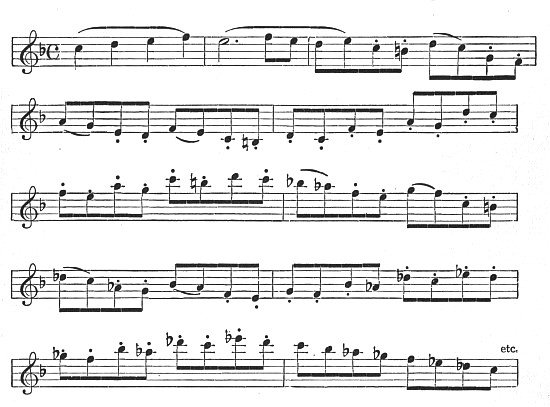
Passage from Development Section.
FIGURE XXXIII.
The passage from which the second of the quotations is taken is one of the most beautiful in all chamber music, and the whole development section in this wonderful movement will repay the closest study.
Haydn's andante ends with a few tender allusions to the persistent motive of the original theme, which faintly echoes in pathetic cadence. Such passages endear Haydn to us because of their genuineness. There is nothing false in his sentiment; he is always straightforward, he always writes unaffectedly. Among the great composers he stands apart as a simple-hearted man, who was without guile, and who retained to the end of his life the same childlike na?et?.
The general characteristics of dances like the minuet, gavotte, etc., have been referred to in Chapter IV, where the inclusion of the minuet in the sonata and symphony of the classical period was noted. We are here chiefly concerned with the effect of this inclusion on the minuet itself and with its status in the group of movements that made up the cyclic form.
The minuet is a dance of French origin, characterized by stateliness and grace. The earliest music written for it consisted of one melody containing two eight measure phrases. These were gradually lengthened, and finally a second minuet was added as in the gavotte. Bach used the minuet sparingly in his suites. The reader is referred to the fourth English Suite, which contains a minuet followed by minuet II, not called "Trio." Handel occasionally incorporates the minuet in his suites and frequently uses it as the last movement in his oratorio overtures. All these old minuets were in slow tempo, but the desire for freedom of expression impelled composers not only to expand them in various ways, but, finally, to increase their speed. This important change was doubtless largely inspired by the desire for contrast in the movements of the symphony, for in the sonatas of Haydn and Mozart we find the middle movement usually an andante or adagio, and when the minuet[21] is incorporated it is in slow tempo.
Practically all the minuets of Bach and Handel as well as those of the Haydn-Mozart-Beethoven period were written in what we have called "simple ternary form," the second minuet, or trio, constituting the middle section, B. Occasionally a minuet with two trios appears, in which case the form becomes A, B, A, C, A. Marches (which are commonly in simple ternary form) are quite frequently written with two trios, the most familiar example being the well known wedding march by Mendelssohn.
The symphonic minuet is the only relic of the suite retained in the sonata and symphony. The changes it underwent through this promotion from the ranks of the old dances were not only changes of tempo, but of spirit or essence. For whereas it had been demure, conventional, and stately, as if pervaded by a kind of courtly grace, it became in Haydn's time a wayward, humorous, and even frolicsome member of musical society, and provided a certain lightness and spontaneity much needed in the sober symphonic family.
The reader is urged to consult any of the minuets to be found in the string quartets or symphonies of Haydn and Mozart. These popular short movements are so available in arrangements for the piano that it is not thought necessary to incorporate one here.
SUGGESTIONS FOR COLLATERAL READING.
Grove's Dictionary: articles "Minuet," "Sonata," and "Symphony." Shedlock: "The Pianoforte Sonata." Mason: "Beethoven and His Forerunners."
Undoubtedly the most important of all musical forms to-day is the sonata, as will easily be recognized if we remember that not only the pieces which bear this name as a title, but also the numerous symphonies, overtures, concertos, and trios, quartets, quintets, and so on, are examples of this form. The symphony is simply a sonata, on a large scale, for orchestra; the overture is a similar piece for orchestra, in one movement; the concerto is, as it were, a symphony with a solo instrument emphasized or placed in the foreground; trios, quartets, quintets, etc., are sonatas for various groups of string and wind instruments. Thus it will be seen that the bulk of all instrumental music is cast in this ever available and useful form of the sonata.
At this point, however, a confusion is likely to arise from the fact that the term "sonata" is used in two senses. It means sometimes a complete piece of music in three or more distinct movements; at other times it means a scheme or plan of musical structure exemplified in one or more of these movements, usually the first. When used in this sense it is generally coupled with the word "form": this is [111] the way in which we shall use it here, letting "sonata-form" mean this peculiar type of musical structure, to be described in detail presently, while using "sonata" alone to name a complete composition of which one or more movements are in "sonata-form."
The sonata, as written by Philip Emanuel Bach, Haydn, Mozart, Beethoven, and modern composers, usually contains some movements in forms more primitive than "sonata-form," and already familiar to us. Thus the minuet, which often appears as the second or third movement of a sonata, has changed little since Mozart's day; the rondo, frequently used in the finale of a sonata, remains in all essentials as it is presented in the last diagram of Chapter VI; and the theme and variations, so far as its formal plan is concerned, has remained very much as Haydn left it, although, in common with the rondo, it has been vastly enriched in content and diversified in style by the genius of Beethoven.
The element of true novelty in sonatas is to be found, not in these primitive movements, but rather in those movements which are in "sonata-form," and which show a breadth of conception and an elaboration in development never found in simple lyric forms like the minuet. This breadth and elaboration is always the result of a germination of musical thought, such as we have already often mentioned, and by virtue of which alone a composition can take on real grandeur of proportions. The essentials [112] of sonata-form are (1) the presentation of two or more themes or subjects in that section known as the Exposition, and symbolized in our diagrams by the letter A; (2) the evolution of these themes, by means of melodic germination, in that section known as the Development, and symbolized by B; and (3) the restatement of the original themes, rounding out the movement symmetrically, in the section known as the Recapitulation, and symbolized again by A on account of its practical identity with the Exposition. It matters not which movement of a sonata takes this characteristic form, whether, as in the majority of cases, it is the first (whence the term "first-movement form," often used as a synonym for "sonata-form") or the slow movement, as often happens, or the finale. Wherever sonata-form exists we find this three-part sectional structure, resulting from the natural germination in the middle section of the musical ideas stated in the first, followed by their restatement in the third section.
The reader may ask at this point, in what respect such a form differs from the simple ternary form illustrated in a minuet, for example, wherein the second section usually contains some development of the theme, and the third some recapitulation. The answer is that in the sonata-form the enlargement of the proportions throughout results, first, in the substitution of complete and more or less contrasting themes, for the rather slight musical subject of a minuet, and second, in the substitution of a long and elaborate development of these themes for the rather casual and superficial modification of the subject which [113] forms the second section of a minuet. Moreover, in the sonata-form a novel feature is the contrast introduced by making the first section embody duality of key (first theme in tonic, second in related key) while the third section, by presenting both themes in the tonic, embodies unity of key. Nevertheless it remains true that sonata-form is, both logically and historically, a development of such simple forms as we have in the minuet, as is indicated by the name of "developed ternary form" often given to it.[22]
Sonata-form is thus but an extreme application of certain essential principles of structure exemplified in simple ways in other more primitive musical forms, and for that matter in many other departments of life. It is perhaps not over-fanciful to discover the same principles in the construction of a novel, in which we often find: first, the presentation of certain characters, more or less in antagonism; second, the development of the plot and of the characters themselves; and third, the reconciliation of the characters in the denouement. Similarly, a sermon consists of (1) the assertion of a text or subject of discourse, (2) the illustration of its truth by examples and other elucidations of what is implied in it, and (3) a final restatement of it with the greater force made possible by its discussion. Or again, we may see striking analogies to the artistic form we are considering in such processes of nature as the budding, flowering, and death of a plant, or in human life with its youth, its period of activity, and its time of retrospect.
Sonata-form, historically speaking, first takes definite shape in the work of Philip Emanuel Bach (1714-1788), the most distinguished of the sons of the great Sebastian Bach. Though not a man of the highest creative genius, C. P. E. Bach possessed an ingenuity and a pioneering spirit which led him to make innovations so important that Haydn and Mozart freely acknowledged their debt to him. Feeling that music in the polyphonic style had reached its full development, he was original and adventurous enough to seek new means of expression and a novel combination of features of style already familiar.
In order to understand the situation that confronted him we must put aside temporarily the impressions we have received from the Andante of Haydn and the Rondo of Mozart, since both these compositions were produced at a time when his influence had already made itself felt. He had to face the problem of writing instrumental music that should be free from the constraining influence of the dance, of polyphonic style, and of the elaborately ornamented style of operatic music. He had also to find out how to unify a long piece of instrumental music by co-ordinating all its parts. The only solution of these problems lay in inventing what might be called pure instrumental melody: i. e., melody that was essentially expressive in the particular medium employed—the piano, the violin, the orchestra—and that was unhampered either by strict poetic or dance forms, or by the peculiar phraseology of [115] polyphony. He did not, to be sure, entirely achieve this; we find evidences of both the older styles in his music. But an examination of any instrumental masterpiece of Beethoven will reveal how much he owed to the pioneer labors of C. P. E. Bach.
We must here caution the reader against the supposition that music at this particular time leaped suddenly forward. The tendencies that we have been speaking of were latent long before Philip Emanuel Bach appeared, and there was no strict line of demarcation where one kind of music stopped and another began. Organic development never progresses in that way; each phase of it begins slowly, becomes eventually operative, and dies as slowly as it began. And there were other composers working at that time on the same problems; composers who were of considerable importance then, but whose names are now forgotten.
Philip Emanuel Bach: Piano Sonata [23] in F-Minor, First Movement.
This Sonata has three movements: 1. Fast (Allegro assai); 2. Slow (Andante cantabile); 3. Slow (Andantino grazioso). The third of these is marked "attacca" to indicate that the usual pause between the movements is to be omitted. In the second and third movements the themes themselves and their treatment reveal the tentative nature of Bach's efforts. Each of these themes is over-embellished; each has something of the vagueness usual in piano music of his time, and yet there is a distinct tendency [116] towards definite, strophic melody such as is common in the sonatas of Haydn and Mozart.
But the first movement of this sonata of Philip Emanuel Bach's is quite remarkable. Its theme is definite, its phraseology clear and concise, and its form well rounded. In fact a comparison of the opening measures with those of the theme from Beethoven's first sonata will reveal a decided similarity. Beethoven's theme is constructed from a figure or phrase, ascending like an arpeggio higher and higher, until a climax is reached, after which the melody dies down to a pause or half cadence on the dominant chord. This is precisely what happens with the theme of Philip Emanuel Bach, although the second half of the theme is more regular than Beethoven's, the complete melody being in what might be called "verse form," each two-measure phrase corresponding to a line of verse.
More important still, however, is the quality of the melody itself. It is distinctly in the style suitable for the piano; there is no evidence of the old song melody, nor of polyphonic phraseology, nor of dance tunes. This is, in short, one of the earliest examples of pure pianoforte music, using the term in a modern sense. Another interesting point in this movement is the presence of two contrasting themes in the Exposition. "The principle of alternately stating two contrasting themes, which found its ultimate expression in the successive presentation of first and second subjects, had been familiar to the musical world as long as minuets and trios, gavottes, musettes, and the like, had been in vogue, but the process by which [117] the two subjects are allowed to be interwoven with each other, or to generate, as it were, new material having its origin in something that has gone before, opened out a world of fresh possibilities to the composers of the later times, and gave them opportunities which had been altogether withheld from Bach and his contemporaries." "Oxford History of Music," Vol. IV, p. 141. The two themes constitute the material out of which the whole movement grows or germinates, so that they somewhat resemble characters in a story, and this analogy is further carried out in the quality of the themes themselves, the first being usually vigorous and to a certain degree non-lyric, while the second is lyric and more sentimental; as if one were masculine and the other feminine.
But in this movement of Philip Emanuel Bach's Sonata the second theme is hardly more than an embryo. It begins at measure 16, and occupies only ten measures, the last five of which are somewhat vague and rhapsodical. Thus its entire effect is somewhat indefinite, and if we compare it with the second theme of any modern sonata we shall realize that it is very imperfectly individualized. The second theme did not become an essential and distinct element of sonata-form until somewhat later; in Philip Emanuel Bach, and even in many movements of Haydn, it remains completely subordinate to its more important companion, the first theme. Following the second theme—at measure 26—a coda ensues. This important factor in musical form has been already referred to in our chapters on "The Rondo" and "The Variation." Its [118] office here is the same as in former examples, namely, to round out this part of the movement properly and to emphasize the close of the first section.
The exposition (A) extends through measure 34 and is concluded with a double-bar. During the period from Philip Emanuel Bach to Mozart this portion of the movement was always repeated in order to make it perfectly familiar to the listener. The development section begins immediately after the double-bar and extends to the point where the first theme returns in its original form; in this movement that point is reached at measure 66. We have already pointed out certain simple methods of generation in music, as in the Bach Gavotte discussed in Chapter IV, but we now have to consider the growth of a long section of a composition from certain germs contained in the original theme. And this brings up an important question: How do musical themes generate? In the Bach Gavotte a brief phrase of one measure duration blossoms out into a passage six measures long. This may be observed by reference to Figure XXXIV, in which (a) represents the original phrase and (b) the expansion of it.

(a.)

(b.)
FIGURE XXXIV.
This development, however, is hardly more than an extension of the original phrase. For the purposes of sonata-form something more radical and far reaching, something more like new creation is necessary. Without going into detail[24] we may be content with pointing out the essential principle of this more radical development. Analysis shows that it always depends on the selection of certain salient characteristics of the original themes and representation of them under new guises, or under new conditions.
Just as a novelist develops his characters by letting their fundamental peculiarities manifest themselves in all sorts of ways and among all kinds of circumstances, meanwhile paying but scant attention to their more accidental or superficial traits, so the composer of a sonata seizes upon whatever is individual in his themes—a strong rhythm, a peculiar turn of phrase, a striking bit of harmony—and repeats and insists upon it tirelessly, with whatever variation of minor details his ingenuity may suggest. An examination of this process of generation in the works of Haydn and Mozart will make these important points clear. In Figure XXXV (a), is shown a brief quotation from the beginning of the first movement of Haydn's Symphony in D-major. Although this theme has no pronounced rhythmic figures the four repeated notes in measure 3 are unusual in a simple melody of this type, and Haydn chooses them (with the first two notes in the next measure) as the first subject of his development section.

(a)
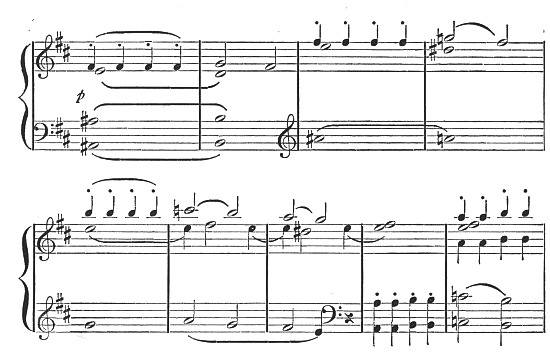
(b)
FIGURE XXXV.
At b in the above quotation will be found a short passage from the beginning of the development section of the same movement. This passage illustrates the detachment of a characteristic motive in a melody, and here the use of it in various keys as a means of setting forth, as it were, its latent possibilities. Here a certain element in the theme is freed and takes on an existence of its own, and until the very end of the section we hear it over and over again in different parts of the orchestra.

(a)
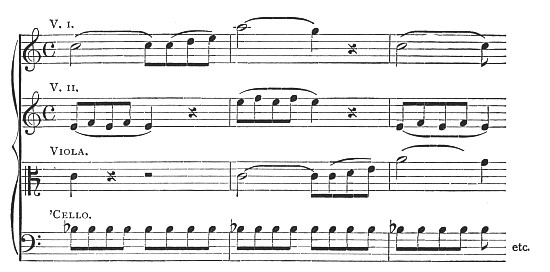
(b)
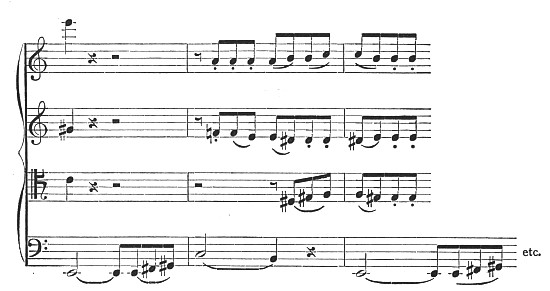
(c)
FIGURE XXXVI.
The methods of germination employed by Haydn in the foregoing illustration were typical of his time. Mozart commonly relies, in his development sections, on the interest provided by presenting some salient motive in a variety [122] of keys and with polyphonic treatment. Examples of this are to be found in Figure XXXVI, containing (a) the original motive from the first movement of his string quartet in C-major, dedicated to Haydn, and (b), (c), short excerpts from the development section of the same movement.
It will be observed that in (b), the viola imitates the first violin while the second violin and 'cello reiterate the four eighth-notes of the original motive, and that, in (c), the 'cello takes the motive, while each of the three upper parts sounds the eighth-notes, staccato; the contrasts of key should also be observed. This is a very concise and logical example of the methods of generation employed by Haydn and Mozart.
The first theme of the movement by Philip Emanuel Bach has two salient qualities: it progresses by leaps upward, and it has a peculiarly noticeable rhythm. These two properties are brought into play almost immediately. After a brief statement of the opening phrase of the theme (36-39) in the relative major key—as if to tell us what is to be the subject of this part of the movement—the composer proceeds to evolve a passage (40-44) with chords (in the right hand) in the rhythm of the theme, and against them (in the left hand) a passage containing the leaps upward. This is further varied by free changes in harmony.
The initial phrase of the first theme and a brief quotation from this passage in the development section are shown in Figure XXXVII.
This development is, however, all too short. After [123] measure 44 the music becomes discursive, showing no longer any definite bearing on the original subject matter.
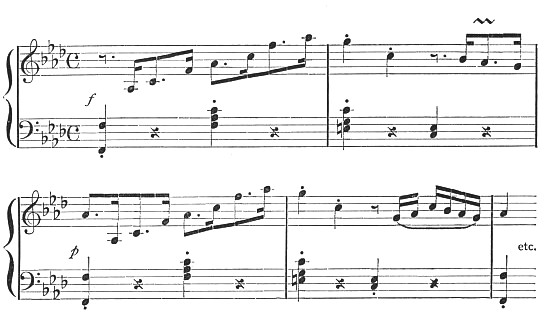
(a)
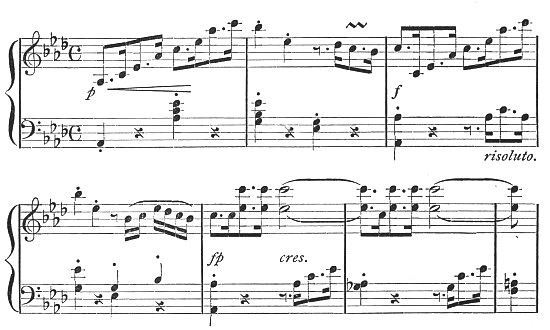
(b)
FIGURE XXXVII
This discursiveness is a natural characteristic of the formative period in the evolution of sonata-form, before composers [124] had learned the necessity of a close logical development throughout.
The "restatement after contrast" in sonata-form is commonly known as the "recapitulation." In the early specimens of the form the recapitulation was, except in its harmonies, almost identical with the exposition. Here the first theme is reduced to one half its original length, which is rather an unusual abbreviation. Mr. Hadow, in his "Sonata Form," lays down the following rule for this portion of the movement: "The recapitulation should not contain any noticeably fresh material; it should follow the main thought of the exposition with no important parentheses or divergences, and, when it varies, should do so in a manner which does not obscure the subjects, but only sets them in a new light."
In Figure XXXVIII is shown the foregoing plan in the form of a diagram. This should be compared with the similar diagrams in Chapter IX.
FIGURE XXXVIII.
TABULAR VIEW OF SONATA-FORM, OR FIRST-MOVEMENT FORM.
| A Exposition |
B Development |
A Recapitulation |
| Introduction (optional) Theme I, usually followed by a short transition, or link Theme II in contrasting key |
This section is based on themes already presented in the Exposition |
Theme I. Transition (?) Theme II in tonic or home key |
| Coda | Coda | |
| (Duality of harmony) | (Plurality of Harmony) | (Unity of Harmony) |
There remains to be considered the important factor of harmony, or arrangement of keys. This arrangement is shown in the diagram, Figure XXXVIII; but the principle involved is an important one, and the mere statement of Duality, Plurality and Unity hardly suffices to explain it. There seems to be no doubt that the subtle uses composers make of harmony are less intelligible to the average listener than are the uses of themes. A theme represents, as it were, a line, and since it is the tune that, for most listeners, constitutes the music the attention of the listeners is readily drawn to changes which materially affect it. Harmonic design, on the other hand—the setting of one key or series of keys against another—is often only dimly recognized, if at all, although it is of the greatest importance in all modern music. In sonata-form the harmonic plan (described above by the terms Duality, Plurality and Unity) adds an important element since it unifies the last section by stating both first and second theme in the same key. And in the middle, or development section, the freedom of harmonic progression—the multitude of keys—gives great variety and enables the composer freely to indulge his fancy.
In the present movement Bach chooses at times certain remote keys that impart to this section of the piece a charm of their own. The passage beginning on the second beat of measure 54 illustrates this: the four measures that follow are all in the remote key of F-flat major. (The reader should [126] examine each of the modulations that occurs in the development section.) However unconscious of the charm of harmonic variety the average listener may be, he would surely be conscious of monotony were the piece all in one or even two keys. And since the tendency of the music of to-day is to exalt harmony at the expense of melody, it is desirable that the student should pay particular attention to these early phases of harmonic structure, so as to be able to appreciate this important element in modern music. In fact the whole progress of music since Haydn has been steadily onward towards a free use of the different keys, and as our ears have become accustomed to new combinations of chords, we have gradually come to feel the beauty that lies in glowing musical colors, and to accept them as a legitimate means of expression. In our chapters on Beethoven this phase of musical development will receive fuller attention.
In this movement of C. P. E. Bach, despite its many crudities, there is taken a long step toward the establishment of modern sonata-form. The main divisions of the form, exposition, development, and recapitulation, appear clearly; solid harmonic structure is attained by the sequence of duality, plurality, and unity; there are two contrasting themes, though the second is rudimentary; the general principle of development of themes through insistence on salient features is illustrated; and the whole movement is written in a style well suited to the piano, and emancipated [127] from the influence of polyphony and of the short dance and song forms.
In the next chapter we shall see how Haydn and Mozart proceeded to build more elaborate structures on the foundation thus laid by C. P. E. Bach.
SUGGESTIONS FOR COLLATERAL READING.
Dickinson: "The Study of the History of Music," Chapter XIV. Grove: "Dictionary of Music," articles on "Bach, Philip Emanuel," "Sonata," "Form." C. H. H. Parry: "Evolution of the Art of Music," Chapters VII and IX (Appleton). "Oxford History of Music," Volume IV.
FOOTNOTES:
[22] It will be noted that there are three names for this one type of structure: "Sonata-form," "First-movement form," and "Developed ternary form."
[23] No. 1 in the edition by Peters, Leipzig.
[24] See Hadow's "Sonata-Form" (Novello) Chapter VII, for a discussion of the various methods of theme-development.
The type of musical structure which first took on definite shape in the work of Philip Emanuel Bach, the type which may be defined as consisting essentially of the exposition, development, and restatement of two contrasted themes, and to which the name of sonata-form is given, was not reduced to perfect clearness until the time of Haydn (1732-1809), who because of his labors in this field is often called "The father of the symphony."[25] Having the inestimable advantage of being concert-master, for a period of thirty years (1761-1791), to the princely house of the Esterhazys, where he had a small but good orchestra under his direction, and was expected constantly to produce new pieces for it to play, he was practically forced to write an astonishing amount of music, in all of which this form figured prominently. Hardly one of his hundred and twenty-five symphonies, and his seventy-seven string quartets, etc., is without one or more examples of sonata-form. Such constant practice enabled him to carry it far beyond the rather indeterminate state in which [129] Philip Emanuel Bach left it, and to crystallize it as a structural type for all time.
Among the most important advances made by Haydn over the practice of his predecessor, as we saw it illustrated in the last chapter, were (1) the greater importance and individuality given to the second theme[26]; (2) the abolishment of merely rhapsodical passages, and the substitution of successions of chords marking off unmistakably the various sections of the movement; (3) increased definition at the end of the exposition section, in the "codetta," which, in some instances, even has a definite theme or themes of its own, called conclusion-themes; (4) greater clearness in the key-system of the whole movement, according to the principle of Duality-Plurality-Unity already discussed; (5) increased importance and extent of the coda, which sometimes grows to the proportions of a fourth section to the movement; (6) use of an introduction, generally in slow time and of a stately character, preparing the mind for serious attention. It will be noted that all these advances are in the direction of making the form more definite, clear-cut, and readily intelligible, as it was most important that it should be made in its early existence until it was perfectly familiar to the audience. Increased variety came later, in the work of Mozart and Beethoven, and could come only after the typical structure was thoroughly [130] understood by the public. Thus Haydn's function was that of a systematizer, an establisher of sure foundations on which more elaborate and free superstructures may later be built; and for this work his clear, simple, well-disciplined mind and his thorough rather than brilliant artistic technique admirably fitted him.
These points will be made clear by an analysis of an example of sonata-form, taken from the "Surprise" Symphony which he wrote for London audiences in 1791, toward the close of his career.
The general structure, as regards both themes and larger sections, may be conveniently shown in tabular form, thus:—
TABULAR VIEW OF STRUCTURE OF THE FIRST MOVEMENT OF
HAYDN'S "SURPRISE" SYMPHONY.
| Main Divisions. | Themes. | Measures. |
| Slow Introduction | 1-17 | |
| Exposition (A) | First theme, G-major | 18-22 |
| Passage work | 22-39 | |
| First theme, repeated | 40-44 | |
| Duality of Harmony | Transition to key of D-major (Dominant) | 44-67 |
| Second theme, D-major | 67-80 | |
| Third, or Conclusion theme, D-major | 81-93 | |
| "Cadences," emphasizing close in this key | 93-108 | |
| Development (B) | ||
| Plurality of Harmony | 109-156 | |
| Recapitulation (A) | First theme, G-major | 156-160 |
| Passage work | 160-185 | |
| Second theme, now in G-major | 185-196 | |
| Unity of Harmony | Further working of First theme | 196-231 |
| Conclusion theme, now in G-major | 231-244 | |
| "Cadences," emphasizing the home key of G-major | 244-259 |
Haydn:[27] "Surprise Symphony" the first movement. Two-hand piano arrangement of twelve Symphonies of Haydn.
The first thing that strikes us about the general character of this movement is its admirable clearness, in which it is representative of all Haydn's work. In spite of its being so much larger and more complex than the sonata of Philip Emanuel Bach, its structure is so obvious that a child could hardly go astray in following it. This is in large measure due to the pains the composer takes to emphasize each key and each change of key by means of scale-passages and chords. (See, for example, measures 59-67, emphasizing the key of D-major, and the entire conclusion-portions of both the exposition and the recapitulation (67-108) and (185-259), one insisting on D-major, the other on G-major.) Such passages as these have been much criticised for their conventionality and lack of melodic interest, but when we realize how they punctuate the movement, so to speak, and what a perfect clearness they give it, we realize how important they were to the early stage of development of the sonata-form, when its principles had not become as universally familiar as they are now. They are an immense advance over the vague rhapsodizings of Philip Emanuel Bach in parallel places.
The key-relationships of the movement follow the usual practice. In the exposition we find duality of key: G-major and D-major. In the development there is ample plurality.
In the recapitulation the home key, G-major, dominates throughout.
Haydn's second theme, though more definite than Philip Emanuel Bach's, is still somewhat lacking in individuality. It is hardly more than a string of chords and scales having more tonal interest than melodic life. It is certainly far from being a lyrical melody strikingly contrasted with the more energetic first theme. The conclusion theme, full of Haydnish amiability, grace, and good cheer, is much more definitely melodious.
Another symptom of the crudity inseparable from early stages of artistic evolution is the shortness and rather mediocre interest of the development section. The first theme is briefly but monotonously treated in measures 109-126. Then comes (127-132) a little playing, in the bass, with the small figure which first appeared in (44-45):

Germ (measures 44-45.)

Development (127 seq.)
FIGURE XXXVIIIa.
and later (133-135), an inversion of this:

Inversion (133 seq.)

Later (136 seq.)
FIGURE XXXIX.
The rhythmic figure thus established is made to do duty in the extended modulation that immediately follows (136-143), after which comes (144-155) a reminiscence of the passage first used just before the second theme; and with this Haydn returns to his first theme and enters on the recapitulation. It is thus almost as if, after stating his themes, he was at a loss what to do with them, and after a brief dalliance, from which little novelty results, hurried on to the restatement, much as an unimaginative preacher tries to make up by the vehemence with which he reasserts his text for his failure to give it vivid illustration and suggestive elucidation. In Beethoven's symphonies the development is usually the point of greatest interest. But it is of course not fair to expect of a pioneer the last fruits of culture. Haydn lays down in such movements as the present one the essential principles of form [134] in instrumental music; to have done that, with whatever minor shortcomings, is a sufficient claim upon our admiration and gratitude.
The shortcomings of Haydn's work are those natural to his circumstances as a pioneer and to certain emotional limitations of his temperament. Compared with Beethoven he is lacking both in profundity of feeling and in variety of style; he is less brilliant and less polished than Mozart. But on the other hand, Haydn has a homely simplicity, a sort of childlike charm, all his own; he lives in a world of artistic truth untainted by sophistry, uncomplicated by oversubtlety; he is always clear, sincere, straightforward, and he often rises to nobility and true dignity. Above all, he has the peculiar merit of having taken up a sort of music which was fragmentary and immature, and of having elevated it into a new, an essentially modern, and an infinitely promising type of art. Such a fundamental work can never be discredited by the more brilliant exploits of later workers who have the indispensable advantage of building upon it.
Though Haydn (1732-1809) was not only by many years the senior of Mozart (1756-1791), but also outlived him, the relations between the two were most cordial and close. Haydn had done much of his best work before 1788, when Mozart wrote his three greatest symphonies, and so may be said to have served as Mozart's model. Yet he in turn learned much from his younger but more [135] brilliant friend, and did not write his own greatest symphonies (the twelve so-called "Salomon" symphonies, which were written for Salomon, a London orchestral conductor, in 1791 and 1794, and of which the "Surprise" is one) until after Mozart's untimely death. How thoroughly each man respected the other, we know from their own words. Mozart in dedicating his six finest string quartets to Haydn, said: "It was due from me, for it was from him that I learned how quartets should be written." As for Haydn, he once put an end to an argument on the merits and defects of "Don Giovanni" by remarking: "I cannot decide the questions in dispute, but this I know, that Mozart is the greatest composer in the world."
Mozart not only had the great advantage of building on Haydn's secure foundations, but he brought to the task a genius much more supreme than his predecessor's. From his earliest composition, a minuet written when he was only five years old,[28] to the three great symphonies in G-minor, E-flat major, and C-major ("Jupiter") produced at the end of his career, a movement from the first of which we shall presently study, all his work shows a spontaneity of inspiration, a graciousness of melody, a stoutness and symmetry of musical construction, a finish of style, a depth of emotional expression, and a classical lucidity and purity, perhaps not to be found all together in the work of any other musician. Especially does he excel Haydn in profundity of feeling, versatility of resource, and a certain aristocratic distinction. All these qualities [136] are shown in his great G-minor Symphony, one of his supreme masterpieces.
Mozart: Symphony in G-minor, the first movement. [29]
TABULAR VIEW OF THE STRUCTURE OF THE FIRST MOVEMENT OF
MOZART'S G-MINOR SYMPHONY.
| Main Divisions. | Themes. | Measures. |
| Exposition (A) | 1-100 | |
| comprising | First theme | 1-27 |
| Transition, on a subsidiary theme | 28-42 | |
| Second theme, in relative major key | 44-72 | |
| Duality of Harmony | Conclusion theme, built on first theme | 72-88 |
| Cadence formulas emphasizing the key of B-flat | 88-99 | |
| Modulation | 100. | |
| Development Section, or Free Fantasia (B) |
|
101-165 |
| Modulation continued | 101-103 | |
| First theme in various keys | 104-115 | |
| Plurality of Harmony |
First theme, alternating between bass and treble, with contrapuntal treatment of the transition theme in "diminution." |
115-134 |
| Cadence in dominant of original key emphasized | 135-138 | |
| Rhythm of First theme variously used | 139-165 | |
| Recapitulation (A) | 165-293 | |
| First theme | 165-191 | |
| Unity of Harmony | Transition, on subsidiary theme | 191-225 |
| Second theme, in G-minor (tonic) | 227-260 | |
| Conclusion theme, First theme | 260-275 | |
| Cadences-formulas, emphasizing G-minor | 275-285 | |
| Coda | On First theme | 286-299 |
There is no slow introduction, as in Haydn's "Surprise" Symphony, but there is a short coda. A little detailed comparison with the Haydn movement will prove interesting. There is none of the rather meaningless [137] passage work which Haydn uses in his transition from the first to the second theme; instead there is a subsidiary theme (measures 28-42) which in spite of its secondary formal importance is vigorous, strongly characterized music. Instead of an entirely new theme for conclusion (Haydn, 81-93) we find an adaptation of the characteristic rhythm of the first theme (72-88) fulfilling the function of conclusion theme—to emphasize the close of the first section of the movement—by harping constantly on the tonic and dominant chords. This adaptation of familiar matter to a new purpose is ingenious. The return to the first theme, after the development section, is beautifully managed. Over a held D in the bass, beginning at measure 160, the upper voices weave a gradually descending passage out of the motive of the first theme (three notes only). There is a slight retarding, a sense of decreasing momentum, until, with the unobtrusive entrance of the theme in measure 165, a new start is taken, and the recapitulation goes merrily onward. The apparently unpremeditated nature of this entrance (though of course it was carefully planned) is charming.
In the recapitulation, the subsidiary theme which first appeared at 28-42, enters at 191, and is made the subject of a considerable episode. It appears in the bass at 198. Note the sequence at 202-203, and 204-205. The second theme, on its second appearance (227), is not only put in the tonic key of G, but is changed from major to minor. This gives rise to an interesting change in its expression. Instead of being merely tender and ingenuous, [138] as its first and major form was, it takes on now a certain air of mystery and of resignation or controlled pathos. The conclusion theme (260) is also now put into the minor mode. The coda is short, and contains first a final suggestion of the main subject of the movement, and the necessary cadences for closing it firmly in the home key.
This movement affords a remarkable example of Mozart's power to infuse endless variety into the details of his work, without ever impairing its coherence and fundamental unity. He shows here, in short, that remarkable fecundity of imagination, constantly subordinated to the demands of clearness and musical logic, which gives all his music a fascinating variety that never degenerates into miscellaneousness.
For convenience in analysis, we may briefly examine first the elements of variety and later the underlying unity (though it should be remembered throughout that in the work itself the two qualities are intertwined, so to speak, and affect us co-operatively). Thus in the capital matter of rhythm, for example, the real master of construction always takes care to maintain the unity of the fundamental meter with which he starts out, and builds up a variety of rhythms on this uniform basis by making different themes group the elementary beats in different ways: as Mozart, in this movement, keeps his measure of four quarter-notes throughout, but makes the rhythm of his first theme out of quarters and eighths, and that of his second theme largely [139] out of dotted halves and quarters. An actual change of measure in a new theme, such as we find in many modern composers, is often a sign of deficient mental concentration, a kind of incoherence in which variety is secured at the expense of unity. The true masters drive their unity and their variety, so to speak, abreast.
Note then in the first place, the contrasts between the three chief themes of the movement, viz.: the first theme, the subsidiary theme that does duty in the transition (28-42), and the second theme. Their rhythmic diversity may be noted at a glance in the following comparative table, in which the rhythm only of four measures of each theme is set down.

First.

Subsidiary.

Second.
FIGURE XL.
A reference back to the first movement of the Haydn "Surprise" Symphony will show Mozart's advance in respect of rhythmical diversity.
A parallel advance in diversity of style is noteworthy. Haydn's movement is steadily homophonic in style, and grows somewhat monotonous for that reason. Mozart sets off against his homophonic exposition section a delightfully clean-cut and vigorous polyphonic passage founded [140] on the first theme in the development section of the movement (115-134), and another similar passage in the recapitulation (the new treatment of the subsidiary, 191-217.).
Again, Mozart uses skillfully the possibilities for variety opened up to the composer by modulation and setting off against one another of different keys. A radical and fascinating change of coloring is also obtained by transposing the second and conclusion themes, on their final appearance (227 and 260), from major to minor. They are thus exhibited, as it were, in a new light, while retaining their essential character sufficiently to be perfectly recognizable.
Underneath all this charming play of fancy, the fundamental plan of the movement is as clear as the outline of a mountain range under all the luxuriant foliage that clothes its slopes. This clearness of form is due chiefly to two causes, a fine logic in the use of themes, and a careful adjustment of keys. The closeness with which Mozart sticks to his thematic texts may in some cases at first sight escape us, but when we come to realize it through careful dissection, we cannot but be profoundly impressed by the intellectual grasp it indicates. Thus, the passage at measures 66-67 is not new, but is made from that of 48-49 inverted. The conclusion theme (72-88) is not made from new matter, as is usual with Haydn, but is derived from the little three-note motive of the first theme. The entire development is wrought out of new manipulations of the same theme, as is also the coda. The long [141] transition in the recapitulation (191-225) is made entirely from the subsidiary. There is here, in a word, none of that "clattering of the dishes" between the courses. The economy of the master is everywhere observable; irrelevancies are excluded; there is no superfluity, no surplusage, no prolixity and wordiness. Every measure fulfils its purpose in the simplest and most direct way, and justifies its presence by its reference to the essential thematic ideas of the work.
Unity of key is secured by a careful observation of the main traditions of the sonata-form in the matter of the distribution of tonalities. The exposition shows the customary quality of key, tonic (G-minor) being contrasted with relative major (B-flat major).[30] The development, as we have already seen, exemplifies plurality of key. The recapitulation emphasizes throughout the home key of G-minor, thus ending the movement with the fitting impression of tonal unity. A glance at measures 38-42, 72-99, 134-138, 146-165, 221-225, and 260-307 will show how much pains Mozart has taken to emphasize his keys at all important points in the design. The emphasis, as in the case of Haydn, is superfluous for modern ears, but was very necessary for the audiences addressed by the early advocates of so complex a scheme of musical design.
Altogether then, we see in such a movement as the present, Mozart taking the sonata-form a step in advance of where Haydn had left it, and while preserving its essential [142] outline, filling it with the wealth of detail which his luxuriant fancy suggested. Later it will become clear that he was thus preparing it for the still further elaboration of an even greater master of construction—Beethoven.
SUGGESTIONS FOR COLLATERAL READING.
D. G. Mason: "Beethoven and His Forerunners," Chapters V and VI. C. H. H. Parry: "The Evolution of the Art of Music," Chapter XI. E. Dickinson: "The Study of the History of Music," Chapters XXIV and XXV. W. H. Hadow: "Sonata Form."
FOOTNOTES:
[25] A symphony, as we have seen, is only a sonata, on a large scale, for orchestra.
[26] Even in Haydn, however, the second themes remain generally rather rudimentary (see the analysis of his "Surprise Symphony," later in this chapter). In many cases his second theme is hardly more than a variant of the first; as for example in the two pianoforte sonatas in E-flat major. In the first movement of his "Paukenwirbel" Symphony, however, there is a very distinct second theme, and in many other movements the student will note a marked tendency toward definition.
[27] Published for piano, two or four hands, by Peters, Leipzig. For convenience of reference number all measures, and parts of measures, consecutively. The numbers will run to 258.
[28] See Mason's "Beethoven and His Forerunners," page 218.
[29] Arrangement for piano, two hands, in the Peters edition. Number the measures throughout. There are three hundred and seven. The general structure will be seen at a glance in the appended tabular view.
[30] This is according to custom in movements written in minor keys. The second theme is in such cases usually put in the relative major instead of in the dominant. (See the chapter on "Folk-Song.")
In the classical sonata the usual arrangement of movements was as follows: (1) Allegro (in "Sonata-form"): (2) Adagio or Minuet: (3) Finale (usually a rondo).
Occasionally—as in Mozart's Piano Sonata in A-major—the slow movement, in the form of a theme and variations, was placed at the beginning, and in that case the order would be (1) Theme and Variations, (2) Minuet (3) Finale. The symphony, which, it must be remembered, was a sonata on a large scale—always began with a movement in sonata-form, and had four movements. Although the sonata was subject to many outside influences—most important of which were polyphony and the old overture and other operatic forms—its two main sources were dance tunes and folk-songs. The evolution of the dance tune through Bach's polyphonic gavottes, sarabandes, etc., has already been traced in Chapters IV, V, and VI, and the influence of the dance on the first movement in Chapters VIII and IX.
The slow movement is ultimately derived from the folk-song, and, while more subject to operatic influence than were the other movements, it still retains something [144] of that simple lyric quality that distinguished it in its primitive form. Unlike the other movements of the sonata and symphony, however, the slow movement has no settled form: i. e., while we speak of first-movement, or sonata-form, of the rondo form, and of the minuet form, we do not speak thus of "slow movement form." For in the slow movement style rather than form is of greatest importance. On account of its slow tempo it is shorter than the first movement, and consequently not so dependent for intelligibility on formal structure. Its themes, also, are song-like in character, and song themes, being in themselves complete, do not lend themselves readily to development—do not generate new material—as has already been pointed out. As a consequence the slow movement is usually written in what we call a "sectional" form: i. e., a series of sections following one another according to whatever order or system the composer may choose. The most common use is, however, the form employed in the minuet. But in slow movements the long song themes, somewhat elegiac in style and full of sentiment, make the mood of each section of supreme importance, and throw the formal element into the background. So that, while the slow movement usually falls under some one of the common forms already discussed, it often modifies them in one way or another.
There are rare instances of developed ternary form in the slow movements of Mozart's pianoforte sonatas. The Andante of the Sonata in B-flat (no. 10 in Schirmer's edition), has a development section. It comprises only nineteen measures, however, and its effect as a section germinating from [145] the exposition is somewhat lessened by the scheme of repeats, which is as follows: A :⎜⎜: B. A. :⎜⎜. The use of rondo form in the slow movement will be discussed in a later chapter.
Reference has already been made in Chapters VI and VII to the lack of sustaining power in the tone of the pianoforte of Haydn and Mozart's day, and the consequent use of ornament in their pianoforte music. In Figure XLI (a) is shown the beginning of the andante of Mozart's sonata referred to above, and at (b) will be found the corresponding portion of the restatement in the same movement. These two quotations should be compared with the corresponding portions of the two pieces that serve as examples for analysis with this chapter. This comparison will reveal how much more highly ornamented was the music written for the piano than that for instruments with sustained tone.
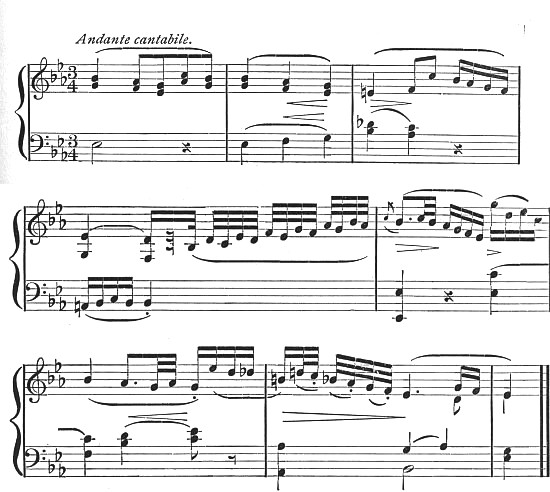
(a)
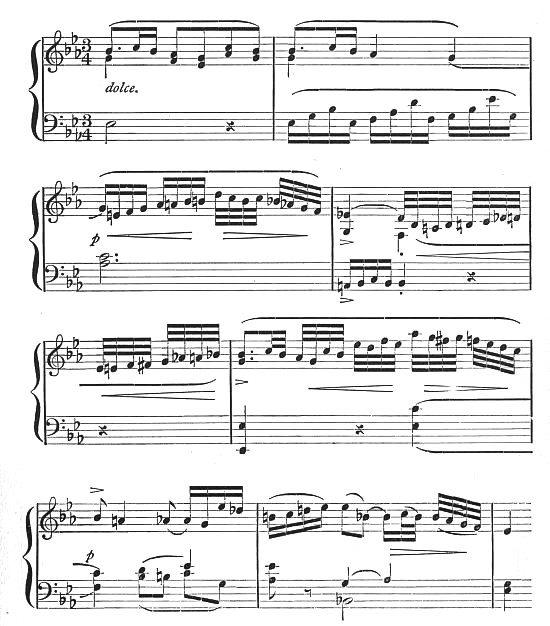
(b)
FIGURE XLI.
It will be observed that this quotation from Mozart is in strophic form; each phrase of two measures constitutes, as it were, a poetic line, the second of which closes with a half cadence, and the last with a full cadence or period. In this respect it follows the old folk-song type, and, indeed, that model serves for the great majority of lyric themes in sonatas and symphonies. But in its initial qualities this melody shows a great advance over tunes like "Barbara Alien" and "Polly Oliver," an advance due to the flexibility to which both melody and harmony had attained in Mozart's time, and to that freedom of technique provided by the piano as compared with the voice.
These quotations from Mozart are from a sonata movement which is, on the whole, above the formal average of the pianoforte pieces of that period. Many of them were excessively ornamented. In Figure XLII are shown two quotations from a sonata of Haydn, in the latter of which the ornaments are profuse.
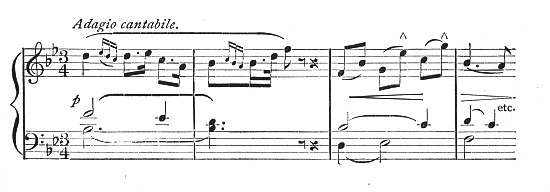
(a)
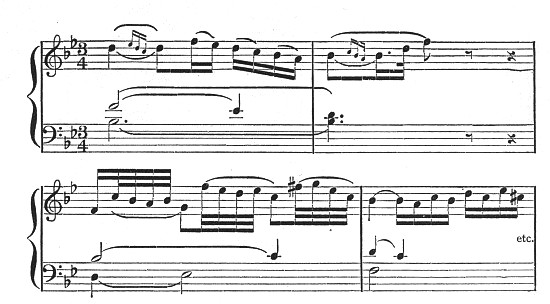
(b)
FIGURE XLII.
In spite of the somewhat artificial atmosphere that [148] surrounds much of the pianoforte music of this period there is, in the best specimens of it, a charming formal beauty. It is within its own sphere genuine and true to life. One has to consider the kind of society that it represents, as well as the status of music in that society. The art was not, at that time, free enough, nor practical enough, to deal with deep emotions; people looked on it as a refined sort of amusement. Not until Beethoven had written his music did its possibilities as a vehicle for deep human feeling and experience become evident.
It was not until the time of Haydn that the string quartet[31] came into being; a fact for which we may easily account by examining the instrumental parts of orchestral compositions before Haydn's time. We shall find the [149] 'cello, for example, playing for the most part merely the bass notes that support the superstructure of the orchestra, and consequently entirely unaccustomed to individual parts of any difficulty. Another obstacle in the path of the string quartet was the slow development of the viola, which only gradually emerged from the older and more cumbersome types, such as the viola d'amour and viola da braccio. Haydn began by writing little quartets of the simplest possible kind—the first movement of the first quartet contains only twenty-four measures—but by constant practice throughout his long life he attained a complete mastery of the form. In his early quartets he usually wrote five movements, two of them minuets, but he soon settled on the regular four movement form which has remained ever since as the usually accepted model.
Haydn: Adagio in E-flat major from the String Quartet[32] in G-major, op. 77, No. 1.
This Adagio is thoroughly characteristic of Haydn's best style of writing. It is without the elaborate and somewhat diffuse treatment we observed in the trio of his "Andante with Variations" (See Chapter VII), nor does it depend for its effect on the much more artistic use of ornament employed by Mozart in the Andante quoted in Figure XLI. Almost everything in this composition [150] germinates from the two motives given out in measures 1-2 and 3-4, and it should be noted that each of these motives is sufficiently pronounced in character to serve the purposes of generation, and that the theme, as a whole, is not by any means a perfect lyric melody such as will be found in our second example for analysis.

FIGURE XLIII.
The first of these motives (see Figure XLIII, measures 1-2) is easily traced throughout the whole composition, since the changes that are made in it are largely changes in key, but the second motive (measures 3-4) almost immediately evolves into something new. This may be observed in measure 11, where the rhythm of the passage at measure 3 is changed, the melody being given to the left hand. The second part (or stanza) of the melody, beginning at measure 13, uses chiefly the phrase from measure 2, which will be found again in the dominant—to which key this section tends—at measures 21-22. Even the passage at 23 is an elaboration of that at 11, and this same original motive is lengthened into a delightful bit of by-play at measures 35-37. The close in C-major at 42, with its accents transferred to the fourth beat of the measure, should be noted, while the sudden change of [151] key after the pause was, at that time, almost a revolutionary modulation, and sounds more like Beethoven than Haydn (see, for example, the sudden and complete change of key in the coda of the first movement of the "Eroica" Symphony). The use of the motive from measure 2 at 45-54 and the gradual elimination of its melodic quality until only its rhythm remains (53-54) is an interesting example of a familiar process in music (see Chapter VIII). This gradual dying away and ceasing of motion is also a familiar process at this point in a movement, providing as it does a sense of expectancy and preparation for the re-entrance of the main theme. The restatement begins at measure 55 and as is customary retains the original key instead of modulating to the dominant as did the first section. The coda begins at 82 and, according to Haydn's usual plan, presents a kind of reminiscence of the main subject, as if in tender farewell.
While this movement does not reach the heights of lyric beauty attained by Mozart in the Andante which we shall analyze in a moment, it is, nevertheless, a thoroughly interesting and really beautiful piece of music. Our attention is constantly enlisted by fresh glimpses of the theme, or by new harmonies; the ornamentation all grows naturally out of the structure and is not laid on for its own sake, and the melody itself is expressive and tender. Furthermore, the themes and their treatment are characterized by a perfect adaptability to the string [152] quartet, for even in the pianoforte version, we can observe how interesting is the part given to each instrument. Here, just as in a perfect story or a perfect poem, there is nothing redundant, nothing that has not some part in the main purpose of the work. And this combination of placid beauty with perfection of form makes what is called the "Classic" in music. Especially do we find here an entire absence of those perfunctory passages that occur in the movement of the "Surprise" Symphony discussed in the last chapter.
Taken as a whole, this piece is immeasurably finer than any movement of its kind produced up to that time, save alone those of Mozart; and the advance is not only in method but in the essence of the idea itself. There is a geniality and warmth about this music that marks a new era. Bach was more profound, but more isolated; here we have simple human sentiment and a kind of na?e charm that distinguished Haydn's music from that of all other composers.
This Adagio of Haydn is a good illustration of what we have called "sectional form." It may be tabulated as follows:
TABULAR VIEW OF SECTIONS IN HAYDN'S ADAGIO.
| 1 | 2 | 3 | 4 |
| Section in E-flat measures 1-16 |
Section in the dominant (B-flat) 16-30 |
Section of free modulation 30-54 |
Double Section in E-flat 55-82 |
| Coda 83-91 | |||
| Duality | Duality | Plurality | Unity |
Section four contains practically the same material as Sections 1 and 2, with its last half in the tonic instead of the dominant. It will be observed that the harmonic plan of the movement is that of "sonata-form," but that the first two sections (which would constitute the exposition) are not repeated, as was the invariable custom in Haydn's first movements. Yet the resemblance is quite close, for the third part is like a development section and the fourth like a restatement. Still there is not here that decided difference between the three sections of exposition, development, and recapitulation that is essential to sonata-form.
The slow movements of the symphonies and string quartets of Mozart, who represents the culmination of the classic type in music, are thoroughly characteristic of the ideals of the classical period. Unlike the rustic Haydn, Mozart was accustomed from his childhood to the atmosphere of courts and lived in the favor of princes. His music is never brusque, nor does it have the homely wit and sentiment of Haydn—it does not smack of the soil—but it possesses a certain ideal beauty and elegance, a certain finesse and finely pointed wit that were beyond Haydn's powers. Yet these ideally beautiful compositions of Mozart are absolutely spontaneous. We are never admitted into his work-shop; we never trace a sign of his labor; his music seems to have sprung full born from his brain. He is the type of the consummate artist [154] who deals with the language of music as easily as an ordinary mortal deals with his native tongue. He was not a philosopher like Bach, nor a great man like Beethoven. We find no evidences of his having been, outside his music, particularly distinguished from his fellows, for his improvidence and fondness for amusement are matters of record. When we think of Beethoven's music we think of Beethoven; Mozart and his art are distinct and separate.[33]
At this point the question naturally arises: "Just what do we mean by classic beauty?" In a general way a book, a picture or a piece of music becomes a "classic" when it is universally accepted as a model of its kind. In this sense Grey's "Elegy in a Country Churchyard" is a classic; so are Lincoln's Gettysburg Address, the Sistine Madonna, and the Apollo Belvedere. The same term is applied to Beethoven's Fifth Symphony, and to Schumann's "Tr?merei." These works of art represent many varieties of mood, of style, and of structure, and the application to them all of the term "classic" is a very broad usage. "Classic," as opposed to "Romantic," in music, means something quite different and much more definite. It refers to purity of outline and simplicity of harmony; to pure beauty of sound as opposed to luxuriance or the poignancy produced by dissonances; to clear and translucent colors and definite lines curved in beauty, rather than to picturesqueness. Classical music tells its story clearly and definitely and does not depend on suggestion, as does, for example, the romantic music of Schumann.
Our illustrations from Haydn have revealed how this classic spirit gradually approached its culmination. In his Andante with Variations there is something of the classic spirit, though the occasional diffuse ornamentation of the trio theme mars the purity of the composition. In the movement from the "Surprise" Symphony there is too much that is rustic to admit of its being considered altogether classic. But a fine example of the classic type is afforded by the first movement of Mozart's G-minor Symphony, discussed in Chapter IX. The distinction may be made still more clear by reference to Figure XLIV, containing (a) the opening phrases of the Finale of Tschaikowsky's "Path?ique" Symphony, and (b) a short quotation from Schumann's Novelette, op. 21, No. 1.

(a)

(b)
FIGURE XLIV.
The poignancy of the passage from Tschaikowsky is remarkable, and the opening chord, modulating at once [156] to another key than the tonic, produces a feeling of unrest which is further intensified, as the piece proceeds, by harsh dissonances. The quotation from Schumann's Novelette is notable for its brusqueness, and for the roughness of its dissonances. Effects like these would not have been tolerated in Mozart's time, and illustrate the tendency of music to become more personal and to seek to express a wider range of human feeling. A comparison of these two quotations with the opening of the andante by Mozart will reveal how far apart are the ideals of classic and romantic music.
Mozart: Andante from String Quartet[34] in C-major, dedicated to Haydn.
In Chapter IX reference has been made to the influence of Haydn and Mozart on each other. Mozart undoubtedly profited by Haydn's labors in the quartet form, and Haydn, in turn, shows in his latest quartets that he had learned something from his younger contemporary. Ever since this form came into being it has been a favorite one with composers, for in it they are able to express musical ideas in all their purity and divested of extraneous influences. For this reason the quartet became the medium for their most advanced ideas. Both Mozart and Beethoven wrote quartets that were far in advance of their time, and that were subjected to harsh criticism by their contemporaries. The introduction to the quartet from which [157] this andante is taken is a case in point. The harmonies, within the space of a few measures, wander far from the home key, and commit what were then unpardonable sins of cacophony. A brief quotation from the beginning of this introduction is shown in Figure XLV. The harsh dissonances between the A-flat in the first measure of the viola part and the succeeding A-natural in the first violin part should be noted.
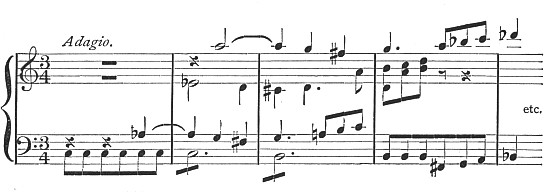
(a)

(b)
FIGURE XLV.
The vague harmonies of this introduction serve as an admirable foil to the bright opening of the first movement. The ?thetic purpose they serve is one of which Beethoven also made constant use when he desired to enhance the charm of a passage by vivid contrast of color. The opening theme of the movement (shown at (b) in Figure XLV) will be seen to be foreshadowed in the introduction (Figure XLV (a); viola part, measure 3, first violin part, measures 4-5). From the point of view of both harmony and thematic development this introduction is therefore extremely modern.
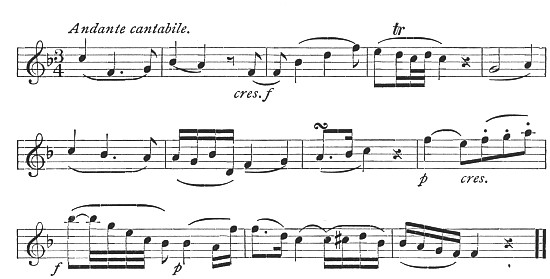
FIGURE XLVI.
Of this andante by Mozart we can say unreservedly that it is a perfect specimen of pure classic beauty. Its translucent harmonies, its exquisite curve of melody, its clear outlines, all make it a model of its kind. The chief theme, extending to measure 12 (see Figure XLVI), should be compared with those of Handel, Haydn and Mozart shown in previous chapters. This comparison will reveal an important element in the present theme, namely, the element of organization. In our earliest musical examples quoted in the first two chapters there was a conspicuous lack of variety. "Three Blind Mice" contented itself with two motives, which were repeated over and over again. "Barbara Allen" was made up of one rhythmic figure, constantly reiterated, and even in the themes of Philip Emanuel Bach and Haydn there were many rhythmic repetitions. In the Haydn quartet movement there were but two motives, and while they were used with the greatest skill, the theme itself was entirely constructed from them. [159] In Mozart's theme, on the contrary, there is hardly a single repetition of rhythm. An examination of the melody will reveal how great a variety is imparted to it by the many different rhythmic figures. Yet there is no sense of vagueness about it; it holds together firmly. This quality distinguishes all highly organized melodies, and is never found in folk-music. The same element may be observed in a developed language in which words have come to be flexible in their meaning, and more or less complicated sentences are possible. In this theme one does not get the sense of what the composer is trying to say until the melody ends; in simple themes, made up by repeating the same motive, one can foresee the end long before it is reached. Themes like this beautiful one of Mozart are possible only after art has become well developed, and after people in general have become sufficiently familiar with the phraseology of music to be able to follow complicated musical sentences.
A further charm is added to this movement by the free and flowing counterpoint of the several parts. This is an essential element in the string quartet, since without it, there being little variety in the tone of the four instruments, monotony would result.
Here, as in the Haydn slow movement, we find another example of sectional form. It may be tabulated as follows:
TABULAR VIEW OF SECTIONS IN MOZART'S ANDANTE.
| I. | II. |
| Modulating from tonic to dominant and containing theme I, episode theme (13) and theme II (26), 1-44. |
Modulating from dominant back to tonic with the same succession of themes. Coda (102), 54-114. |
The sub-divisions of the above should be carefully noted (as indicated by the entrance of the different themes). These sub-divisions break the piece up into smaller sections, each distinct from the others. A particularly interesting and beautiful effect is produced in the coda (measures 103-5) by the augmentation of the phrase from measures 1-2, which is reproduced in longer notes against a familiar counterpoint.[35]
SUGGESTIONS FOR COLLATERAL READING.
C. H. H. Parry: "The Evolution of the Art of Music," Chapters XI and XII. W. H. Hadow: "Sonata Form," Chapter X. D. G. Mason: "Beethoven and His Forerunners," Chapters V and VI.
FOOTNOTES:
[31] The instruments employed in the string quartet are two violins (first and second) viola, and violoncello.
[32] Published in miniature score, Payne edition, price 20 cents. This quartet also appears among Haydn's works in the form of a sonata for violin and piano.
[33] See Mason's "Beethoven and his Forerunners," pages 232-240.
[34] Published in miniature score, Payne edition, price 20 cents.
[35] A reference to the full score of this movement will reveal certain crossings of the lower instruments over the upper by which interesting effects of tone color are produced.
The reader who has attentively followed the story of the long and gradual development of music from the folk-song and peasant dance up to the point we have now reached, cannot but have been impressed by the character of preparation for some supreme achievement of which this development seems to partake throughout. All the laborious steps lead on toward a goal which even in the splendid work of Haydn and Mozart is not quite reached. Haydn crystallizes the form and style of instrumental music; Mozart adds his peculiar aristocratic grace of manner and classical beauty of substance, yet even in his work there remains a certain coldness and conventionality—the body of the art is perfect, but the spiritual passion of modern music as we know it is still lacking. Even during the life-times of these great musicians, however, the supreme genius who was to bring to its perfect flowering the plant they had so carefully tended was preparing for his work. In 1791, when Mozart died, and when Haydn made his first journey to London to produce his Salomon symphonies, Ludwig van Beethoven, born in 1770, was just entering on his young manhood.
In order to understand the character and work of Beethoven, it is necessary constantly to bear in mind the two-sided [162] truth that the greatest men are those who combine the utmost receptivity and teachableness with a perfect self-dependence and fearless initiative. Beethoven, who is equally remarkable for both, could never have done what he did had he lacked either. Had he been merely "original" he could not have securely founded himself on the work of his predecessors, and, therefore, would probably not have surpassed them. Had he been content always to imitate, had he never ventured beyond what was sanctioned by tradition, he would never have inaugurated a new epoch in music. It becomes, therefore, a matter of great interest to trace these opposed but complementary traits of docility and unconventionality, first in his character, and secondly in his music.
In what has been written of Beethoven, his eccentricities have been so dwelt upon that his capacity for laborious study has hardly been appreciated. It is true that he was a restive pupil. He was taught for a while by Haydn, but soon quarreled with him. His teacher in counterpoint, the learned pedagogue Albrechtsberger, said of him: "He will never do anything according to rule; he has learnt nothing." But Beethoven was essentially self-taught; and in his efforts, under his own guidance, to master all the technical difficulties of his art, he showed the most inexhaustible patience and subjected himself to the most tireless labor. Never did the veriest dolt drudge more faithfully at the A, B, C of his art than the "divine Beethoven." We have proof of this in his sketch-books, many of which have been edited and printed by Nottebohm. In them we see him jotting [163] down his ideas, often surprisingly trite in the first instance, and then returning, day after day, to the task of developing them into the perfect themes of his finished compositions. Nothing could be more salutary to those who fancy that musical creation is entirely a matter of "inspiration" than a perusal of these endless pages in which Beethoven slowly and painfully separates the pure metal from the ore of his thought and refines it to complete purity.[36]
Beethoven's wonderful certainty of touch, economy of material, and logical coherence of ideas were doubtless attainable only by this laborious method of working. He learned, by careful imitation, all that the models left by his predecessors could teach him before he ventured to push beyond them. Yet even in his early 'prentice work, like the first two symphonies and the earlier piano sonatas, in which the influence of Haydn and Mozart are constantly evident, there is a vigor of execution, a ruggedness of style, and a depth of feeling, that are all his own. In other words, his strong originality was already coloring all that he did; even when he imitated, it was with a subtle difference.
Later, as his powers developed and self-confidence grew, he became more and more indifferent to tradition, more and more singly bent on following his own genius wherever it might lead him. A strong dramatic instinct began to possess him, showing itself in a love for sudden changes of harmony and rhythm, for unexpected transitions from loud to [164] soft or from soft to loud, and in other such eccentricities. His rhythms became more striking, his melodies broader and more various, his harmonies and modulations so daring and unprecedented that the conservatives of the day held up their hands in horror. His sense of musical structure, of that combining of themes in long movements which is akin to the architect's combination of pillars, arches, windows, buttresses and colonnades in great buildings, became so powerful and unerring that he created works of vaster proportions and more subtle symmetry than had ever been dreamed of before—so great and complex that they could be followed only by the highly trained ear and mind.
Such were the works of his maturity. Later still, as he became more and more thrown in upon himself by poverty, pride, the terrible affliction of deafness, and the failure of his contemporaries to understand him, he came to live entirely in his own ideal world, and his music became more and more markedly individual, and in some cases almost perversely so. His latest works are not thoroughly understood, even to-day, except after the most patient, exhaustive study.
The customary division of Beethoven's artistic life into three periods[37] is based on these internal differences observable in his works. Those of the first period, extending to about 1803, of which the most important are the piano sonatas up to opus 53, the first three piano concertos, the string quartets, opus 18, and the first and second symphonies, show him under the influence of Haydn and Mozart, [165] though already more poignant, impassioned, and forcible than his models.
In the second period, the period of full and vigorous maturity, extending from 1803 to 1813, he throws off all restricting traditions, and stands forth a heroic figure, the like of which music had never seen, and may never see again. The compositions of this decade, among which may be specially mentioned the piano sonatas from the "Waldstein" to opus 90, the fourth and fifth piano concertos, the unique concerto for violin, the string quartets, opus 59 and opus 74, the overtures "Coriolanus" and "Egmont," the opera "Fidelio," the great Mass in C, and above all the six magnificent symphonies from the "Eroica" to the eighth, are among the supreme achievements of human art. They combine the utmost variety of form and style with a perfect unity; they are models of structure for all time; and as to expression, one knows not what to marvel at most, their rugged virility and intensity of passion, their deep pathos and tender sentiment, their moods of effervescent merriment, humor, and whimsical perversity, or their almost superhuman moments of mystical elevation.
The third period, extending from 1813 to Beethoven's death in 1827, is as we have said characterized by an almost excessive individuality, and is difficult to relate to the normal progress of musical art. Nevertheless it contains some of his greatest works—notably the Ninth Symphony, the Mass in D, and the final sonatas and quartets. The detailed study of it falls outside the province of this book.
With this brief and necessarily cursory survey of Beethoven's [166] achievement in its entirety, we may pass on to the examination of a single typical work, hoping in the course of it to make clearer to the student the two main facts about Beethoven on which we have been trying to insist: his indebtedness to his predecessors in the matters of general structure and style, and the indomitable originality by virtue of which all that he does is infused with a novel beauty and an unparalleled profundity of feeling. We shall choose for our first example one of the finest compositions of his first period—the "Path?ique Sonata," for piano, opus 13, taking up in later chapters some typical examples of his more advanced style.
Beethoven: Piano Sonata, Opus 13. First movement.
It will be noted that Beethoven adds to the three traditional sections of the sonata-form an introduction in slow tempo (of which we saw an earlier example in Haydn's "Surprise" Symphony) and a brief coda, based on the main material of the movement, to round out the complete movement satisfactorily. In his later work both of these additional sections came often to figure very prominently, the increased development he gave to them being indeed one of his most important contributions to sonata-form. We shall see in his Fifth Symphony a fine example of his treatment of the coda, which raises it to a dignity equal to that of the other organic sections. The introduction of the [167] Fourth Symphony extends to thirty-eight measures of slow tempo, that of the Seventh Symphony to sixty-two measures, with great variety of treatment.
The general structure of this movement, which is in extended sonata-form, is shown in the following tabular view:
TABULAR VIEW OF STRUCTURE OF FIRST MOVEMENT
OF THE PATH?IQUE SONATA.
| Sections. | Themes. | Measures. |
| Slow Introduction | 1-10 | |
| Exposition (A) | First theme, C minor | 11-27 |
| Transition, based on first theme | 27-50 | |
| Duality of | Second theme, E-flat minor | 51-88 |
| Harmony | Codetta or Conclusion section, E-flat major | 89-134 |
| Consisting of | ||
| Conclusion-theme I | 89-112 | |
| Conclusion-theme II | 113-120 | |
| Reminiscence of theme I | 121-134 | |
| Development (B) | Introduction-motive | 135-138 |
| Plurality of | Theme I and Introduction-motive treated | 139-196 |
| Harmony | ||
| Recapitulation (A) | First theme, C minor | 197-209 |
| New transition | 209-222 | |
| Unity of | Second theme, F minor | 223-254 |
| Harmony | Codetta, C minor | 255-296 |
| Coda | 297-312 | |
| Consisting of | ||
| Introduction motive | 297-300 | |
| First theme, reminiscence | 301-311 |
The motive of the introduction, shown in Figure XLVII, is a deeply expressive bit of melody which at once establishes the mood to which the sonata owes its name of "Pathetic." How incisive and seizing is this very first [168] measure! What a different world it takes us into—a romantic world of personal feeling—from the classic realms of Haydn and Mozart! The emotion thus suggested at the outset becomes deeper, too, as we proceed, first with the higher utterance of the same motive in the second measure, and then with the fragments of it in the third and fourth, urging us on to a climax on the high A-flat. Finally, in the fifth and succeeding measures, the pulsating rhythm of the accompaniment adds a still greater agitation, while the melody climbs ever higher and higher until it reaches the F of measure 9, after which it dies away in preparation for the main theme. The intensity of Beethoven's expression, by which his claim to the title of "romantic" is most surely indicated, could hardly be better shown than by this brief introduction of ten measures.
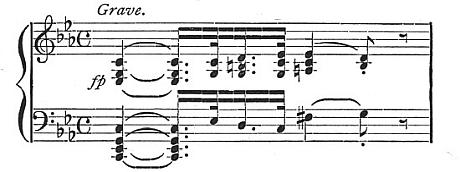
(a) Motive of the Introduction, Path?ique Sonata.

(b) Treatment of this motive in the Development.
FIGURE XLVII.
The body of the movement begins energetically, yet sombrely, with the first theme, in minor key and strongly pronounced rhythm. This merges quickly in the transition (27-50), which is neither a bit of empty passage-work as often with Haydn, nor a new melody as with Mozart, but contains constant references to the main theme (35-37, 39-41, 43-45). The second theme is both more lyrical in character and more extended than the first. It is not in the traditional key of the relative major (see Chapters II and III), but oscillates between E-flat minor and D-flat, coming into E-flat major (the relative of C-minor) only as it closes and debouches into the first conclusion theme (89-112). The closing section or codetta is, however, almost entirely in E-flat, and is moreover fairly long and important. It consists of two independent themes and of a reminiscence of the first theme at measures 121-135. A fine instance of melodic germination is found in the first conclusion theme, where the gradually rising melody twice builds itself up into a long phrase of eight measures (93-100, and 105-112) with splendidly sustained effect. The great variety of rhythm embodied in the codetta should be especially noticed.
The development begins with a restatement of the poignant introduction-motive, so managed that it leads into the remote key of E-minor. Now begins, with the resumption of the allegro tempo, a rather short but most interesting treatment of the first theme, continued with an ingenious variant of the introduction-motive (measures 142-143, 148-149: see Figure XLVII (b)), followed by the transference of the fragment of the first theme to the bass, where it is [170] thrice repeated, amid constant modulation. Then, in the measure following 169, comes one of those inimitably hushed, mysterious passages so peculiar to Beethoven, through which, like fountains from a sombre pool, rise fragments of the first theme. Then, with a rapidly descending passage, the movement plunges into its recapitulation.
This section the reader will have no difficulty in analyzing for himself, not failing to note the felicity with which a new transition, from first to second themes (209-222), is made to germinate from the last two measures of the main theme. The coda, very brief, contains nothing but a final announcement of fragments of the introduction-motive and a single sentence of the first theme.
Beethoven: Piano Sonata, opus 13. Second movement.
This slow movement, a beautiful adagio cantabile in Beethoven's tranquilly serious mood, takes on the sectional form of the rondo, consisting of a theme (A), an episode (B), recurrence of the theme (A), a second episode (C), second recurrence of the theme (A), and brief codetta.

FIGURE XLVIII.
The theme itself, filling only eight measures, but repeated at a higher pitch in the second eight measures, is a fine example of the variety in unity of Beethoven's melodies, secured only after much laborious sketching. It is shown in [171] Figure XLVIII, and should be examined carefully. Almost every measure of it presents a new rhythm, so that there is none of the monotony of those themes which endlessly repeat a single rhythmic figure. (Compare the tunes of primitive savages shown in Chapter I.) Yet the whole melody is so deftly composed that its final impression of unity is perfect. The sequence form which the harmonies of the last four measures take contributes in no small degree to this impression of unity.
The theme being in the key of A-flat, both episodes are planned to give variety of key, the first (B—measures 17-28) being in the relative minor, F-minor, and the second (C—measures 37-50), beginning in A-flat minor and modulating, through E-major, back to the home-key.
With the third entrance of the main theme, the accompaniment takes the more animated rhythm of triplets; and these continue through the brief but delightful codetta (66-73).
Beethoven: Piano Sonata, opus 13. Third movement.[38]
This movement is an example of rondo form, being, like the Mozart rondo we have already studied, based on the alternation of a chief theme, with sections containing other material. The tabular view on the next page exhibits the complete structure.
The first theme, sprightly and energetic, and recalling in its melodic curve the second theme of the first movement, [172] is in strophic form, with its last half repeated, and the cadence extended for greater emphasis. The sequences in measures 6-7 and 10-11 should be noted. The transition also starts off with a sequence, measures 23-26, corresponding to 19-22. Our old familiar, the device of imitation, also figures in measures 38 and 39. It is interesting to see Beethoven using these tools of the polyphonic style (see Chapters I and III) in a work so far removed from it, and with such ingratiating freshness.
TABULAR VIEW OF THE STRUCTURE OF THE FINALE
OF THE PATH?IQUE SONATA.
| Sections. | Themes. | Measures. |
| A. | First theme, C-minor | 1-18 |
| Transition | 19-26 | |
| B. | Second theme, E-flat major | 26-44 |
| 44-52 | ||
| Transition (on motive from close of second theme) | 52-62 | |
| A. | First theme, C-minor | 62-79 |
| C. | Third theme, A-flat | 80-108 |
| Florid passage work | 108-121 | |
| A. | First theme, C-major | 121-135 |
| B. | Second theme, C-minor | 135-154 |
| Closing theme (codetta) | 155-171 | |
| A. | First theme, C-minor | 172-183 |
| Codetta, extended | 183-203 | |
| Final suggestions of first theme | 203-211 |
The second theme enters for only eight measures, after [173] which the gay little imitations are again resorted to, and carry us to the re-entrance of the main theme.
The episode (C), based on a new theme in the key of A-flat major, for the sake of the harmonic variety so essential to the middle part of a movement, is again in sequence form, and in strict polyphonic style, first with two voices and later with three. In measures 100-103 we have the theme in the right hand, and set against it in the left a staccato counterpoint in eighth-notes; in the next four measures this scheme is just reversed. A rather florid passage, which may be compared to the cadenza in the rondo from Mozart analyzed in Chapter VI, leads over to the return of the first theme.
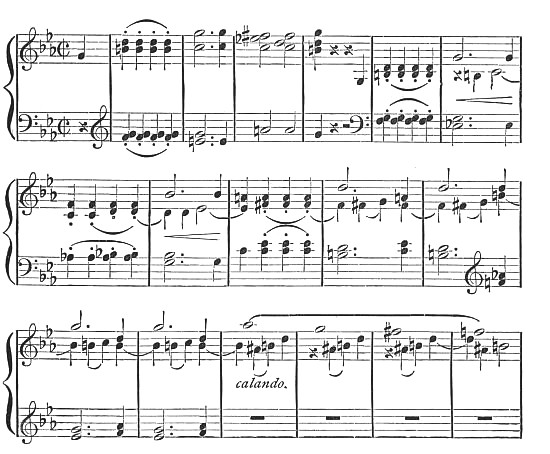
FIGURE XLIX.
The appearance of the second theme, on its return, in the key of C-major instead of E-flat major, imparts organic solidity to the movement by its insistence on the tonic key, as in similar cases in the sonata-form (compare again Chapter VI). It is also this time made to germinate into eight additional measures (see Figure XLIX).
In the final section A (172-end) the little motive of the transitions does further duty, and a new figure is introduced in measure 194. After the pause of measures 202-203, we have brief hints, piano, of the main theme, and then with one of the sudden fortissimos Beethoven loves so well, a precipitous downward scale ends the movement with vigor.
The "Path?ique Sonata" illustrates most vividly the general truths about its composer's first period which we have tried to bring out above. The similarity to the style of Haydn and Mozart is most striking. Not only do we find the general types of structure developed by them applied with great fidelity, but there are many details of style, such as the accompaniment figures and the ornamentation, which recall them. Yet the strings, so to speak, are all tightened, there is not a trace of flabbiness or diffuseness, everything irrelevant is omitted, and the style is at once more varied and more unified than theirs. The vigor and individuality of all the themes is consummate; the organic beauty of such themes as that of the Adagio is supreme. The transitions are notable for their pertinency and derivation from the thematic materials of the movement—there are no empty [175] scales and arpeggios. The developments give the impression of inevitability, of growing from the primary motives as naturally as plants grow from their seeds. Contrast in rhythm, in melody, in harmony, and in style (as exemplified in the use of polyphonic style in the finale) abounds. There is never a dull moment, yet interest is never secured at the expense of unity. Above all, the virility, profundity, and earnestness of the expression, surprise us; there is here none of the detachment, the cool remoteness, of classic art; every note throbs with personal feeling—music has left the innocence and transparent gaiety of childhood behind it, and begun to speak with the deeper and more moving, if less serene, accents of maturity.
In the next chapters we shall trace this progress further.
SUGGESTIONS FOR COLLATERAL READING.
E. Dickinson: "The Study of the History of Music," Chapter XXVI. C. H. H. Parry: "The Evolution of the Art of Music," Chapter XII. D. G. Mason: "Beethoven and His Forerunners," Chapters VII, VIII, and IX.
FOOTNOTES:
[36] See for quotations from the sketch-books, Mason's "Beethoven and His Forerunners," pp. 304-314. Several of the complete sketch-books, edited by Nottebohm, are published by Breitkopf and H?tel.
[37] See Von Lenz's "Beethoven et ses trois styles."
[38] In numbering the measures, begin with the first (partial) measure, even though it is incomplete.
Our study of the Path?ique Sonata has shown how closely Beethoven followed the models of Haydn and Mozart, at the same time infusing into them a new spirit. The first movement of that sonata does not differ materially in form from the first movement of Mozart's G-minor Symphony, discussed in Chapter IX, yet Beethoven takes us into a new world, far removed from that world of pure impersonal beauty in which Mozart dwelt. Beethoven is the man struggling, fighting, working out his own individuality, learning through bitter experience; Mozart is the artist not so much turning his own experience into music, as creating outside himself imperishable works of an almost superhuman beauty. In many of Beethoven's works there is this same regularity of form coupled with freedom of expression. The brusqueness of his style led his contemporaries to think him an iconoclast; and it was not till many years after works like the Fifth Symphony were produced that the public began to understand how orthodox they are.
This free individual expression, now a characteristic of art generally and evident enough in all phases of human life—this assertion of the personal point of view—began [177] with Beethoven and has been increasing ever since his day, until we now have music in which certain phrases or themes no longer please us as beautiful sounds, but exist for some ulterior and individual purpose.
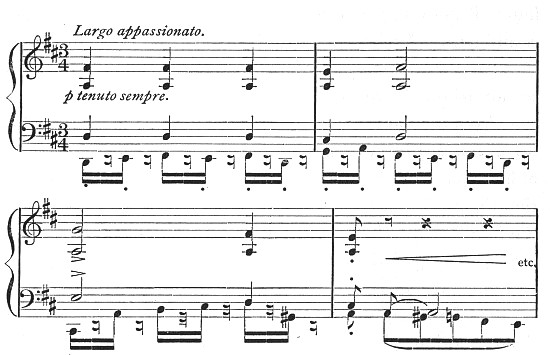
(a)
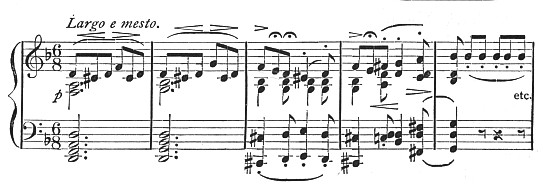
(b)
FIGURE L.
This change was perhaps only a part of that more general transformation of society by which the composer, who had previously been subject to the favor of princely patrons, became an independent individual, living in direct contact with the public at large. Music, thus freed and given an [178] independent existence, became an expressive art and took deeper root in human experience. It lost, in this process, something of that calm, ethereal beauty it had possessed, but it gained greatly in expressiveness. In Beethoven's hands it became plastic; he enlarged the range of harmonic combinations far beyond that of Mozart, and created themes that were of wider application to human feeling. In illustration of this there will be found in Figure L, (a) a quotation from the slow movement of Beethoven's piano sonata, op. 2, no. 2, and in (b) a quotation from the slow movement of his sonata, op. 10, no. 3. These should be compared with the theme from Mozart's piano sonata in Figure XLI. The difference between the themes of Beethoven and that of Mozart is in their content rather than in their form.
The purpose of Mozart's theme is beauty; the purpose of Beethoven's themes is expressiveness, the conveyance of deep emotion. They are lacking in one essential quality of melodic beauty, namely, outline, or curve.[39] These two quotations are not representative of Beethoven's lyric genius, for he has left us many fine melodies, but they reveal a general tendency of his to seek in music an outlet for his deepest thoughts and feelings, and to sacrifice, if necessary, that beauty of outline that characterizes Mozart's finest tunes.
One peculiarity of Beethoven's music, due to his constant search after expressiveness rather than mere formal [179] symmetry, is a unity and conciseness of style notably superior to that of Mozart. Many of his themes lack the perfect balance of phrases, in exact thesis and antithesis, found in Mozart's, their structure resulting rather from a logical development of the leading motive, which, by a favorite device of his, presses on, in constant repetition and with increasing vigor, to an emotional climax. The contrast between this method of treating a theme and the method of Mozart may be seen in Figure LI.

(a) From Mozart's G-minor Symphony.

(b) From Beethoven's first piano Sonata.
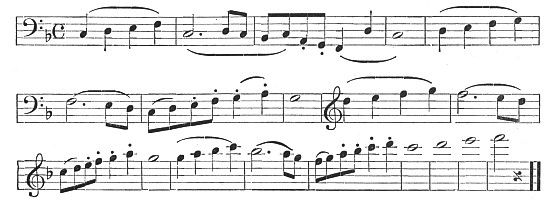
(c) From Beethoven's String Quartet, op. 59, No. 1.
FIGURE LI.
In the quotation from Mozart's symphony it will be observed that the two-measure phrases exactly balance each other, but that the second phrase is melodically unrelated to the first, and is, furthermore, a somewhat trivial figure. One feels in listening to the whole theme that the real significance of it lies in the opening phrase, and this conclusion is justified by reference to the development section of the movement, where the composer altogether discards the second phrase. The style of this theme is, therefore, largely dictated by the convention of perfect phrase balance. The style of the two Beethoven themes, on the contrary, is vigorous and terse. The outward symmetry is dictated by the inner sense.
In the sonata theme Beethoven presses home his idea with greater and greater intensity until the climax is reached, after which the tension is gradually abated; in the theme from the string quartet an almost identical method is pursued. For a further illustration of the terseness of Beethoven's style reference may be made to the development sections of this sonata and string quartet, where most interesting use is made of the short motives from which these themes are derived. These methods of writing give evidence of the fine economy Beethoven continually displays. There is, in his music, nothing redundant—no unnecessary word—and it is this quality of style that produces such an effect of life and vigor.
Beethoven carries out these methods in whole movements, and even in complete symphonies. We have already seen how, in the Path?ique Sonata, a theme in [181] the finale is derived from one in the first movement, but a much more interesting example of the process[40] may be found in the Fifth Symphony.
Beethoven: The Fifth Symphony.[41] First movement.
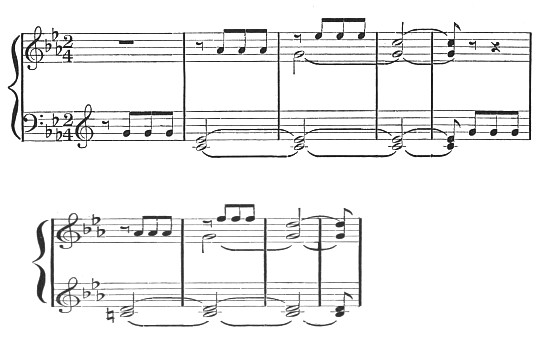
(a)
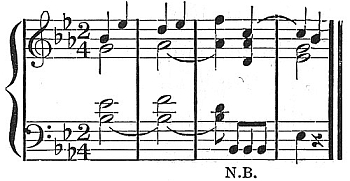
(b)

(c)

(d) From the Scherzo.
FIGURE LII.
In Figure LII will be found quotations from the three themes of the first movement of the Fifth Symphony, and from the secondary theme of the scherzo.
It will be observed that the first motive in theme I—consisting of three short notes followed by a long one—is the germ from which both the conclusion theme and scherzo theme spring, and that the same motive serves as the bass to the second theme. This motive, in fact, dominates the entire first movement, the extraordinary vitality of which is largely due to the incisive quality of the motive itself and to the occasional thunderous proclamations of it by the entire orchestra. Here we have the virility of Beethoven's style admirably illustrated; no time is given to platitudes, no single measure wanders away from the chief issues. At times this first motive is extended into a succession of loud chords from the full orchestra; again the prevailing two-measure rhythm is interrupted by a measure of silence that shifts the accents dramatically from one place to another, dislocating the whole passage.[42] This intensity of utterance—each phrase hammered home—gives to the whole work a quite unique place among symphonies.
The complete movement may be tabulated as follows:
TABULAR VIEW OF STRUCTURE OF FIRST MOVEMENT OF
BEETHOVEN'S FIFTH SYMPHONY.
| Sections. | Themes. | Measures. |
| Introduction. | On motive from theme I | 1-5 |
| Exposition (A) | First theme, C-minor | 6-56 |
| Transition consisting of a chord of modulation | 58 | |
| Duality of | Introduction to theme II based on original motive | 59-62 |
| Harmony | Second theme in E-flat major | 63-95 |
| |
Codetta or Conclusion-section consisting of Conclusion-theme. |
95-119 |
| Reminiscence of theme I | 110-124 | |
| Development (B) | Motive from theme I treated | 125-179 |
| |
Introduction to theme II lengthened and treated in sequence (G-minor and C-minor) |
179-195 |
| Plurality of Harmony |
Half note phrase pass the same extended into long passage finally losing its contour and retaining only its rhythm |
195-240 |
| Recapitulation (A) | Further treatment of theme I | 240-252 |
| First theme, C-minor | 253-300 | |
| Transition leading to C-major | 302 | |
| Unity of | Introduction to theme II | 303-306 |
| Harmony | Second theme in C-major | 307-346 |
| Conclusion—theme C-major | 346-374 | |
| Coda | Theme I treated | 374-397 |
| Introduction to theme II with new counterpoint | 398-406 | |
| Motive from the same in diminution (basses) | 406-415 | |
| Motive from theme II treated | 416-469 | |
| Motive from theme I treated | 469-502 |
The foregoing table should be compared with those in Chapters VIII and IX in order to get a comprehensive view of the gradual development of sonata-form. It will be seen that Beethoven destroys nothing, but that [184] the changes he makes in the older models are changes such as the nature of his themes and the length of the movement demand. The chief difference in themes is that the first theme is less lyric than those of Mozart, and more suited to development; a better contrast between themes I and II is thereby provided. The coda is extended far beyond that of the old model, and becomes an important part of the structure—important, because at this stage of the development of sonata form (audiences having become accustomed to listening to long pieces of pure music) the repetition of the whole first section (A) is a little too obvious, and the introduction of a dramatic coda after the recapitulation section provides fresh interest at the point where it is most needed.
Sir Hubert Parry[43] writes of Beethoven's innovations in this phase of musical development as follows: "It was his good fortune that the sonata-form had been so perfectly organized and that the musical public had been made so perfectly familiar with it, that they were ready to follow every suggestion and indication of the principle of form; and even to grasp what he aimed at when he purposely presumed on their familiarity with it to build fresh subtleties and new devices upon the well known lines; and even to emphasize the points by making progressions in directions which seemed to ignore them."
But most important of all is the close reasoning (if we may use the term) displayed throughout this movement. There is hardly a single note in it that has not some direct [185] bearing on the subject matter, the two chords in the transitions being the only portions not derived from the themes proper. With all these elements of strength, and the added cohesion resulting from the similarity of themes, this movement stands as a model of what a symphonic first movement should be.

(a)

(b)
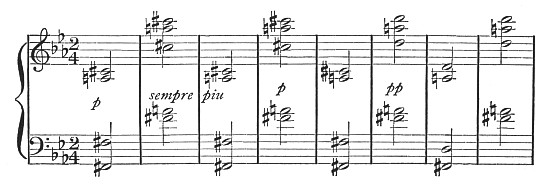
(c)
FIGURE LIII.
We have referred in Chapter VIII to that process of development whereby a theme becomes gradually changed, losing its physiognomy little by little until it is only a shadow of its former self. In the quotation in Figure LIII this process [186] might almost be said to be the opposite of development, since the theme is gradually denuded of its melodic curve, until nothing but its rhythm remains; but the effect, at least, is to produce something quite new out of a germinal motive, and to relieve, for a moment, that insistence on melody that characterizes the first section. The device is a favorite one with Beethoven, and in this movement he makes interesting use of it. The passage begins at measure 195 ((a) in the figure) with the phrase used to introduce the second theme, as if it intended going on with the theme as before, but instead there enters a long passage of half-notes, (b), in which the outline of the half-note phrase is preserved for a while, after which the rhythm only is retained, and the passage becomes a series of chords floating mysteriously, and dimly outlined as in a cloud ((c) in the figure). The original motive crashes through (measure 228) for a moment, the soft chords sound again, and then the whole orchestra rushes rapidly to the end of the section.
The effect of this cessation of the rapid movement that has thus far animated the music is very dramatic, and the startling interruption of its peaceful flow by the loud chords at measures 228-231—as if they were impatient to begin the turmoil again—gives the whole passage a peculiarly vivid effect. This device is analogous to that employed in the novel when the author prepares his readers, by a page or two of peaceful narrative, for his most dramatic episode. The significance of this passage is, of course, due to its connection with the introductory phrase from which it sprang, but it should be noted that the [187] whole passage is a re-creation from the original motive and not a restatement of it in another key. And its position in the movement is exactly at the point where some relief is needed from what might otherwise be a too great insistence on the first theme, and just before the beginning of the recapitulation, where the first theme is to appear in its original form. It will be found that such passages are usually placed in this position.
The themes in Beethoven's finest works are not only hammered out, as it were, from the rough metal, but we may say of them—as we cannot say of those of Haydn's and Mozart's—that they are pregnant with possibilities which are not fully realized until the composition is finished. With Haydn and Mozart the development section is usually a string of different versions of the original theme—as is the latter's G-minor symphony, first and last movements. With Beethoven the development section reveals what was latent in the original theme, but what had not been before realized. In the development section of the Fifth Symphony he not only convinces us by his logic, but overpowers us by the sweep of his eloquence.
It is impossible to express in words the significance of this music, but it runs almost the complete gamut of human feeling. The opening theme is so incisive and has such a tremendous energy that it takes us into a new [188] world. If we compare it with Mozart's first movement themes we realize at once that it deals with things that music had never attempted to express before. The second theme is not by any means a fine melody, being made up of a constantly reiterated phrase, but it has an appealing beauty of its own that we would not exchange for perfection. Occasionally the terrible asserts itself, as in those ominous chords with empty fifths in the coda (measures 481-482), while the whole movement seems to have been struck off at white heat.
That this was not the case, however, but that on the contrary even the first theme itself took its present shape only after a laborious effort of the composer's mind, we know from the evidence of his sketch-book. The theme first appears there in the following form.
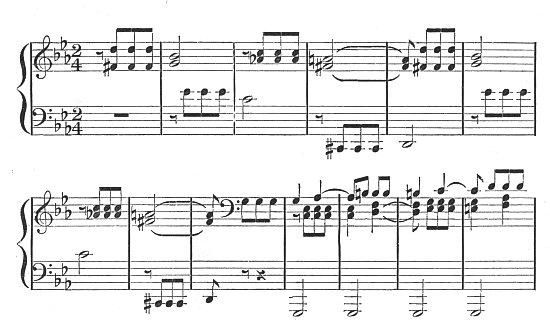
FIGURE LIV.
This commonplace theme evidently lay generating in Beethoven's mind for a long period. Various sketches on [189] it appear from time to time, and it was only after much thought that it finally emerged in its permanent form. This was always his method of composition. Unlike Mozart, who wrote music with the utmost fluency and rapidity, Beethoven rewrote his themes many times before they satisfied him, and the process caused him actual mental agony. With him composing was a struggle, a fight; he stamped, and sang, and shouted over the composition of some of his larger works, and finally emerged from his solitude exhausted.
There is no doubt but that Beethoven was affected by the prevailing social unrest of his time—by the revolutionary ideas that were then stirring. Although we cannot attempt to translate into words the significance of the fifth symphony, there is no mistaking its language as that of independence and freedom from conventional shackles. "Writing in a period of revolution," says Mr. Hadow,[44] "himself an ardent revolutionary, he broke in upon the politeness of the Austrian court with an eloquence as tempestuous as that of Mirabeau or Danton." So that, looking at his music as a whole, we are not only struck by its significance, but by the close relation in which it stands to the life of Beethoven's period. Never before had music been so untrammeled, so free. The medium itself—harmony, melody, rhythm—had become more plastic, and the old incubus of tradition had been thrown off. Not only that, but the various elements in composition were fused for the first time in Beethoven's music. Polyphony [190] takes its place as a means and not an end; pure melody—even folk-melody—becomes a part of the larger scheme in which its beauty is set off against contrasting elements—and is thereby enhanced; rhythm becomes a means of expression in itself, and not merely a vehicle; harmony is made an important part of the general design, and its latent possibilities as a means of expression are realized.
All these threads were gathered together by Beethoven, and woven into the complex fabric of his music. Great men are usually born at just the right moment, and Beethoven was no exception to the rule; for he found the art at just the point where a master spirit was needed to take its various elements and fuse them. Under his hands all the inessential parts dropped away, and the essentials were placed in such relation to each other that a completely organic work of art resulted.
SUGGESTIONS FOR COLLATERAL READING.
"Oxford History" Vol. III: Chapters X and XI. Grove's "Beethoven and His Nine Symphonies." Grove's "Dictionary of Music and Musicians:" articles "Beethoven," "Symphony," and "Form." Mason's "Beethoven and His Forerunners," Chapters VII, VIII, and IX.
FOOTNOTES:
[39] An examination of any one of the best folk-songs quoted in Chapter II, or the melodies of Bach, Handel, Haydn or Mozart quoted in succeeding chapters, will show how important an element of melody is this curve or outline.
[40] The themes in the minuet and finale of Haydn's "Emperor" quartet have a slight similarity of contour.
[41] Published for piano, two or four hands, by Peters, Leipzig. For convenience of reference, number all measures and parts of measures consecutively.
[42] The presence of measure 389—which is silent—has been a subject of discussion among musicians: it is sometimes omitted in performance.
[43] "Evolution of the Art of Music," Chapter XII.
[44] "Oxford History of Music."
The slow movements of the sonatas and symphonies of Haydn and Mozart were essentially lyric pieces in which the composer relied for his effect on the beauty of his melodies. These melodies, usually two in number, were varied by being presented in different keys and by being ornamented with passing-notes, scale passages, trills, etc. Each section was clearly separated from the others by cadence chords, so that the total effect was of a series of separate divisions, each, as it were, independent and complete in itself. There are, of course, exceptions to this method of procedure, particularly in the string quartets of Haydn and Mozart, which are more highly developed than is usual in their piano sonatas, but as a general rule this was their way of treating slow movements.
This lyric, sectional form of slow movement served as a foil to the more involved first movement. The lovely, serene melodies were not disturbed by passion, nor sacrificed for picturesque effect of any kind. In the string quartets and symphonies they were enlivened by a certain amount of polyphony (see Chapter X), and in the piano sonatas they occasionally departed from the simple [192] regular form, but they seldom dealt with tragedy and seldom presented any evidence of that idiosyncrasy and intense individuality that marks the slow movement of later times.
The early sonatas and symphonies of Beethoven are largely constructed on the old model. The first piano sonata, referred to in Chapter XII, has a sectional slow movement that might almost have been written by Mozart. The slow movement of the first symphony is simplicity itself, both in form and content; and even the adagio of the Path?ique Sonata (see Chapter XI) is a straightforward sectional piece with a lyric melody presented several times, with varying accompaniment, and with the usual contrasting middle section.

(a)
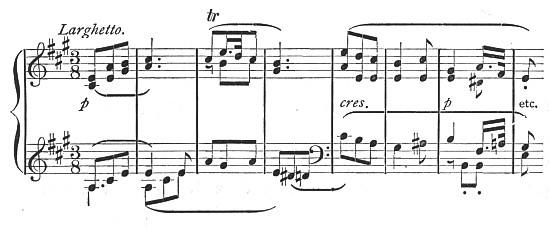
(b)
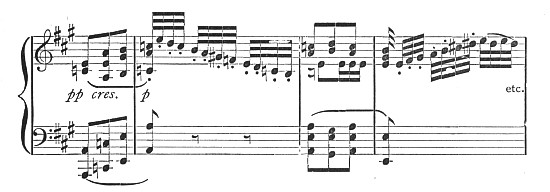
(c)
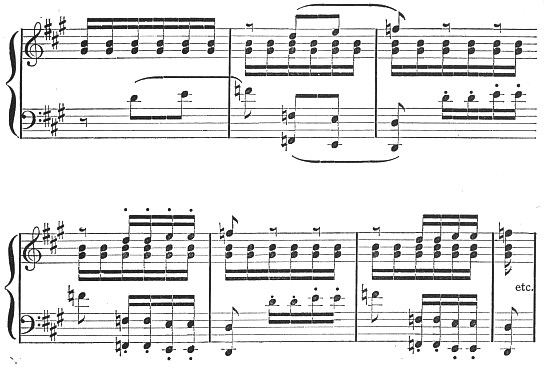
(d)

(e)
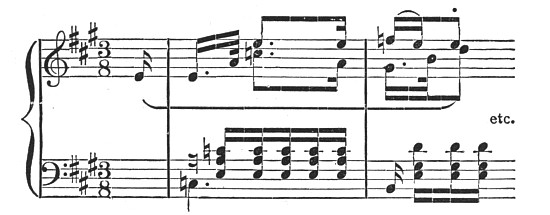
(f)
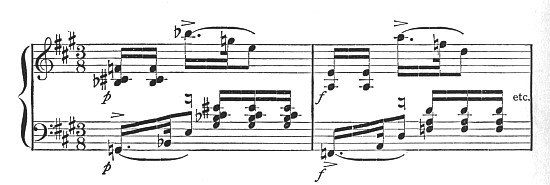
(g)
FIGURE LV.
In Figure LV is shown the first theme of the andante of the first symphony, (a) themes from the larghetto of the second symphony, (b) and (e) and portions of the middle section of the same (c), (d), (f), and (g). Each of these themes is distinctly strophic; each has perfect phrase balance, charm of contour or outline, and simplicity of harmonization. Not so highly organized as the theme from the Path?ique Sonata (see Chapter XI, Figure XLVII) they resemble the themes of the older masters, but bear, nevertheless, some evidence of the individuality that so fully characterizes Beethoven's later music. But in the treatment of the theme from the second symphony that individuality is clearly manifested. Instead of a mere restatement varied by new harmonization or by elaboration of the theme itself, there is a free [195] play of fancy, one or two short motives from the first theme being tossed about in the orchestra from one instrument to another in delightful by-play.
All sorts of devices are resorted to to keep the interest of the listener at its height. The chief motive (Figure LV, (b)) passes from calm serenity to playfulness, and again to splendid sonorous grandeur; a phrase from this same motive becomes the subject of an almost crabbed discussion (Figure LV, (d)), while the charming secondary theme (Figure LV, (e)), whose whimsical gayety animates the early part of the movement, is given a plaintive quality by a change to minor (Figure LV, (f)) and the touching contrapuntal phrases that are set against it. A little later a single phrase from the same theme becomes the subject of a bit of vigorous by-play between the different instruments (Figure LV, (g)).
Thus the slow movement, even in Beethoven's early works, becomes vivified by his intense individuality. In his more mature compositions in this form the whole body of the music pulsates with life—no single part stagnates.
Beethoven: The Fifth Symphony, Slow movement.
We have already pointed out in Chapter X that the slow movement is usually written in some sectional form. Beethoven followed the old models in this respect in the majority of his slow movements, but his enrichment of the content of the music and his skill in avoiding conventional endings[196] and other platitudes makes his pieces less rigid in effect than those of Haydn and Mozart. He was particularly fond of leaving his listeners until the last moment in doubt of the ultimate conclusion of a passage, leading them away from his point and coming back to it by an unexpected modulation or turn of phrase; he frequently ends the section of a movement with one or two brusque chords suddenly inserted after a passage full of sentiment. In short, his sectional movements are less obvious in design, and more flowing and continuous, than was the custom before his day.
The andante of the Fifth Symphony is in free variation form, the divisions—unlike those in the variations referred to in Chapter VII—not being clearly marked nor regular in form. The theme has two parts, but Beethoven skillfully avoids that prolixity sometimes evident in Haydn's "Andante with Variations;" nor does he lengthen his two themes to such an extent as to make them a little doubtful as proper subjects for variation treatment, as did Haydn. Furthermore, although the second part of Beethoven's theme is a better subject than Haydn's "Trio" theme, being more terse and more characteristic, Beethoven presents it in nearly its original form each time it appears, making the first and more important subject serve as the basis of his variations. Such changes as do occur in the second theme will be noted later. The complete movement may be tabulated as follows:
TABULAR VIEW OF STRUCTURE OF THE ANDANTE OF THE
FIFTH SYMPHONY.[45]
| Sections. | Themes. | Measures. |
| 1. | Theme I in A-flat major | 1-23 |
| Theme II in A-flat and C-major | 23-50 | |
| 2. | First variation of theme I, A-flat major | 50-72 |
| |
Second part of theme I as before but with more elaborate accompaniment |
72-99 |
| 3. |
Second variation of theme I, A-flat major (theme given out three times: cellos, violins and basses) |
99-124 |
| Episode, founded on initial motive from theme I | 124-148 | |
| Theme II in C-major (first two phrases lengthened) | 148-158 | |
| Episode, founded on motive from theme I | 158-167 | |
| Theme I in A-flat minor | 167-177 | |
| Transition passage leading to return of theme I | 177-186 | |
| 4. | Theme I, A-flat major | 186-206 |
| 5. | Coda | 206-248 |
The foregoing table may be compared with that of the Haydn variations in Chapter VII. While the general scheme is the same—for the two themes are in each case presented several times—the Beethoven variations are much more concise, and at the same time much more fully expressive and illustrative of the original theme. Haydn's variations are na?e; Beethoven's are conscious. Beethoven presents his themes from widely different points of view; Haydn presents charmingly elaborate versions of the same melodies. "Composers did not for a long while," says [198] Parry,[46] "find out the device of making the same tune or 'theme' appear in different lights, so as to make studies of different aspects of the same story under changing conditions, as in Robert Browning's Ring and the Book."
These entirely distinct presentations of the original idea give to this movement an especial charm, placing it far above any of Haydn's or Mozart's variations.
The peculiar charm of this andante lies not so much in its melodies, beautiful as they are, as in the individuality of their treatment. The first version of the theme as it appears in Beethoven's sketch-book is shown in Figure LVI (a), and at (b) is given the first part of the completed theme.

(a)
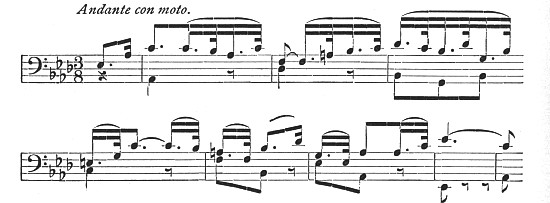
(b)
FIGURE LVI.
It will be observed that the original idea was somewhat mechanical in its rhythm, and lacked that variety imparted to the completed theme by the tied note at the beginning of measure 3 and at the middle of measure 5. Beethoven's original intention must have been quite at variance in other ways with what he finally evolved, for he marks his first sketch, "Andante quasi Minuetto," i. e. "in the style of the minuet," and of this there is left no evidence whatever.
Each variation of this theme is quite distinct from the original, particularly in its mood. While the original theme has a calm and even pensive beauty, full of sentiment, the two variations of it are less serious and, at times, verge on the humorous and playful (as at measure 108), or on the grotesque (as at measure 115). But in the episodes that occur between the variations—in the transitions or links between the different parts—Beethoven's fancy has fullest play. He ranges all the way from comedy to tragedy, from delicate gaiety to lumbering, Brobdingnagian heaviness. Simple raillery seizes him when, at measure 160, he allows the violin to take up the familiar motive and toss it to the basses and take it back again, or when he amuses himself with weaving thirds up and down (134), crossing and recrossing, spinning out the little three-note motive into a fine web, which is finally torn apart as the whole orchestra thunders out the secondary theme (148).
These two passages (portions of which are shown in Figure LVII) in their freedom from restraint and their expression of the composer's idiosyncrasies, are quite beyond what had ever been attempted before. We see [200] working here a mind full of resource and capable of sounding the greatest depths of the subject.
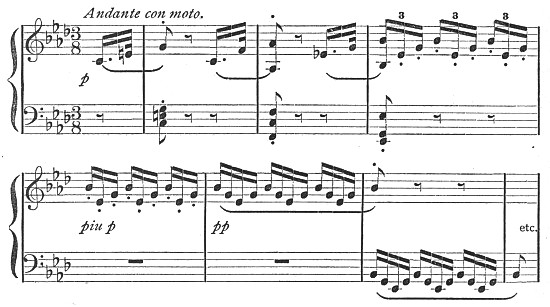

FIGURE LVII.
And this highly imaginative method of treating the transitions or connecting passages is one of the fundamental differences between the variations of Haydn and Mozart and those of Beethoven "A priori," [47] says Mr. Hadow, "it would be easy to conjecture that the variation form is unsatisfactory. It affords little scope for structural organization, little for episode or adventure, it seems to have no higher aim than that of telling the same story in the [201] largest possible number of different words. Indeed, composers before Beethoven are often in evident straits to maintain its interest." An examination of any set of variations by an inferior composer will reveal just the defects Mr. Hadow refers to. But Beethoven not only tells the story in quite different words, but finds opportunity for all sorts of interesting episodes and adventures, so that the structural weakness of the form is quite lost sight of. With him the connecting passages skillfully avoid too great stress on pure melody—with which the listeners would otherwise be surfeited—and, at the same time, they never degenerate into unmeaning passages of empty chords and scales such as often occurred in the music of Haydn and Mozart.
The recurrence in the same key of the theme in the variation form gives to it a certain monotony of harmonization unless the episodes are treated with great harmonic freedom. As was pointed out in Chapter II, harmony sometimes becomes an important element of structure, particularly in the rondo and variation forms, and in Haydn's and Mozart's variations the harmonic plan is not sufficiently varied to provide this much needed contrast. Beethoven, however, always much more free in the use of modulation than his predecessors, imparts to these variations almost at the outset great variety of key, and in all his episodes ranges freely about, unhampered by limitations. In measure 28, for example, he suddenly starts towards the key [202] of B-flat minor, only to emerge a moment later in C-major. The passage, beginning at measure 39, not only provides that relief from too great insistence on melody which we have already referred to as characteristic of his episodes, but its harmonies are purposely vague, leaving us in doubt until the last moment as to their ultimate conclusion. An interesting and beautiful effect is again produced, at measures 167-177, by the changes of key, while the scale passages that follow introduce further harmonic variety. At measure 206 begins a passage that seems to intend the key of D-flat, but again our expectations are not realized. So that the total impression we receive from the harmony of this movement is of a more complete unity and variety than is produced by the themes themselves.
It must also be noted in general that this freedom of harmony is one of the signs of advancement in the art of music, and that at the present time the combination of chords is much less restricted than was the case in Beethoven's day. And this steady advance has been as steadily opposed by theorists. When we remember that Monteverde (1567-1643) was bitterly criticised for introducing in a chord the unprepared dominant seventh, making thereby a dissonance almost as familiar to modern ears as is the simple major triad—we can easily realize how difficult it was for people in Beethoven's time to understand his far-reaching modulations. The steady progress is further illustrated by Wagner's music-dramas, which were considered when they first appeared as almost cacophonous in their harmonization, but which now seem perfectly simple and normal.
A piece of music like this is a human document. It embraces so many phases of human feeling, and it places them all, as it were, in such proper focus that we feel in listening to it as though we had come in contact with elemental human experience. This music is not unapproachably grand; we hear in it echoes of our own strivings, hopes, and despairs. And it is this sense of proportion, this wideness of vision, that makes Beethoven's music so universal. For in the last analysis the effect of any work of art depends on the artist's sense of values; a fine situation in a novel is all the finer for being set against a proper background; a tragedy must have moments of relief; beauty alone, whether in a painting or a piece of music, soon palls upon us; in the greatest works of art this sense of values—this feeling for proportion—is always present to save the situation (whatever it may be) from the deadly sin of being uninteresting.
Beethoven continually gives evidence of his mastery over this important element in composition. The beauty of his melodies never palls. Before that point is reached there is some sudden change of feeling, some unexpected turn of melody or modulation, some brusque expression that shocks us out of our dream. He is particularly fond of the latter device, and frequently lulls us into a fancied quiet only to awaken us abruptly when we least expect it. With him everything has its proportionate value, so that we get a clearly defined impression of the whole work, just as in a fine novel the values are so carefully preserved that we feel [204] the locality of every incident, and come to know the characters as we know our own friends.
One who is thoroughly familiar with the andante of the Fifth Symphony feels this quality as predominant. We are not enraptured by the theme itself, as we are by that of Mozart's andante from the string quartet (referred to in Chapter X), but we feel the charm of incident and by-play, we are just as much interested in the connecting passages as we are in any other part of the piece; and we think of it all as we do of a finely written play, where one incident hangs on another, and nothing happens that does not bear on the plot.
Thus, judging music from the standpoint of universal human feeling, Beethoven reaches the highest point in its development. No other composer, before or since, has equalled him in this particular, and the more we study him the more we find in him. Repeated hearings do not dim the luster of his genius, nor have the great composers who have followed him had as broad a survey of human life as he possessed.
SUGGESTIONS FOR COLLATERAL READING.
Hadow: "Oxford History," Vol. V. Parry: "Studies of Great Composers." Mason: "Beethoven and His Forerunners," Chapters VII, VIII, and IX.
One of Beethoven's most prominent characteristics, without a special consideration of which no account of him would be at all complete, was his humor. In the three foregoing chapters we have had passing glimpses of it: we have noted his distaste for the obvious, the trite, the conventional, and his fondness for breaking in on the tranquillity of his audience, sometimes in danger of lapsing into inattentive dullness, with all manner of shocks and surprises—clashing chords in the midst of soft passages, unexpected modulations to distant keys, piquant interruptions of rhythm, long holds, sudden spasms of wild speed. All such tricks were dear to him as means of avoiding the monotony which is the one unpardonable sin of an artist, and of attaining constant novelty and a kaleidoscopic diversity of effect. None of his predecessors, and perhaps none of his successors, carried to such lengths as he did this peculiar kind of musical humor. It is one of the most essentially "Beethovenish" of all his qualities.
The particular form of movement in which his humor attained its freest scope (though it is hardly ever entirely absent in anything that he wrote) was the minuet of his [206] earlier, and the scherzo of his later sonatas and symphonies. The minuet of Haydn and Mozart, which we have discussed in Chapter VII, though not entirely lacking in the element of whim and perversity which gives rise to humor, was primarily stately, formal, and suave. When we listen to a minuet of this old school, our mind's eye conjures up the picture of a group of eighteenth century dames and cavaliers, hoop-skirted and bewigged, gravely going through the set evolutions of their dance with unfailing dignity and courtly grace. From such a scene a Beethoven scherzo whisks us in a moment to some merry gathering of peasants, where all is wild conviviality, boisterous rejoicing, and unrestrained high spirits.
Doubtless this contrast was in some measure due, as Sir George Grove points out in an interesting passage, to the differences of the social conditions under which the composers lived. "The musicians of the eighteenth century," he says, "were too commonly the domestic servants of archbishops and princes, wore powder and pigtails, and swords, and court dresses, and gold lace, dined at the servants' table, and could be discharged at a moment's notice like ordinary lackeys. Being thus forced to regulate their conduct by etiquette, they could not suddenly change all their habits when they came to make their music, or give their thoughts and feelings the free and natural vent which they would have had, but for the habits engendered by the perpetual curb and restraint of their social position. But Beethoven had set such social rules and restrictions at naught. It was his nature, one of the most characteristic [207] things in him, to be free and unrestrained. Almost with his first appearance in Vienna he behaved as the equal of everyone he met, and after he had begun to feel his own way his music is constantly showing the independence of his mind."[48]
Whatever the causes of this mental independence of Beethoven, whatever part of it was due to changed social conditions, and what to his purely personal character, there is ample testimony to its existence in his biography. The man who could throw a badly cooked stew at the head of the waiter, who could in a fit of temper publicly shake his fist under the window of one of his best friends and patrons, who could haughtily refuse to make the ordinary salutations to his emperor and empress on a chance meeting, lest he appear servile, and who when he was asked whether he were of noble blood answered proudly that his nobility lay in his head and in his heart, was not likely to pay exaggerated respect to traditions, whether in life or in art. Indeed, perhaps the deepest secret of his greatness was that while, as his sketch-books signally prove, he spared no pains or labor to conform his work to those great natural laws which are above all individual wills, he paid not the slightest respect to mere rules and conventions, and held especially in contempt the arbitrary codes of pedants and pedagogues. "It is not allowed?" he inquired quizzically, when some such dogmatist objected to a passage he had written: "Very well, then, I allow it."

(a)
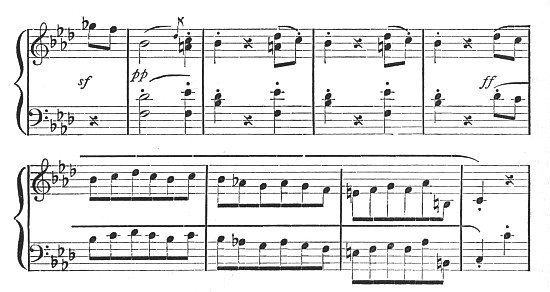
(b)
FIGURE LVIII.
Little wonder is it, then, that such a daring spirit, such [208] a hater of the timid and the droning, such a passionate lover of the individual, the striking, the bizarre, and even the grotesque, found a congenial task in infusing humor and irresponsibility into the classic minuet. This form, already the lightest part of the sonata and symphony, already consecrated to the expression of the composer's gayest and most graceful thoughts, needed only to be made plastic enough to include fantasy and banter in order to give free scope to Beethoven's most frolicsome moods. To the task of thus aerating the symphonic minuet he applied himself very early. Take, as an instance, the minuet of the very first piano sonata, opus 2, number 1. [209] As a whole it breathes the polite graciousness of Mozart. The first cadence, especially, recalls the sweetly formal manner of the old school. (See Figure LVIII(a).) Yet a moment later Beethoven begins to play with this very cadence in true scherzo fashion, like a cat with a mouse, twice pawing it gently, so to speak, and then pouncing on it with fury: ((b) in the same figure.)
In the other two sonatas bearing the same opus number he adopts the name scherzo—which is an Italian word meaning "joke" or "jest"—and with it introduces still more of the playful spirit; and as the sonatas progress we find this tendency growing, until in opus 26 and opus 28 we have full-fledged, though rather brief, examples of the real Beethoven scherzo. Let us look at these more carefully.
Beethoven: Scherzo[49] from the Twelfth Sonata, opus 26.
We note first of all that though the time-signature is three-four, as in the old minuet, the pace is much more rapid—"allegro molto"—so that a sense of bustle and restless activity is substituted for the well-bred deliberateness of the minuet. This acceleration of time is observable in most of the scherzos.
Again, the theme (measures 1-17) is of most energetic character, which is even further intensified, on its re-entrance [210]in the bass at measure 46, by a rushing accompaniment in eighth-notes.
A characteristic passage precedes this return of the theme. To make the excitement more welcome when it comes Beethoven has one of his "lulls" for sixteen measures (31-46), during which the motion dies out and all seems to stagnate for a moment. This sort of quiescence, in which one takes breath for a new access of energy, is always consummately managed by Beethoven, who has made the "lull" a famous device.
The trio calls for no particular comment. It is in binary form, while the scherzo itself is ternary.
Beethoven: Scherzo from the Fifteenth Sonata, opus 28.
The tempo is again brisk—"allegro vivace."
The theme is exceedingly whimsical: long notes jumping down through four octaves—first single notes, then thirds, then sixths—followed each time by a quaint little cadence in which the staccato touch is prominent.
The section of contrast after the double-bar (measures 33-48) takes the form of a sequence, in which the left hand part carries the original theme.
In the return of the theme we find one of those violent dynamic contrasts so beloved by Beethoven, the theme in measures 49-53 being sounded in a mild piano and then, without warning, in measures 58-61, pealed forth fortissimo in large chords.
The trio is again inconspicuous, save for its charming harmonization.
These two scherzos give a good idea of how Beethoven gives play to his whimsicality in his piano sonatas,[50] but to get the Beethoven scherzo at its highest power we must go to the symphonies. There he has all the wondrous potentialities of instrumental coloring to fire his imagination, and a canvas broad enough to afford scope for endless ingenuity. It is a fascinating study to trace out how he gradually advanced in the power to utilize all these possibilities.
The third movement of the first symphony, though called "Minuetto," is marked "allegro molto e vivace," and with its spirited theme, fascinating harmonies, and striking rhythms, is essentially a scherzo. Perhaps the most interesting single feature of it is the completely Beethovenish means adopted for getting back to the theme and the home key of C-major after the section of contrast.
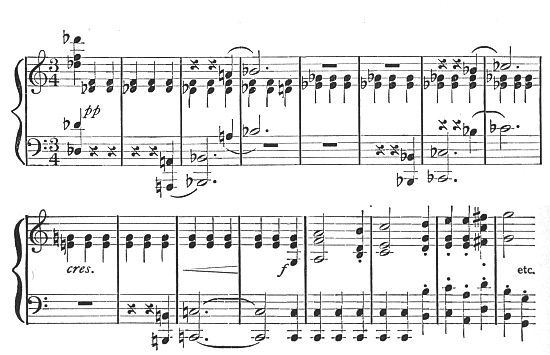
FIGURE LIX.
The passage is shown in Figure LIX, and merits careful study. From D-flat major, a key far distant from C, return is made by imperceptible degrees. At the same time there is a crescendo of power, until finally the theme breaks out vigorously in the home-key. It will be noted that the brief phrases played by the left hand in this passage are made from the first two notes of the theme itself. Thus closely does Beethoven stick to his text.
The forcible syncopated rhythms and dissonant harmonies near the end of this movement also deserve notice. They give it a rugged character strangely at variance with its title of "minuet."
In the second symphony the name scherzo is adopted, and the phials of mirth are freely opened. Sudden alternations of loud and soft are especially conspicuous, as will be seen by referring to the theme, quoted in (a) in Figure LX. Each new measure, here, brings something unexpected and deliciously piquant.
Violent shifts of accent on to ordinarily unimportant parts of the measure will be noticed in the twenty-first and twenty-fifth measures, affording relief from what might without them become monotonous.
A little later, after the reappearance of the theme, [213] Beethoven indulges in one of those passages which puzzle us and pique our curiosity (Figure LX (b).) Where is he going? we ask ourselves, what will he do next? But after a few moments' suspense, in which the music seems to be spinning about in an eddy, so to speak, it falls into the current again, and all goes cheerfully to the end.

(a)
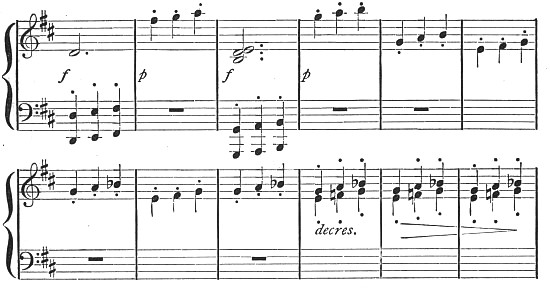
(b)
FIGURE LX.
In the trio, the student should note the whimsicality of the long hold on an F-sharp through six entire measures, pianissimo, followed by a sudden loud chord on A.
Indeed, the prankishness of the entire movement is inexhaustible.
We do not reach the full stature of the Beethoven scherzo, however, until we get to that of the third or "Eroica" symphony. In this wonderful movement we have a perfect masterpiece of irresistible, tireless, kaleidoscopic humor, a great epic of irresponsibility which must be ranked with such unique expressions of the humorous spirit in literature as Shakespeare's Falstaff plays, Sterne's "Sentimental Journey," or Stevenson's "New Arabian Nights." Well may Sir George Grove say of it, that it is "perhaps the most Beethovenish of all his compositions," and that in it "the tragedy and comedy of life are startlingly combined."
It begins with a stealthy, soft succession of staccato chords in the strings, uniformly pianissimo and yet most insistent in rhythm. Against this is presently outlined the most piquant little theme by the oboe ((a) in Figure LXI); the chords go on again, and then sounds above them once more this incisive little theme. In the contrast section after the double-bar comes first more playing with the rapid soft chords, and then a charming bit of "imitation" of the theme from one voice to another ((b) in Figure LXI). The note D is finally reached in this way, and then Beethoven, instead of making some trite and uninteresting modulation back to E-flat, whither he wishes to go in order to begin his restatement, simply goes on sounding D for ten measures, piano, and then without warning drops down to B-flat, pianissimo, for four measures, and therewith proceeds with his theme again. The mystery and charm of this return to key are indescribable; the persistent pianissimo adds much to its extraordinary effectiveness.

(a)

(b)
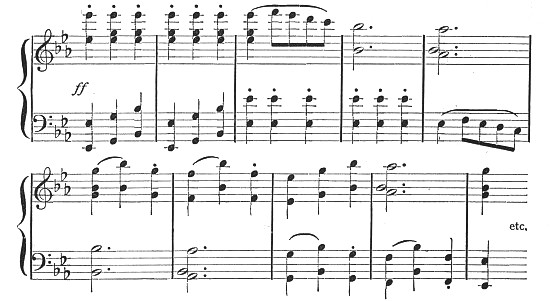
(c)
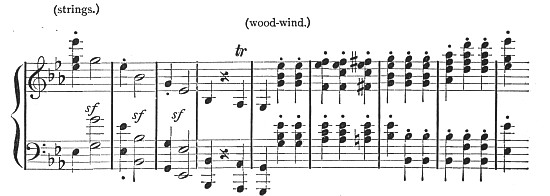
(d)
FIGURE LXI.
Now, however, with the return of the theme, we at last get a good ear-filling fortissimo, the whole orchestra [216] taking part in a vigorous game of musical tag (the theme made into a canon—(c) in Figure LXI). A fine climax is reached in a passage of bold leaping melody in the strings, in which the accents are dramatically placed on the second instead of the first beats of the measures, followed and completed by staccato chords on the wood-wind instruments ((d) in Figure LXI). This is enormously vigorous, and makes a fitting culmination for this first part of the movement, besides giving an opportunity for still greater effect later, as we shall see in a moment. After it, a cadence is soon reached, though not before the strings and wood-wind instruments have had a brief whimsical dialogue on the subject of the staccato chords.
So far all is bantering merriment, iridescent color, and energetic high spirits. But in the trio, one of the most wonderful of all Beethoven's strokes of genius, the mood changes, and while the quick three-four measure is still felt underneath, the long notes, and the deep mellow tones of the horns, give an almost tragic quality to the music. The theme, given out by three horns alone, with a brief cadence by the strings, does not reach its full stature until its recurrence near the end of the trio. In its second phrase the lowest horn reaches, and holds for two measures, a D-flat which is of almost unearthly solemnity of effect. This passage repays careful study, so wonderfully does it use the simplest means to gain the highest beauty. Sir George Grove well says of it: "If ever horns talked like flesh and blood, they do it here."
The scherzo, on its return, goes on much as at first. [217] Yet Beethoven still has one last shot in reserve, as we suggested a moment back. When he comes to that splendidly proud passage of descending leaps in the strings (Figure LXI, d.), instead of repeating it, as he did at first, in the same rhythm, he suddenly transforms it into even half notes, which crash downwards like an avalanche, quite irresistible. (See Figure LXII.) The effect is again indescribable in words; its gigantesque vigor is of a kind to be found nowhere but in Beethoven, and in him only in his inspired moments.
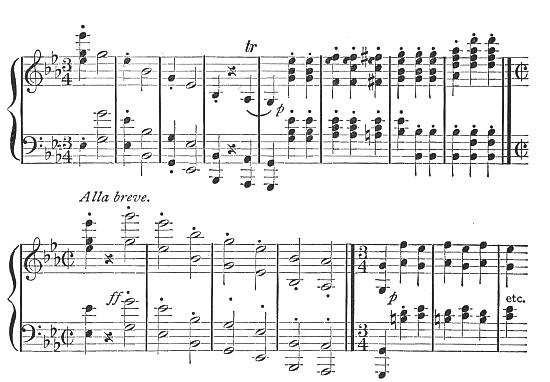
FIGURE LXII.
In this wonderful movement the Beethoven scherzo first reaches its full stature. It may be questioned whether he ever achieved anything finer.
Yet in its own way the scherzo of the Fifth Symphony[51] [218] is equally original and characteristic, and as we have already analyzed two movements of that symphony we will now make a detailed analysis of this movement too.
Beethoven: Scherzo from the Fifth Symphony.
This scherzo is interlinked with the finale, into which it is merged by a famous passage derived from the scherzo itself, and leading up from the softest pianissimo to a grand outburst of the full orchestra. We shall, however, end our analysis where this passage begins. The complete scherzo, therefore, omitting this link-passage, will have three hundred and thirty measures, which should be numbered continuously for easy reference (counting the first partial measure as one, as well as the incomplete measures at the beginning of the trio).
The theme is of a very curious character, certainly nothing like the usual bustling scherzo theme, but on the contrary mysterious, vague, groping. Berlioz says of it: "It is as fascinating as the gaze of a mesmerizer." After seventeen measures of this, a more energetic, rhythmic theme succeeds (20-45) given out by the horns, fortissimo, with rugged chords in accompaniment, in which we recognize a new variant of that motive of three short notes and a long, which was so prominent in the first movement (see Chapter XII). The remainder of the scherzo proper is worked up out of these two contrasting strains, thus: 46-71, from the first, mysterious one; 72-97, from the second, energetic one; 98-133, beginning softly in mystery [219] with the first, and later (116) continuing with it a new, more lively melody (note how the phrase of measures 3 and 4 persists in the bass all through this part); 134-141, concluding cadence, on the second strain.
The trio, measures 142 to 238, is irresistibly ludicrous in the elephantine antics through which the unwieldy double-basses are put. They announce (142-148) a scrambling fugue theme, which is "answered"—in imitation—several times at higher pitches (measures 148, 154, 156) by the other and more agile stringed instruments. A sonorous close is reached at the double bar.
Then comes a most grotesque and amusing passage, in which, three several times, these poor lumbering double basses hurl themselves upon the theme, twice only to give up in despair after the first measure and pause as if for breath. The effect of this brave attack and utter failure to "keep up the pace" is irresistibly comic. But the third time proverbially never fails, and in the measures following 168 they hold to their effort with bull-dog tenacity, and succeed in reaching a safe haven in the G of measure 173. Thereupon the theme enters once more above them, and is once more carried through an exciting fugal chase, the entrances, which the student should trace out carefully, occurring in measures 176, 180, 182, and 184, each time a little higher up. The cadence is reached in 200, and the entire passage from the inept onslaughts of the basses is almost literally repeated (200-227), except that now it becomes quieter and quieter, and finally leads back to the mysterious scherzo theme (239-257).
This time the ruggedness of the second strain of the scherzo has all disappeared, and it remains delicate, almost ethereal, through measures 258 to 330, with which the scherzo proper ends. As has been stated, no complete pause is reached before the finale, but instead of the cadence we have placed at the end, there is a long passage leading over into the splendid march-like theme of the last movement. How this passage is made out of the themes of the scherzo itself will be seen by referring to Figure LXIII.
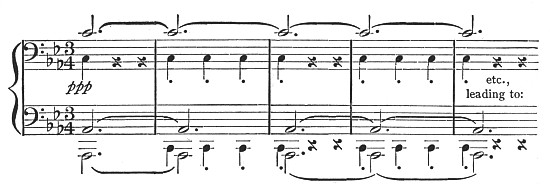

FIGURE LXIII.
With this scherzo from the Fifth Symphony we may take our farewell of Beethoven for the present, and also of the art in which he represents one of the great culminating points. After him it seemed to musicians for a while as if the triumphs of organic musical structure could no [221] further go, and they turned their attention in other directions, and sought for other kinds of interest. But to follow them on these new paths is not a part of our present undertaking.
We have now followed the continuous and unbroken course of the development of music from the most primitive sounds grouped together in rude patterns by savages, up to the symphonies of Beethoven, which must always remain among its most wonderful and perfect monuments. We have seen how all music, which has any beauty or interest, is based on certain short characteristic groups of tones called motives, and how these are made to take on variety, without losing unity, by being "imitated," "transposed," "restated after contrast," "inverted," "augmented" or "diminished," "shifted in rhythm," and otherwise manipulated. We have examined simple cases of this treatment of musical ideas in representative folk-songs. We have seen how the polyphonic style of Bach, in which these bits of melody occur everywhere throughout the tissue of the music, arose and reached its perfection. We have studied the simple dances which, adopted by the musicians of the seventeenth and eighteenth centuries, were developed by them and combined in "suites." Then, proceeding to a higher stage of artistic evolution, we have examined the various plans which composers devised for making longer pieces in which variety and unity were still able to coexist—such forms as the minuet, the theme and variations, the rondo, and the sonata-form. In conclusion, [222] we have analyzed representative examples of music composed in these typical forms during the great classical period of Haydn, Mozart, and Beethoven.
Yet all this study and analysis, which may often have seemed to the reader uselessly detailed and dully scientific, has been made with an ulterior aim in view, and unless that aim has been in some degree attained, our work has been futile indeed. The great object of musical analysis must always be to concentrate the attention of the music-lover, to focus his mind as well as his ears on the melodies, and their developments, which he hears, and so eventually to increase his pleasure in music, and to help him to substitute for that "drowsy reverie, relieved by nervous thrills," an active, joyful, vigorous co-operation with composers, through which alone he can truly appreciate their art.
That, and that alone, is the object of the analytic study of music. For what shall it profit a man if he can tell a second theme from a transition-passage, or a minuet from a set of variations, if he has not meanwhile, through this exercise, got into vital contact with the music itself? But that he can do, no matter how great his natural sensibility to sound, only by learning how to listen.
FOOTNOTES:
[48] Grove's "Beethoven and His Nine Symphonies," page 35.
[49] For convenience of reference number the measures and partial measures consecutively. There will be 69 in the scherzo proper, and 31 in the trio.
[50] The student should also study the interesting scherzo of the Eighteenth Sonata, which is not in minuet form but in regular sonata-form. It is carried out with immense spirit.
[51] The Fourth Symphony has again, like the First, a minuet, though a most active one.
NOVELLO & CO.'S
Music Primers and Educational Series
EDITED BY
JOHN STAINER and C. HUBERT H. PARRY
A Complete Library in Itself
| 1. | The Pianoforte E. Pauer | $1.00 |
| 2. | The Rudiments of Music W. H. Cummings | .50 |
| 3. | The Organ J. Stainer | 1.00 |
| 4. | The Harmonium King Hall | 1.00 |
| 5. | Singing (Paper boards, $2.50) A. Randegger | 2.00 |
| 6. | Speech in Song (Singer's Pronouncing Primer) A. J. Ellis, F. R. S. | 1.00 |
| 7. | Musical Forms E. Pauer | .75 |
| 8. | Harmony J. Stainer | .75 |
| 9. | Counterpoint J. F. Bridge | .75 |
| 10. | Fugue James Higgs | 1.00 |
| 11. | Scientific Basis of Music W. H. Stone | .50 |
| 12. | Double Counterpoint J. F. Bridge | 1.00 |
| 13. | Church Choir Training Rev. J. Troutbeck | .50 |
| 14. | Plain Song Rev. T. Helmore | 1.00 |
| 15. | Instrumentation E. Prout | .75 |
| 16. | The Elements of the Beautiful in Music E. Pauer | .50 |
| 17. | The Violin Berthold Tours | .75 |
| 18. | Tonic Sol-fa J. Curwen | .50 |
| 19. | Lancashire Sol-fa James Greenwood | .50 |
| 20. | Composition J. Stainer | 1.00 |
| 21. | Musical Terms Stainer and Barrett | .50 |
| 22. | The Violoncello Jules de Swert | 1.00 |
| 23. | Two-part Exercise (396) James Greenwood | .50 |
| 24. | Double Scales Franklin Taylor | .50 |
| 25. | Musical Expression Mathias Lussy | 1.50 |
| 26. | Solfeggi (Paper boards, $2.50) Florence Marshall | 2.00 |
| 27. | Organ Accompaniment J. F. Bridge | 1.00 |
| 28. | The Cornet H. Brett | 1.00 |
| 29. | Musical Dictation. Part I. Dr. Ritter | .50 |
| 30. | Musical Dictation. Part II. Dr. Ritter | 1.00 |
| 31. | Modulation James Higgs | 1.00 |
| 32. | Double Bass A. C. White | 1.50 |
| 32A. | Appendix to Double Bass A. C. White | 1.50 |
| 33. | Extemporization F. J. Sawyer | 1.00 |
| 34. | Analysis of Form H. A. Harding | 1.00 |
| 35. |
500 Fugue Subjects and Answers A. W. Marchant (Paper boards, $3.00) |
1.50 |
| 36. | Hand Gymnastics T. Ridley Prentice | .75 |
| 37. | Musical Ornamentation. Part I. E. Dannreuther | 2.50 |
| 37A. | Musical Ornamentation. Part II. (Paper boards, $3.00) E. Dannreuther | 2.50 |
| 38. | Transposition J. Warriner | 1.00 |
| 39. | The Art of Training Choir Boys G. C. Martin | 1.50 |
| 39A. | Double. (Exercises only) G. C. Martin | .50 |
| 40. | Biographical Dictionary of Musicians W. H. Cummings | 1.00 |
| 41. | Examples in Strict Counterpoint. Part I. Gordon Saunders | 1.50 |
| 41A. | Examples in Strict Counterpoint. Part II. Gordon Saunders | 1.50 |
| 42. | Summary of Musical History C. H. H. Parry | 1.00 |
| 43. | Musical Gestures J. F. Bridge | 1.00 |
| 43A. | Rudiments in Rhyme J. F. Bridge | .35 |
| 44. | Basses and Melodies Ralph Dunstan | 1.25 |
| 45. | First Steps at the Pianoforte. Francesco Berger | 1.25 |
| 46. | A Dictionary of Pianists and Composers for the Pianoforte E. Pauer | 1.00 |
| 47. | Organ Pedal Technique. Part I. B. W. Horner | 1.00 |
| 47A. | Organ Pedal Technique. Part II. B. W. Horner | 1.00 |
| 48. | Twelve Trios by Albrechtsberger A. W. Marchant | .75 |
| 49. | Fifty Three-part Studies J. E. Vernham | .75 |
| 50. | Choral Society Vocalisation J. Stainer | 1.00 |
| 50A. | Choral Society, the Exercises arranged and adapted for Female Voices A. W. Marchant | .75 |
| 51. | Two-part Solfeggi James Higgs | .50 |
| 52. | Short History of the Pianoforte A. J. Hipkins | 1.25 |
| 53. | Scales and Arpeggios Franklin Taylor | 1.00 |
| 54. | Sonata-Form W. H. Hadow | 1.25 |
| 55. | A Dictionary of Violin Makers C. Stainer | 1.25 |
| 56. |
The Forty-eight Preludes and Fugues of J. S. Bach (or in 4 parts, 50 cents each) F. Iliffe |
1.50 |
| 57. | Appendix to "Analysis of Form" H. A. Harding | .25 |
| 58. | Harmonization of Melodies J. E. Vernham | .50 |
| 59. | "Braille" Music Notation (Boards) E. Watson | 3.75 |
| 60. | Five-part Harmony F. E. Gladstone | 1.00 |
| 61. | The Viola Berthold Tours | 1.00 |
| 62. | Harmonics and Resultants C. E. Lowe | .50 |
| 63. | Breathing for Voice Production (Cloth) H. H. Hulbert | 1.00 |
| 64. | The Choir-boy's Elements of Music G. J. Bennett | .50 |
| 65. | First Steps for the Violin E. Kreuz | .75 |
| 65A. |
First Steps for the Violin, Part II. The pieces for Violin, with Pianoforte accompaniment E. Kreuz |
1.25 |
| 66. | Score-Reading Exercises Emily R. Daymond | .75 |
| 66A. | Ditto. Book II Emily R. Daymond | .75 |
| 67. | A Method of Singing J. Stockhausen | 2.00 |
| 68. | A Treatise on Strict Counterpoint. Part I F. E. Gladstone | .75 |
| 69. | A Treatise on Strict Counterpoint. Part II F. E. Gladstone | .75 |
| 70. | Examination Questions and How to Work Them Cuthbert Harris | 1.00 |
| 71. | Voice Culture for Children. Part I. Instructions James Bates | .75 |
| 72. | Voice Culture for Children. Part 11. Exercises James Bates | .75 |
| 73. |
Voice Culture for Children. Part III. Appendix James Bates (The 3 Parts complete) 1.75 Paper Boards, $2.25) |
.30 |
| 73A. | Voice Culture for Children in Tonic Sol-fa Notation James Bates | .15 |
| 74. | The Choir-boy's Guide to the Cathedral Psalter Ernest Newton | .35 |
| 75. | Twelve Elementary Duets for Pianoforte Emma Mundella | .50 |
| 76. | Harmony for Schools F. E. Gladstone | 1.25 |
| 77. | Key to ditto | .75 |
| 78. | Elementary Score Reading A. H. Peppin | .75 |
| 79. | Figured-Bass Playing J. R. Tobin | .75 |
| 80. | Tenor Voice Exercises E. D. Palmer | .50 |
| 81. | Three-part Studies Hugh Blair | .35 |
| 82. | Music in its Relation to the Intellect and the Emotions John Stainer | .50 |
| 83. | A Military Band Primer George Miller | 1.00 |
| 84. | Equal Temperament H. Spain | .50 |
| 85. | Guide to Solo Singing G. Garcia | 1.00 |
| 86. | Theory of Music J. A. O'Neill | .50 |
| 87. | Self-help for Singers D. C. Taylor | 1.00 |
Any of the above may be had strongly bound in boards, price 25 cents each extra, with the exception of Nos. 5, 26, 37, 37a and 56, which are 50 cents each extra, and Nos. 43a, 47a, 51, 57, 65, 65a, 66, 66a, 73, 77, 79, 80, 81, 84 and 86, which are only published in paper covers.
School Libraries and Conservatories supplied at a special price.
H. W. GRAY CO., 2 West 45th Street, New York
SOLE AGENTS FOR
NOVELLO & CO., LIMITED
TRANSCRIBER'S NOTES:
A number of words in this book have both hyphenated and non-hyphenated variants. It was also detected that some words have two different spellings, both of which are correct. For the words with both variants present the one used more times has been kept.
Obvious punctuation and other printing errors have been corrected.
It was noted that the label FIGURE XXXVIII was used in two different places in the original book. The label was used in page 124 and in page 132 of the original. In this transcription the latter was changed to FIGURE XXXVIIIa. The reference made in the text to the latter figure was consistently changed to take into account the modification made.
During the formatting process some of the tables have been transposed from their original lay-out due to their width. This was done to avoid excessively long lines or unsupported display.
The musical examples that are discussed in the book can be heard by clicking on the [Listen] tab. This is only possible in the HTML version of the book. The scores that appear in the original book have been included as images.
In some cases the scores that were used to generate the music files differ slightly from the original scores. Those differences are due to modifications that were made during the process of creating the musical archives. These modifications were made to correct obvious mistakes in the original scores, to indicate times and to make musical notation more consistent with criteria currently used. These scores are included as png images, and can be seen by clicking on the [PNG] tag in the HTML version of the book.